Notícias do Mercado
-
23:31
EUR/USD Price Analysis: Eyes two-month high at 1.0200 amid hawkish ECB bets
- The shared currency bulls have shifted into a positive trajectory after climbing above parity.
- Investors are underpinning the euro bulls as hawkish ECB bets soar.
- Advancing 20-EMA adds to the upside filters.
The EUR/USD pair is displaying back-and-forth moves in a narrow range of 1.0073-1.0088 in the early Asian session. The asset has turned sideways after a perpendicular rally as positive market sentiment improved demand for risk-perceived currencies.
The major is expected to remain in the grip of bulls ahead of the interest rate decision by the European Central Bank (ECB). As per the projections, ECB President Christine Lagarde may announce a rate hike by 75 basis points (bps).
The US dollar index (DXY) plunged further on Wednesday to near 109.60 as the appeal for safe-haven assets trimmed dramatically. Also, the alpha generated by 10-year US government bonds plummeted to 4%.
On a four-hour scale, the shared currency bulls have strengthened after shifting their business above the horizontal support placed around October highs at parity, which has become a support now. Now, the euro bulls are eyeing to smash a two-month high at 1.0200 ahead.
The 20-period Exponential Moving Average (EMA) at 0.9950 is aiming higher, which adds to the upside filters.
Meanwhile, the Relative Strength Index (RSI) (14) has shifted into the bullish range of 60.00-80.00, which indicates more upside ahead.
A minor corrective move to near September 20 high at 1.0051 will be a bargain buy for the market participants. This will send the asset firmly towards August 3 low at 1.0123, followed by a two-month high at 1.0200.
On the flip side, the greenback bulls will grab attention if the asset drops below October 25 low at 0.9848. It may drag the asset toward October 20 low at 0.9755 and Friday’s low at 0.9705.
EUR/USD four-hour chart
-638024202216793548.png)
-
23:06
AUD/JPY Price Analysis: Conquers the 50-day EMA, reclaims 95.00 on upbeat mood
- AUD/JPY has climbed for two-straight days after the Bank of Japan (BoJ) intervention and is up by 0.87% in the week.
- The AUD/JPY daily chart is upward-biased, and if it clears 95.44, a retest of 96.40 is on the cards, ahead f the YTD high at 98.60.
The AUD/JPY rebounded at the 50-day Exponential Moving Average (EMA) and rose to Wednesday’s daily high at 95.44 before trimming some gains. However, the cross-currency finished the day with a half-percentage point gain. As the Thursday Asian Pacific session begins, the AUD/JPY is trading at 95.03, flat.
AUD/JPY Price Analysis: Technical outlook
The AUD/JPY daily chart delineates the pair trading upwards, as the upward bias remains intact. Worth noticing that on its way toward 95.00, the cross-currency pair cleared the 50-day EMA, shifting the bias from neutral-upwards to upwards, opening the door for further gains. Also, the Relative Strength Index (RSI) is in bullish territory, and the slope turned flat, meaning that the AUD/JPY might consolidate before resuming the ongoing uptrend.
Upwards, the AUD/JPY’s first resistance would be October’s 26 daily high at 95.44, followed by the 96.00 figure, and the September 22 daily high at 96.40. Conversely, the AUD/JPY’s first support would be the 50-day EMA at 94.64. A breach of the latter will send the cross sliding towards the 100-day EMA at 94.17, followed by the 20-day EMA at 93.45.

AUD/JPY Key Technical Levels
-
22:57
Gold Price Forecast: XAU/USD displays lackluster performance above $1,660 ahead of US GDP data
- Gold price is juggling around $1,665.00 as investors await US GDP data.
- Positive market sentiment has punished US Treasury yields and the DXY.
- A decline in New Home Sales data has also weighed pressure on the DXY.
Gold price (XAU/USD) has turned sideways around $1,665.00 in the early Tokyo session as investors are awaiting the release of the US Gross Domestic Product (GDP) data. The precious metal witnessed a gradual decline in the late New York session after failing to sustain above $1,670.00.
Market sentiment remained upbeat despite the S&P500 failure to continue its three-day winning streak after tech-giant Microsoft (MSFT) provided weak guidance on sales growth. The US dollar index (DXY) witnessed a steep fall and dropped to near 109.50. Also, the 10-year US Treasury yields witnessed selling pressure and dropped to the psychological support of 4%.
Lower New Home Sales data against its prior release also weighed pressure on the DXY. The households have purchased 0.603M new houses vs. the prior release of 0.677M due to soaring interest obligations led by the extremely hawkish Federal Reserve (Fed)’s monetary policy.
Going forward, the US GDP data will hog the limelight. The annualized GDP is expected to improve significantly to 2.4% vs. a decline of 0.6% reported earlier. This week, the PMIs reported by S&P remained downbeat. Therefore, the placement of the GDP figures around the projections will be worth watching.
Gold technical analysis
On an hourly scale, the gold prices have corrected minutely after testing the supply zone placed in a narrow range of $1,671.17-1,672.70. The 20-period Exponential Moving Average (EMA) at $1,633.16 is acting as major support for the counter.
The Relative Strength Index (RSI) (14) has dropped from the bullish range of 60.00-80.00, however, the upside bias is still solid.
Gold hourly chart
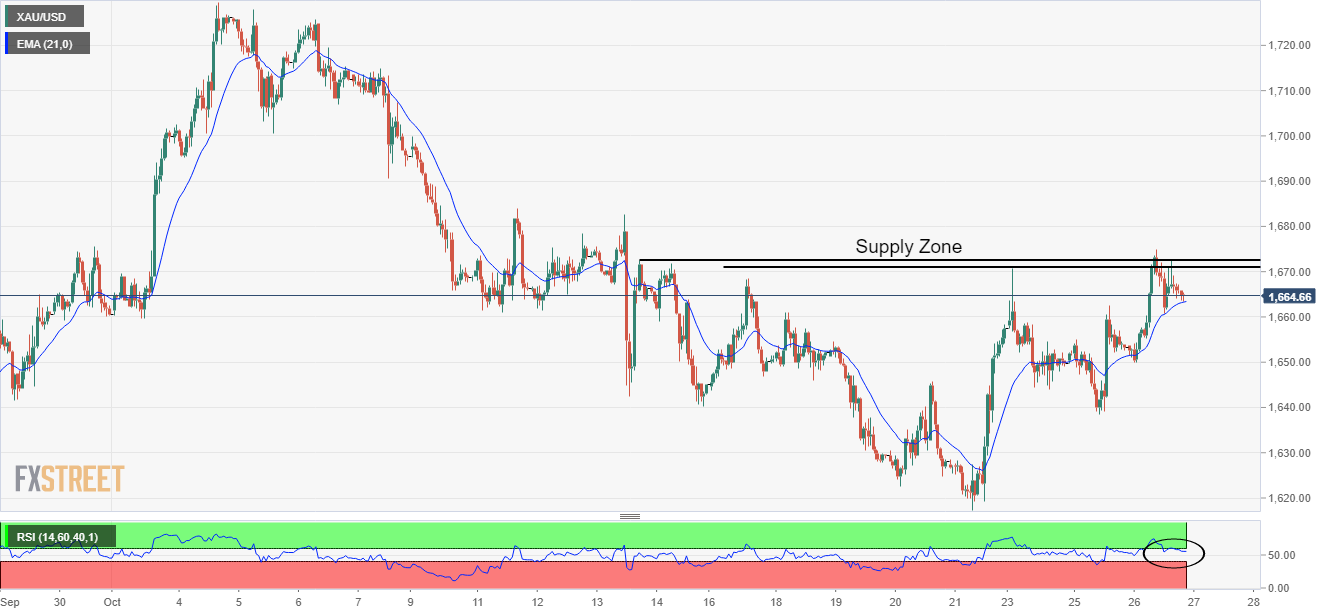
-
22:52
USD/CAD Price Analysis: Bulls are lurking at key MTF support areas
- USD/CAD bulls are lurking at key support structures.
- The US dollar bulls could be about to move back in.
USD/CAD bears moved in following an initial spike on the back of the Bank of Canada, but as the less dovish hike's implications began to sink in, the loonie firmed from a peak formation vs the greenback.
The US dollar is now at a crossroads as per the DXY chart below, but should the bulls hold onto the front side of the trendline, then that would be expected to fuel a bid back into USD/CAD, that has, after all, broken its hourly structure as the following analysis will show:
DXY daily chart

If the dollar recovers this week, with the European Central Bank on Thursday and US PCE Friday, then the downside in the CAD will be on play on the back side of H1 USD/CAD's trendline:
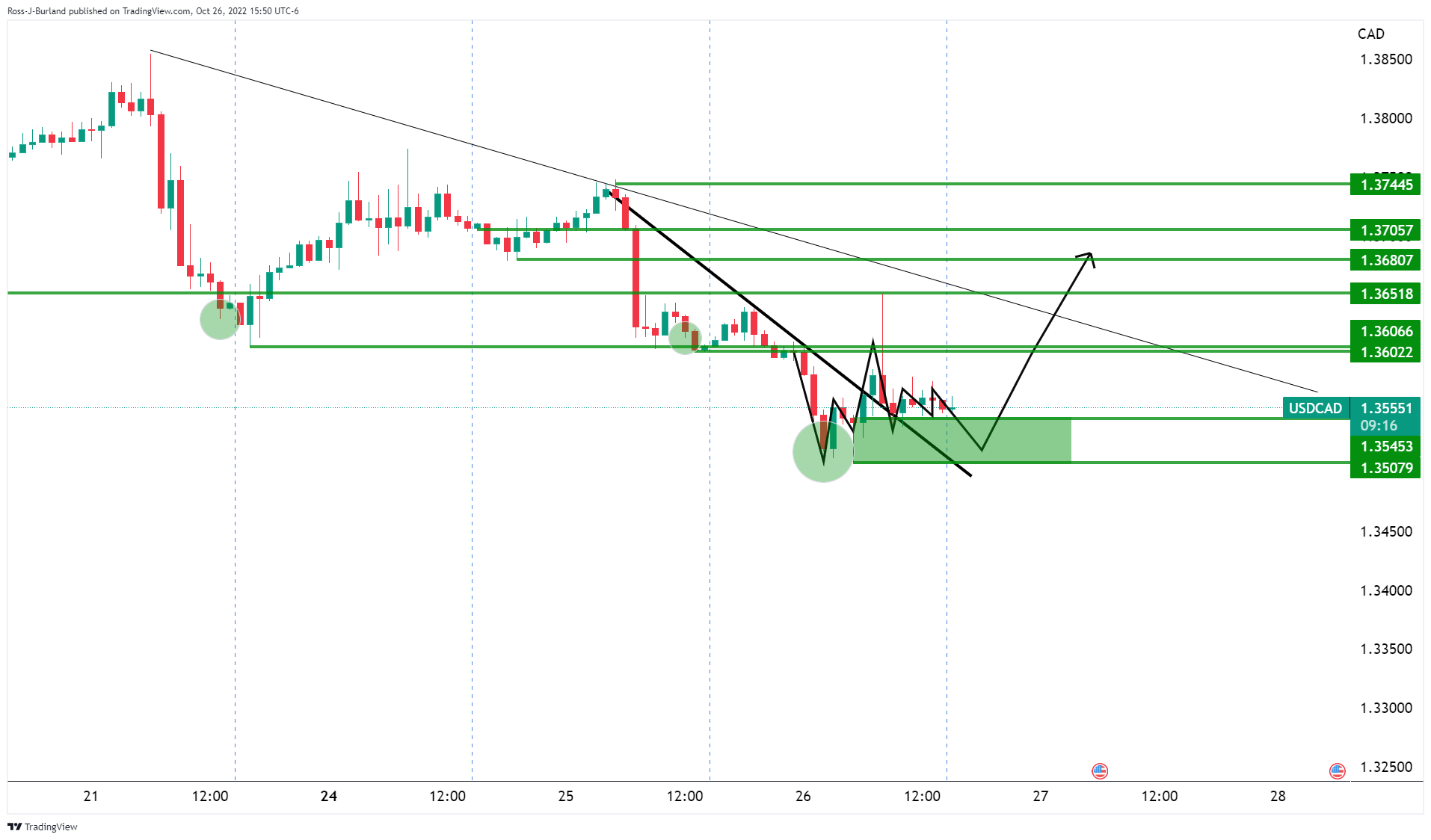
USD/CAD weekly & daily charts
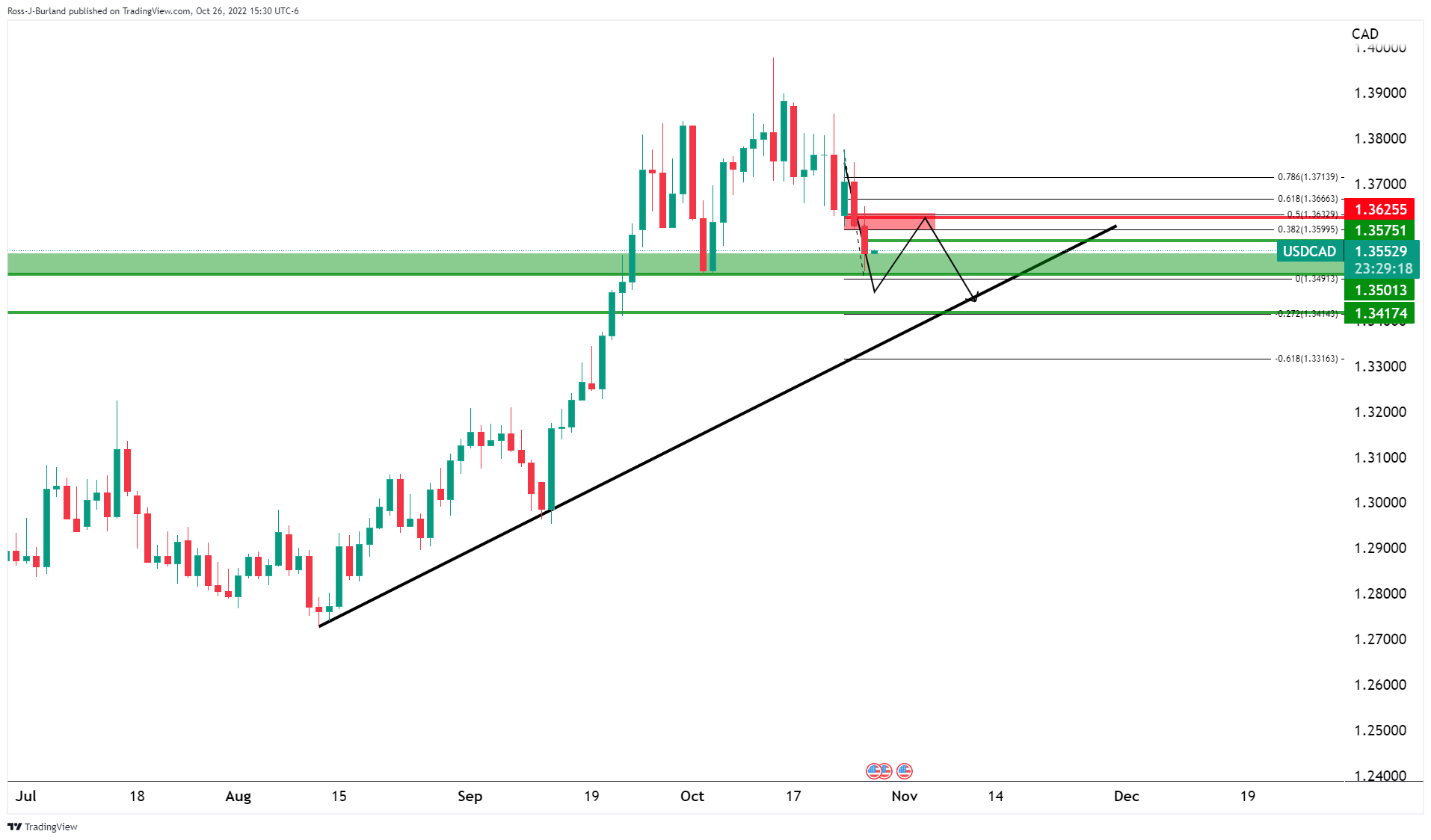
The daily chart, above, could be on the verge of a correction...and the weekly chart's M-formation is compelling from support:

-
22:32
EUR/JPY Price Analysis: Euro clings above 147.00 as a negative divergence emerges
- The EUR/JPY extends its rally to three consecutive days of gains, up 1.37% in the week.
- A negative divergence between EUR/JPY price action and RSI in the daily chart opens the door for further downside.
- Short term, the EUR/JPY is subdued, trapped in the 146.60-147.72 range
The EUR/JPY edged higher during Wednesday’s trading session, courtesy of mixed market sentiment, helping the Japanese Yen to curtail earlier losses, though it finished with gains of 0.11%. As the Asian Pacific session begins, the EUR/JPY is trading at 147.55, down by a minuscule 0.04%.
EUR/JPY Price Analysis: Technical outlook
The EUR/JPY daily chart illustrates the pair as neutral to upward biased, though it’s important to point out that price action is registering higher highs, while the Relative Strength Index (RSI) is not. Therefore, a negative divergence might be forming, which has negative implications for the Euro. However, the EUR/JPY needs to tumble below the October 25 daily low at 146.62, followed by a break below the October 24 daily open at 145.64; otherwise, upside risks remain. On the flip side, if the EUR/JPY extends its gain and the RSI clears the previous peak at 70.82, a challenge of the YTD highs at 148.40 is on the cards.
In the short term, the EUR/JPY hourly chart illustrates a shrinking price action, followed by the last Friday’s and Monday’s interventions by the Bank of Japan (BoJ), as the EUR/JPY seesawed in a wide range of 400 pips between the high/low of the day. So in the last couple of days, the EUR/JPY is range bound, fluctuating between the 146.60-147.72 range.
Key resistance lies at the top of the range around 147.72, which, once broken, the EUR/JPY can rally towards the R1 daily pivot at 147.82. The break above will expose the R2 pivot level at 148.17, followed by the R3 daily pivot at 148.61.
On the flip side, the EUR/JPY first demand zone will be the 20-Exponential Moving Average (EMA) at 147.49, followed by the 50-EMA at 147.30 and the 100-EMa at 147.00 flat.
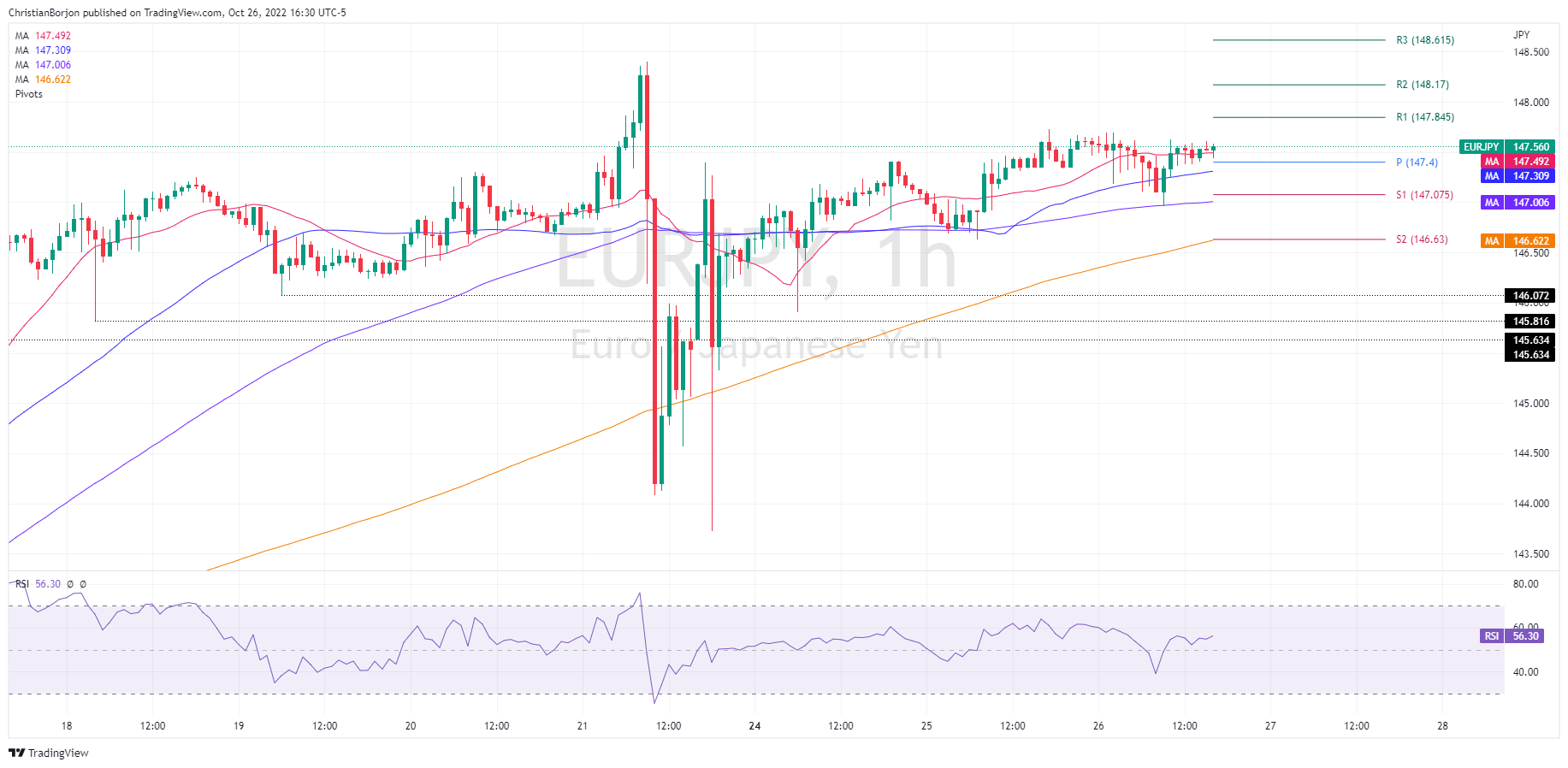
EUR/JPY Key Technical Levels
-
21:56
RBNZ Orr: We have our eyes firmly focused on meeting our inflation target
The governor of the Reserve Bank of New Zealand Adrian Orr said the nation is relatively well-positioned, but argued that inflation remains excessive in absolute terms and that global economic challenges are large and imminent.
Key comments
- It is highly unlikely that we are at maximum sustainable employment if inflation is still high and variable
- New Zealand's financial system remains well-placed to support the economy.
- We have our eyes firmly focused on meeting our inflation target.
More to come...
-
21:08
Forex Today: Gear up for another volatile day
What you need to take care of on Thursday, October 27:
Another moved journey ended with the American dollar plummeting against its major rivals. The EUR/USD pair reclaimed parity and approaches 1.0100 ahead of the release of the preliminary estimate of the Q3 US Gross Domestic Product and the European Central Bank monetary policy decision.
GBP/USD trades at around 1.1630, despite some fiscal turmoil in the UK. On Wednesday, Chancellor Jeremy Hunt announced the medium-term budgetary plan will be delayed to November 17. The new government is struggling with a fiscal hole of around £35 billion. The delay was discussed with Bank of England Governor Andrew Bailey, according to Hunt. The BOE will announce its monetary policy decision next week, and market players are quickly reducing their bets on another large rate hike.
Meanwhile, news from China indicated that the country put Wuhan under partial lockdown, where the coronavirus started.
The Canadian dollar was the worst performer vs the greenback. The Bank of Canada hiked its benchmark interest rate by 50 bps, missing the market’s expectation of a 75 bps to 3.75%. Policymakers noted mounting concerns about a potential global economic downturn were behind such a decision. USD/CAD trades around 1.3560.
AUD/USD, on the other hand, surged towards 0.6500, despite worrisome Australian inflation levels.
The USD/JPY pair kept easing, now trading around 146.30, while USD/CHF declined to 0.9864.
Spot gold is up, now at $1,665 a troy ounce, while crude oil prices surged, with WTI changing hands at $88.10 a barrel.
Wall Street closed mixed near its daily opening, trimming early gains. Nevertheless, the greenback remained pressured amid easing government bond yields.
Thursday will be quite a busy day, as the US is expected to report that the economy grew in the three months to September. The preliminary estimate of the Q3 Gross Domestic Product is foreseen at 2.4%, reversing the negative trend from the previous two quarters. It will also mean the country is no longer in a technical recession and could be read as an opportunity for the US Federal Reserve to maintain the aggressive tightening pace, giving the dollar some room to recover. The country will also release September Durable Goods Orders, seen up by a modest 0.6%.
At the same time, the European Central Bank will announce its latest monetary policy decision. The central bank is expected to hike rates by 75 bps, accompanied by a dovish message, as it seems unlikely President Christine Lagarde and Co. will keep raising rates at such an outstanding rate.
Like this article? Help us with some feedback by answering this survey:
Rate this content -
21:02
USD/JPY extends losses to levels near 146.00
- The dollar dives below 147.00 and approaches 146.00.
- Hopes of a Fed pivot have sent the US dollar tumbling.
- USD/CHF to consolidate between 144.00 and 152.00 – UOB.
The US dollar depreciated for the second consecutive day on Wednesday, breaking below 147.00 to reach levels right above 146.00, the area where the pair bottomed after the suspected BoJ interventions.
Fed pivot expectations are hurting the greenback
The greenback continues depreciating across the board, weighed by increasing expectations that the Federal Reserve might be contemplating slowing down its tightening pace over the next months.
The market is still pricing a 75 basis point hike next week, but the odds for December have been downgraded to a 0.50% rate hike. The mounting evidence that the aggressive tightening cycle is starting to bite into economic growth is adding pressure on the central bank to soften the monetary normalization plan.
US Treasury bonds retreated further on Wednesday. The 10-year yield has reached the 4.00% area, from 4.25% at the beginning of the week, which added negative pressure on the US dollar.
USD/JPY: Downside, contained at 144.00 – UOB
FX analysts at UOB maintain the consolidative view on the pair, with downside attempts limited at 144.00: “We continue to hold the same view as yesterday (25 Oct, spot at 148.80). As highlighted, the recent volatile price actions have resulted in a mixed outlook. Further volatility is not ruled out and USD could trade within a wide range of 144.00/152.00 for the time being.”
Technical levels to watch
-
21:02
GBP/USD Price Analysis: Bulls eye 1.1750s, but bears are ready to pounce
- GBP/USD bulls take charge mid-week on risk-on sentiment.
- The bears are lurking at the critical weekly structure.
GBP/USD bulls are taking charge following a significant rally mid-week that has left the emphasis, for the near term, on a correction, but with the risk of a continuation towards weekly structure as the following technical analysis across multi-timeframe charts will illustrate:
GBP/USD weekly chart
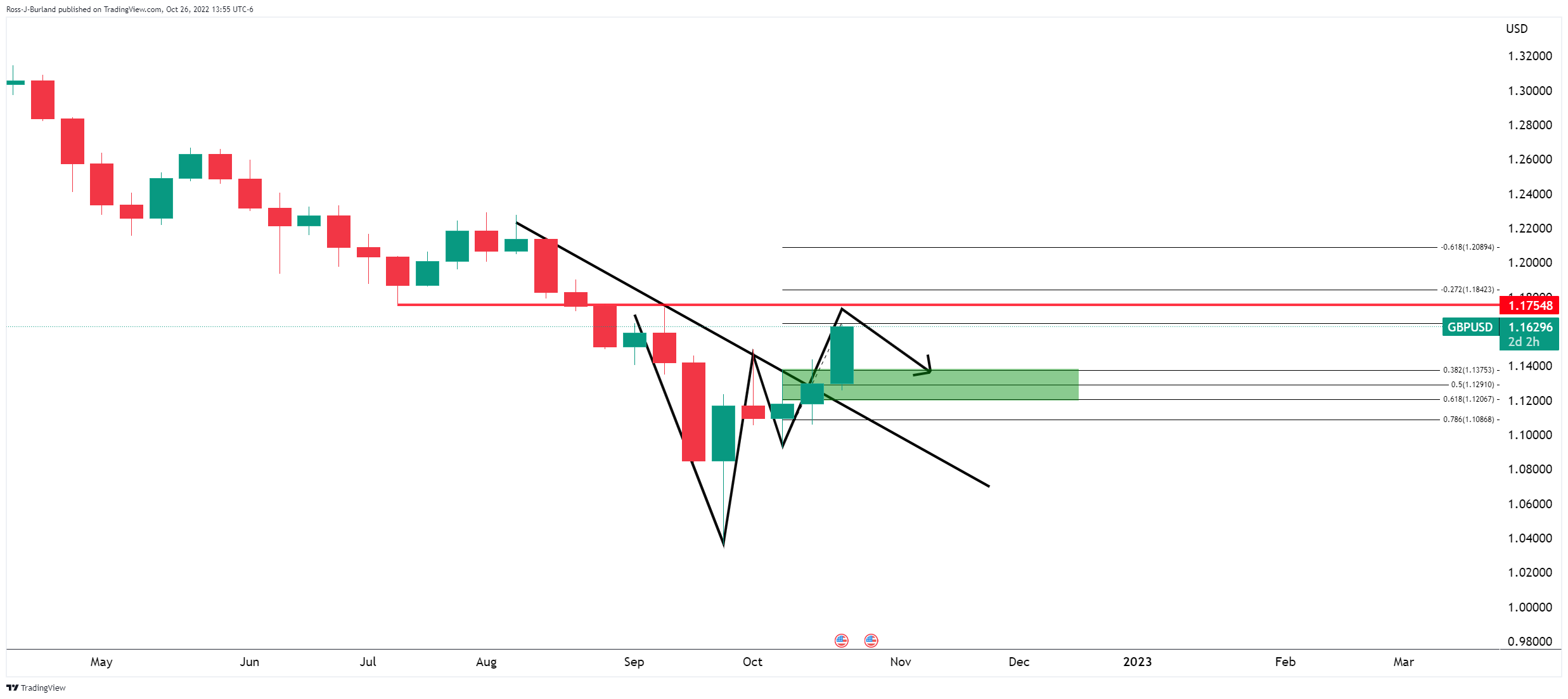
The weekly chart shows that the price could move in on the 1.1750s before the week is out but the W-formation is a bearish reversion pattern.
GBP/USD daily charts
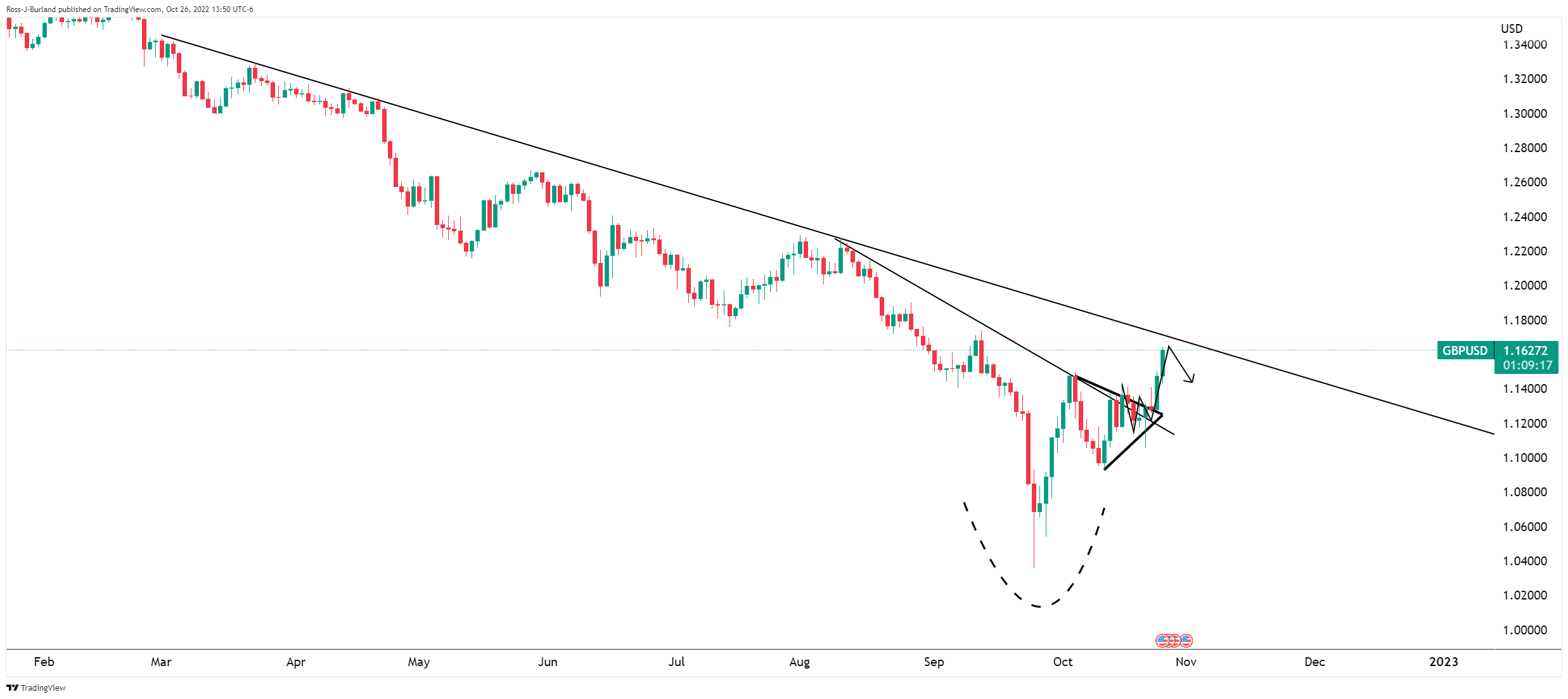
The price rallied out of a micro daily symmetrical triangle following the peak formation in a V-bottom. However, the W-formation, which we will go into more detail below, is a bearish reversion pattern as the price heads towards a more dominant trendline resistance:
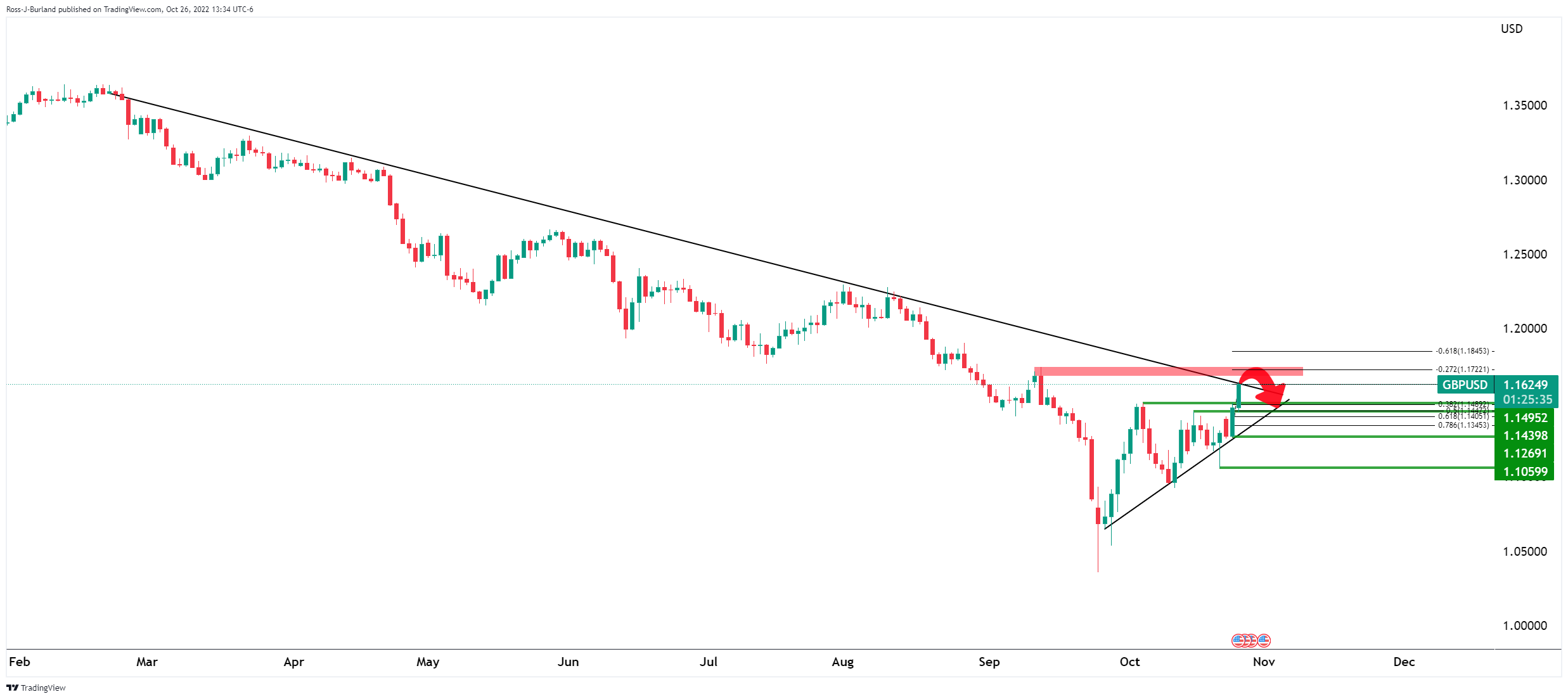
While on the front side of this major trendline, the outlook remains bearish:
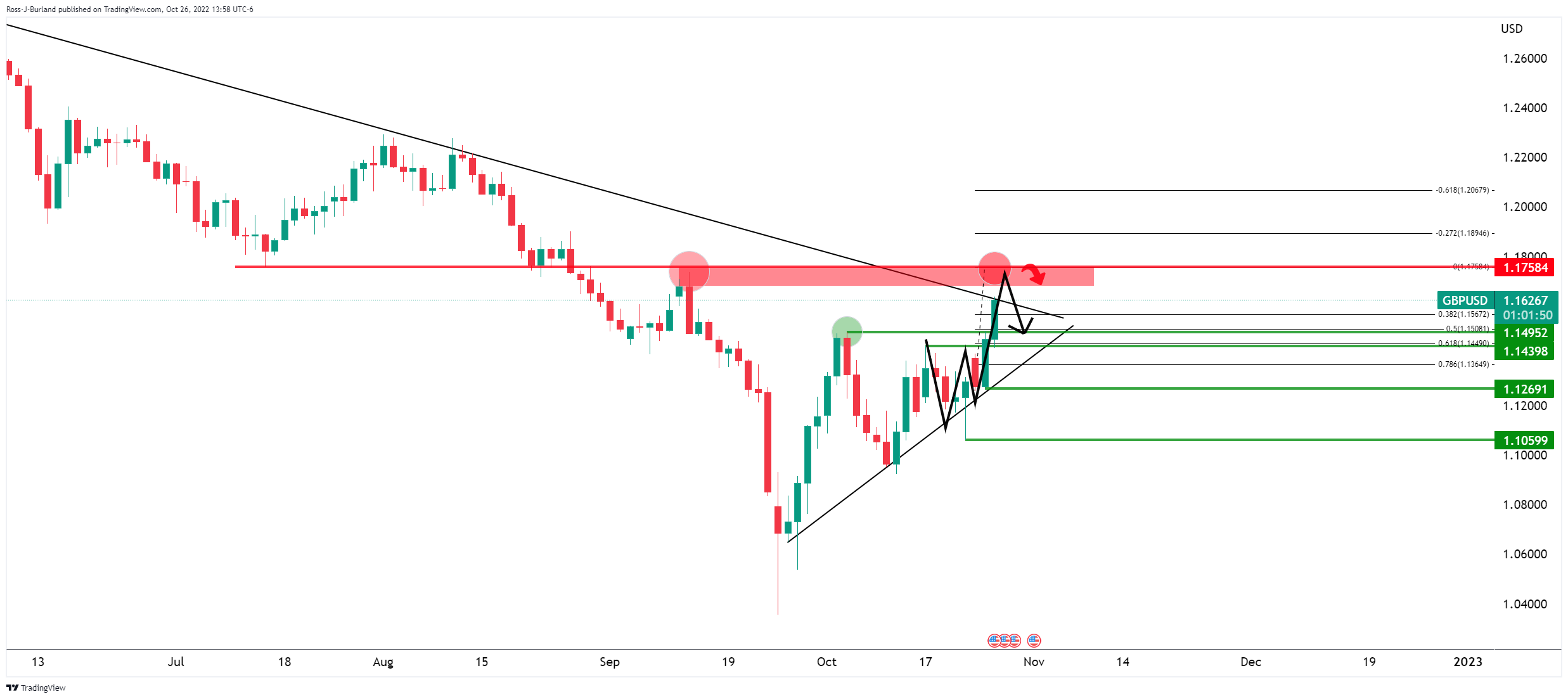
The W-formation is troubling, but a move-in to test the September highs is on the cards prior to a move into the neckline of the reversion pattern as illustrated above. Such a move would be consistent with putting heat onto in-the-money long positions built up over the week in three days of higher highs. The Fibonacci has been drawn from a hypothetical high that marries the September highs. A move into the neckline of the W-formation based on such a measurement will have a confluence with the 50% mean reversion before the 61.8% Fibo on a break below 1.1450. A break of the trendline resistance opens risk of a break of 1.1270 and then a really significant 1.1060 area.
-
20:55
NZD/USD climbs sharply, eyeing the 50-DMA around 0.5880 as the US Dollar slide prolongs
- NZD/USD is rallying more than 100 pip on Fed pivot commentary.
- September’s overall US housing data weigh on the US Dollar, as shown by the US Dollar Index, down 2% in the week.
- The NZ Business confidence missed estimates, as companies’ worries about inflation persist; forecasts of an RBNZ 75 bps rate hike jumped.
The New Zealand Dollar is advancing for the second straight day vs. the buck amidst a mixed market mood, while the US Dollar free-fall continued while the NZD got a lift from Wednesday’s Australian CPI report, which underpinned the AUD. At the time of writing, the NZD/USD is trading at 0.5831, above its opening price by almost 2%.
Expectations for a Federal Reserve pivot undermine the greenback. US Treasury yields tumbled across the curve, with the 10-year benchmark note rate down seven bps, at 3.034%, headwinds for the buck. The US Dollar Index, a gauge of the greenback’s value vs. a basket of peers, drops 1.05%, sitting at 109.726.
In the week, US housing economic data remains at the center of the US economic docket. New-Home Sales for September fell by 10.9% MoM, less than a contraction of 15%, as home buyers remain scared by higher borrowing costs, with mortgage rates lifting by 7.16% due to the Fed’s aggression. The lack of Fed officials crossing newswires due to the blackout period ahead of the next week’s monetary policy decision keeps investors speculating on the outcome of the discussions regarding December’s decision.
Meanwhile, the November Federal Reserve Open Market Committee (FOMC) meeting has fully priced in an 89.3% chance for a 75 bps rate hike, lower than the previous day’s 96.2%. Concerning December’s meeting, odds for a 50 bps increased from 47.4% on Tuesday to 55.3% as investors repriced the pace of hikes.
Aside from this, during Wednesday’s Asian session, the New Zealand Business Confidence for October missed estimates, dropping to 42.7, sinking more than the previous month’s reading of -36.7. According to Westpac analysts, the low level of business confidence isn’t a surprise even though spending levels in the economy are stead, rising costs and staff shortages oppose difficult challenges to hurdle.
The survey mentioned that inflation is the focal point, and Westpac analysts foresee another 75 bps rate hike from the Reserve Bank of New Zealand (RBNZ) at the upcoming meeting in November,
Therefore, due to a possible Fed pivot, the NZD/USD might continue to edge higher unless Friday’s US PCE registers a higher reading, which could deter Fed officials from pivoting, opening the door for further NZD/USD downward pressures.
NZD/USD Key Technical Levels
-
20:26
EUR/GBP trims losses, but remains capped below 0.8700
- The euro remains negative on the day, capped below 0.8700.
- The Sunak effect keeps supporting the pound's rally.
- EUR/GBP expected to appreciate towards 0.9000 – SocvGen.
The euro ticked up from the one-week lows at 0.8645 witnessed earlier on Wednesday, although it remains negative on the daily chart. Bullish attempts are capped below 0.8700 and the pair consolidates losses after retreating from 0.8770 highs earlier this week.
The pound maintains the positive tone
Sterling remains moderately bid, still buoyed by the positive market reaction to Rishi Sunak becoming UK’s Prime minister and his pledge to restore economic stability. The delay of a keenly awaited fiscal plan, which was due on October 31, to mid-November has not dented investor’s appetite for the pound, which has rallied to fresh six-week highs against the US dollar
The euro, however, has managed to trim losses with all eyes on the European Central Bank’s monetary policy decision, due on Thursday. The bank is widely expected to hike rates by 75 basis points for the second consecutive time, which has offered some support to the euro.
EUR/GBP is seen appreciating towards 0.90 – SocGen
Kit Juckes, Chief Global FX Strategist at Société Générale sees the pair returning to 0.90: “With the economy surely already in recession and set to suffer from possibly even tighter fiscal policy, sterling is unlikely to enjoy much more of a relief bounce and over time, EUR/GBP is likely to meander slowly up to 0.90 or so.”
Technical levels to watch
-
20:17
AUD/USD Price Analysis: Bears lurking at a critical resistance juncture
- AUD/USD bulls are moving in on a critical area of resistance.
- Key supports are located at 0.6450, 0.6390 and 0.6270 while the markets bearish below 0.6550.
AUD/USD rallied on the back of strong Aussie inflation data on Wednesday and capitulation of the US dollar bulls with the market headed for a test of the key support structure in the DXY and US 10-year yields:
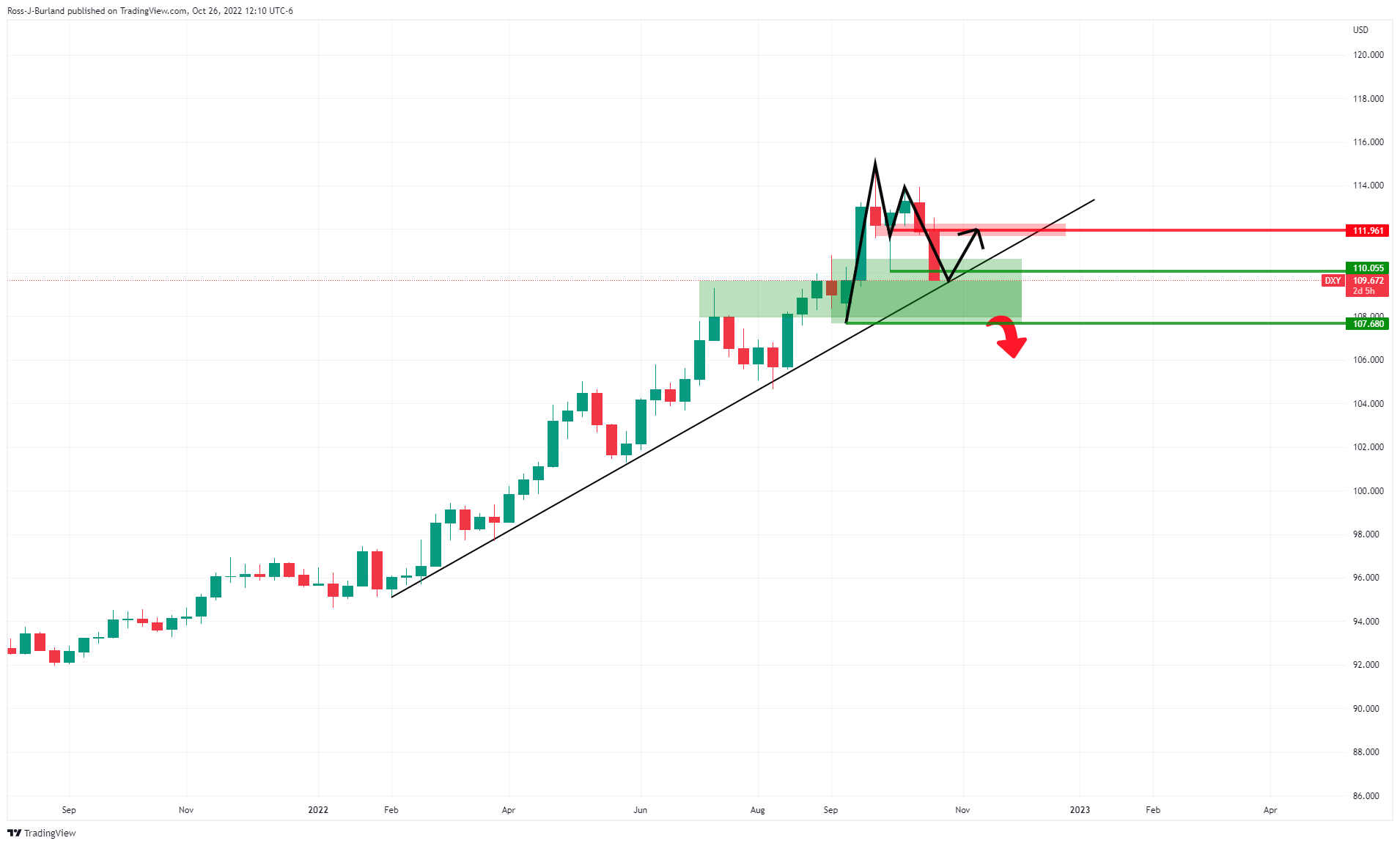
(US 10-year daily chart above, DXY daily chart below)
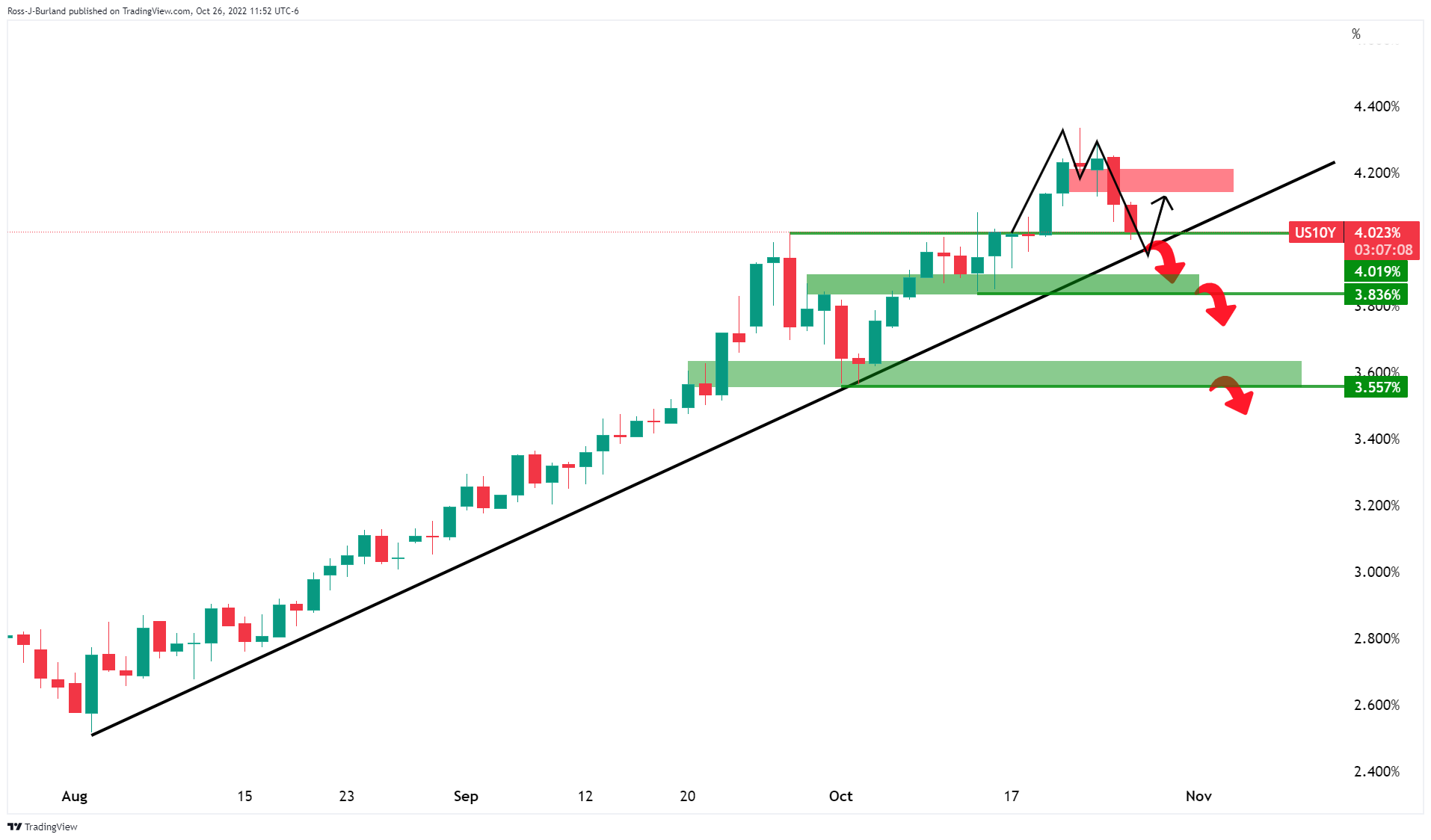
However, there are prospects of a stronger dollar for longer so long as the trendline supports hold and all the while the woes out of Europe and economic dire straits in China remain a thorn in the side of risk sentiment.
Meanwhile, the Aussie remains upbeat following the Consumer Price Index data as follows:
AUD/USD during CPI
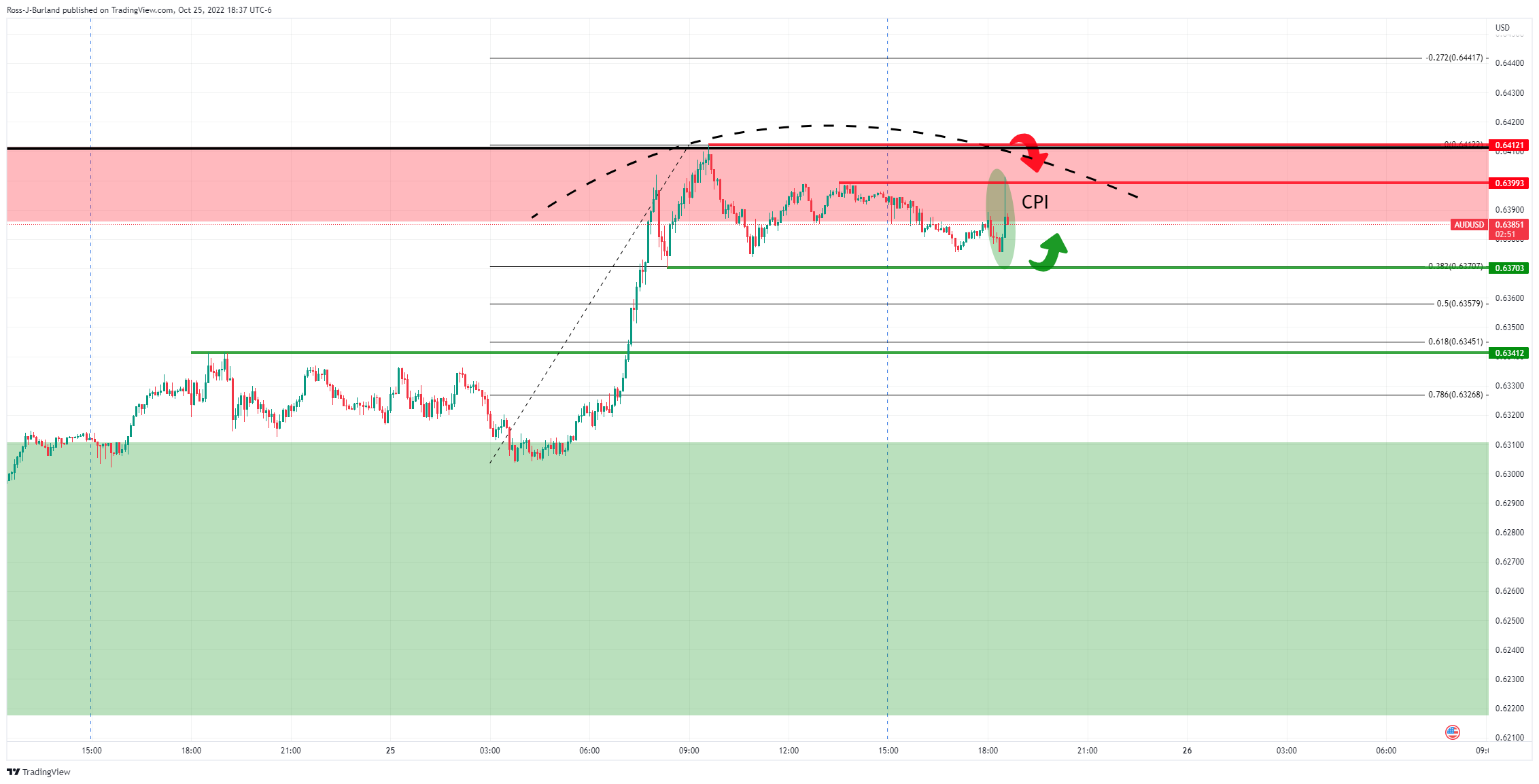
AUD/USD after:
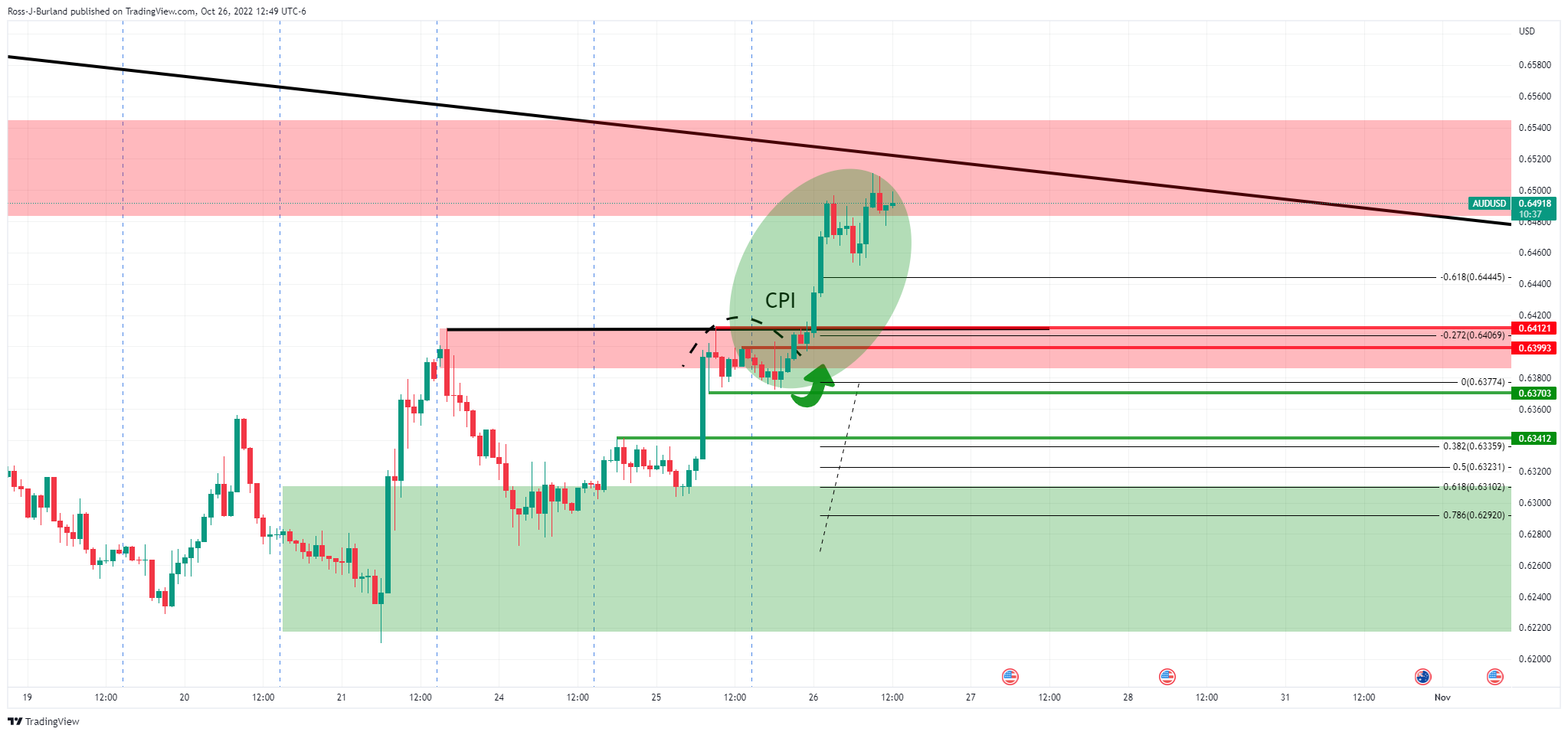
AUD/USD weekly chart

So long as the US dollar commits to the upside, the outlook remains bleak for risk sentiment, stocks and high beta currencies such as the Aussie. The weekly chart remains bearish at this juncture despite the corrective attempts.
Zooming in, we can see the prospects of a failure at resistance:
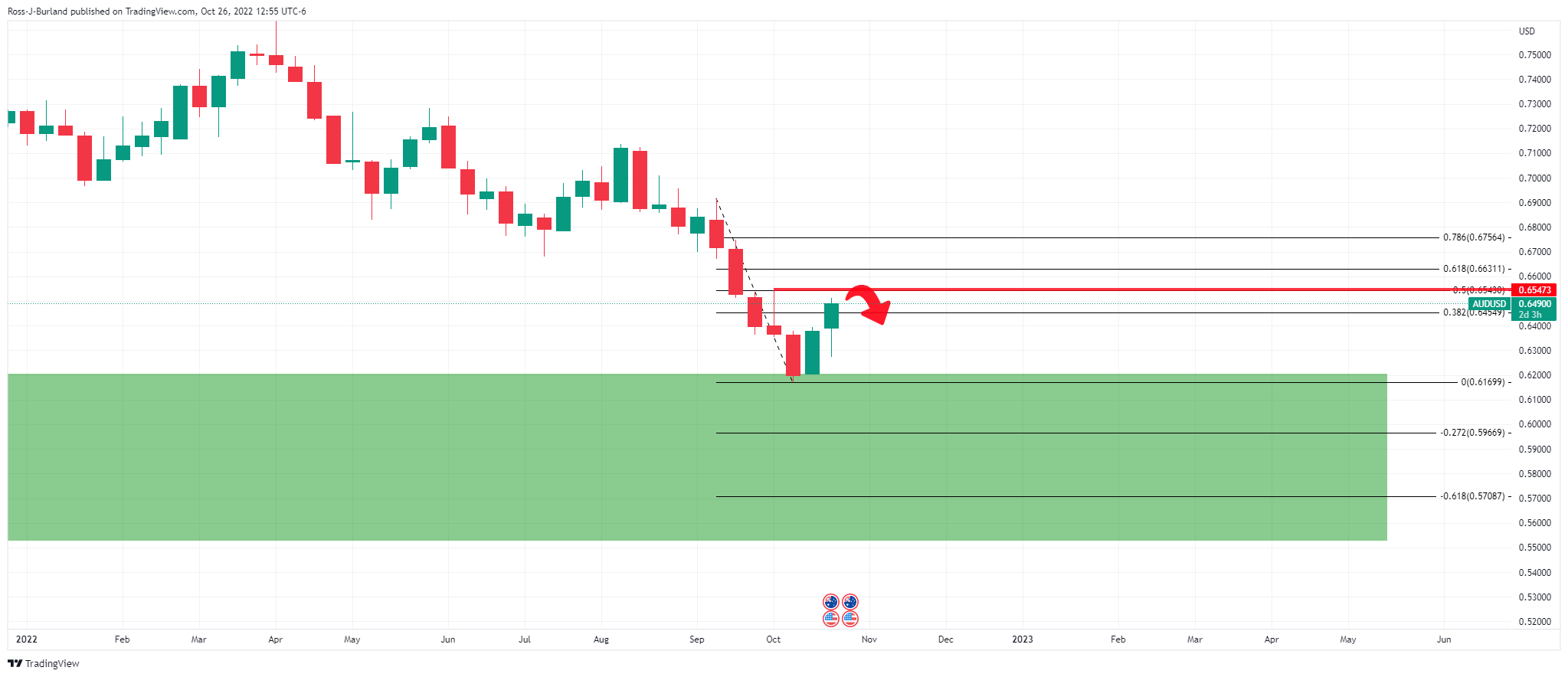
AUD/USD daily & H4 charts
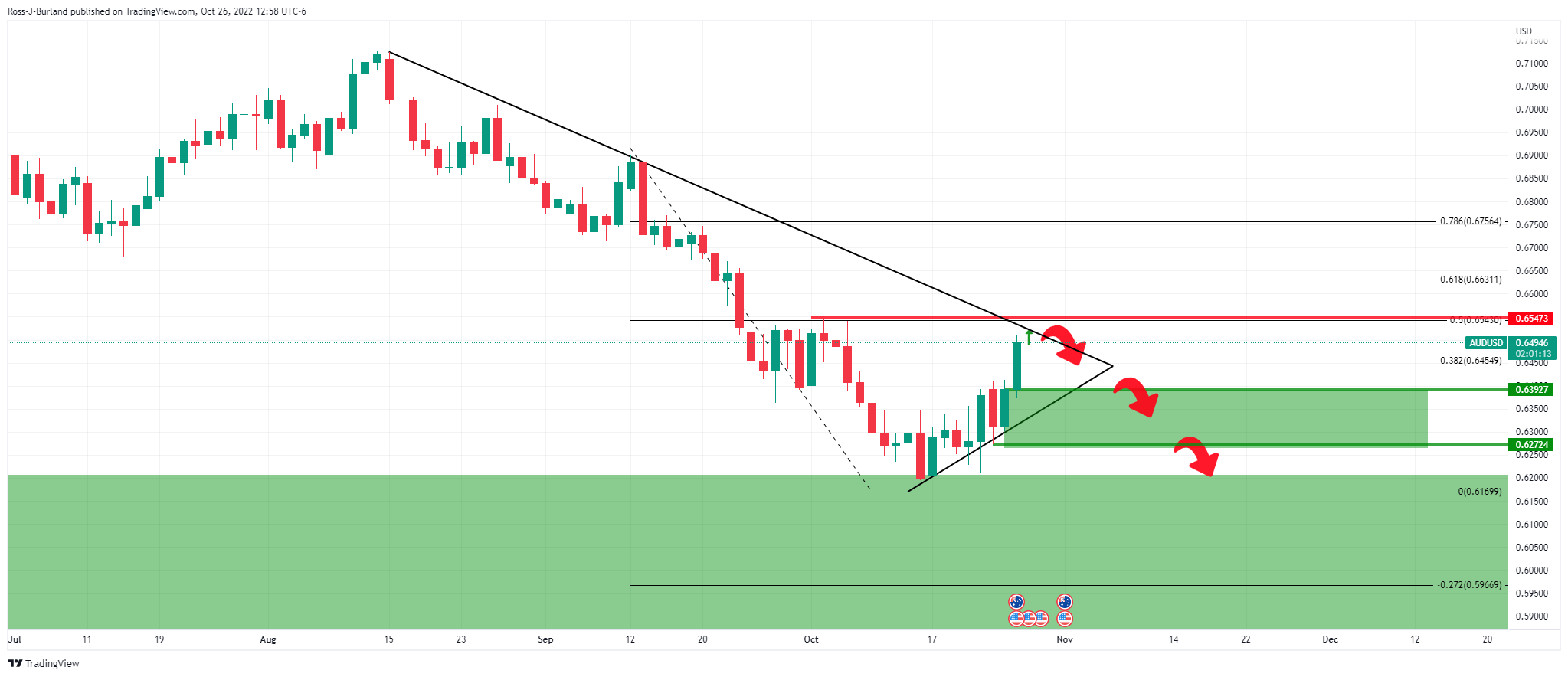
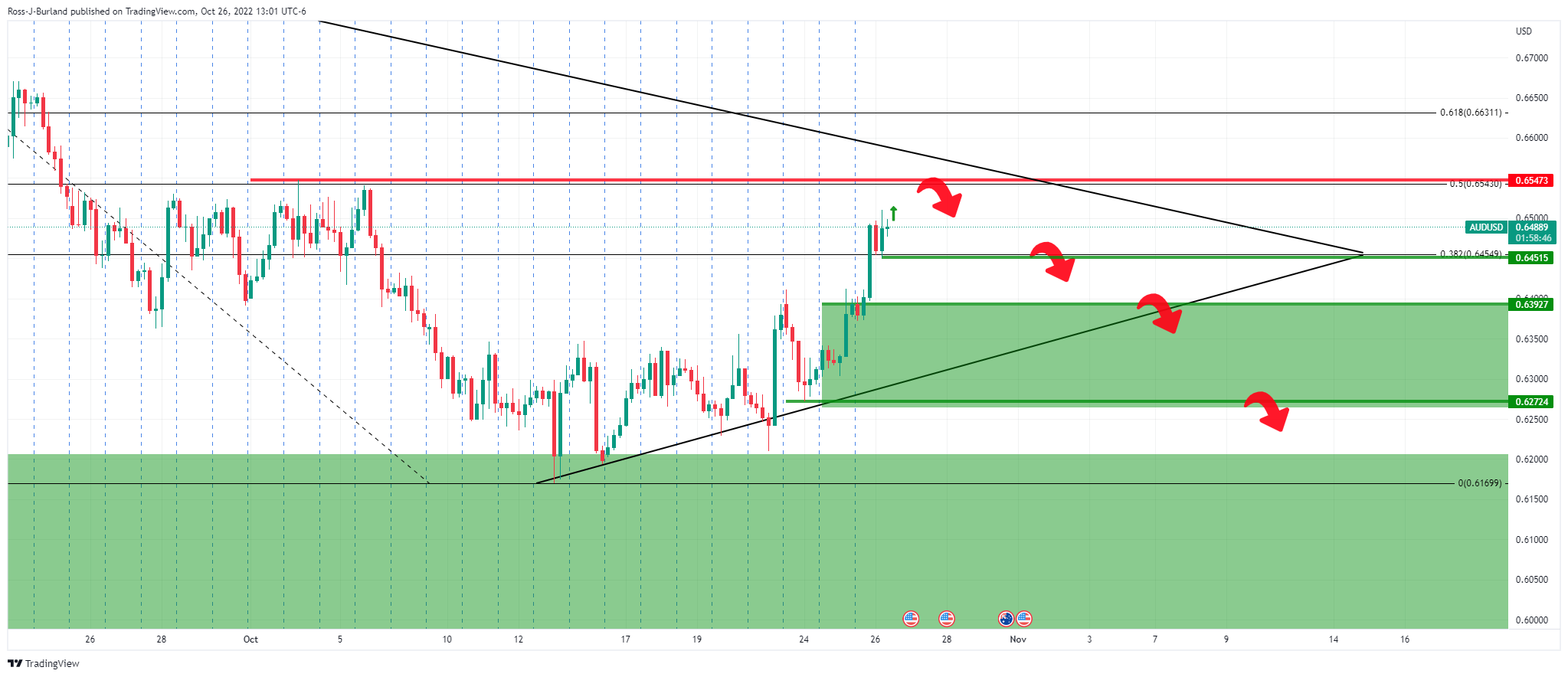
For the immediate future, the price outlook is bullish but a capitulation of the bulls can be expected. The daily chart is seeing the price head into a key resistance level and failures there could see the price move in on the longs that have built up for the week. If the market breaks key structures, falling out of the symmetrical triangle could be significant, especially around the Federal Reserve, leading to a downside continuation as per the weekly chart. Key supports are located at 0.6450, 0.6390 and 0.6270 while the markets bearish below 0.6550.
-
19:44
EUR/USD extends gains above parity and nears 1.0100
- The euro rallies further to reach five-week highs at 1.0085.
- Fed pivot expectations are hurting the USD.
- EUR/USD: Holding above 1.0000 the pair could reach 1.03 – Scotiabank.
The euro is performing a surprising recovery after having appreciated more than 3% on a four-day rally. The common currency has stretched higher on Wednesday’s US session, breaching the previous session top at 1.0050 to reach 1.0085.
Fed tightening slowdown is hammering the USD
The US dollar has been on the defensive over the last sessions weighed by market expectations of a certain softening on the Federal Reserve’s tightening path. A batch of downbeat US indicators has revived concerns that escalating interest rates are dampening growth.
A news report by the Wall Street Journal suggesting that Fed officials might be discussing how to communicate lower rate hikes in the months ahead has given further backing to that thesis. This new scenario is weighing on the USD, which has surged about 20% this year, buoyed by the Fed’s hawkish stance.
On the other end, the market awaits a second consecutive jumbo rate hike by the European Central Bank on Thursday. With inflation at record highs, the ECB a 0.75% rate hike is priced in, which has been fuelling demand for the common currency over the last few days.
EUR/USD: Holding parity suggest further gains toward 1.03 – Scotiabank
Currency analysts at Scotiabank see risks skewed to the upside if the pair consolidates above 1.000: “Gains yesterday through key trend resistance off the Feb EUR high are holding and what was resistance now becomes key support (0.9935) (…) Note that parity (0.9998) is the 23.6% retracement of the 2022 EUR decline; holding parity suggests more gains towards 1.03 (38.2% retracement at 1.0284).”
Technical levels to watch
-
19:24
GBP/JPY Price Analysis: Climbs above 170.00 after hitting a six-year high
- GBP/JPY climbs after retracing from reaching six-year highs at around 170.60.
- If GBP buyers clear the YTD high, the next resistance would be February’s 2016 highs at 175.00.
- Short term, the GBP/JPY is upward biased, though a daily close below 170.00 could pave the way for further losses.
The GBP/JPY surged and passed above 170.00, hitting a fresh year-to-date high at 170.60, but retraced some of its gains and edged towards the 169.90 area, remaining above its opening price. At the time of writing, the GBP/JPY is trading at 170.14.
GBP/JPY Price Analysis: Technical outlook
The daily chart shows that the GBP/JPY is upward biased, though failure to hold to gains above 170.00 could expose the cross to selling pressure. Worth noticing that as GBP/JPY price action registered a series of higher highs, the Relative Strength Index (RSI) did not, so divergence between price action and the RSI means buyers are losing momentum.
If the GBP/JPY holds above 170.00, the following key resistance would be 175.01, February’s 2016 high. On the flip side, the first demand zone would be October 25, high at 169.94, followed by the 169.00 figure, and the October 25 low at 167.78.
Short term, the GBP/JPY one-hour chart illustrates the pair advancing steadily, above the 20-Exponential Moving Average, consolidating some pips below the R1 daily pivot at around 170.10. Worth noting that once the cross-currency pierced the 170.00 figure and reached a six-year high, it retraced and consolidated around the 20-EMA at 169.95. Further reinforcing the upward bias, the Relative Strength Index (RSI) is in bullish territory, aiming higher.
The GBP/JPY first resistance would be the YTD high at 170.60. Once cleared, the following supply zone would be 171.00. Conversely, the GBP/JPY first support would be 170.00. Once cleared, the next support would be 169.50, followed by the October 26 low of 169.60.

GBP/JPY Key Technical Levels
-
19:13
Gold Price Forecast: XAU/USD bulls on the verge of a significant breakout
- Gold is on the verge of a significant bullish turnaround, but it all depends on the Fed.
- Technically, the bulls need to hang on above hourly support and break a daily H&S neckline.
The gold price is higher by some 0.70% on the day as the US dollar continues to bleed out in a risk-on environment following the Bank of Canada's dovish rate hike ahead of next week's Federal Reserve interest rate decision. US bond yields have slipped on expectations that the Federal Reserve will temper its aggressive rate-hike stance starting December which has enabled the precious metal to firm up within a broader bearish technical picture.
DXY and yields on the backfoot
At the time of writing, XAU/USD is trading at $1,665 having travelled between a low of $1,649.81 the low and $1,675.00 the high. The DXY, an index that measures the greenback vs. a basket of currencies is losing some 1.00% on the day having dropped from a high of 111.135 to a low of 109.649 while the US 10-year yield is down 1.95% from a high of 4.113%, clinging on to 4%, just a touch above the lows of 3.997% as it moves in on technical support:
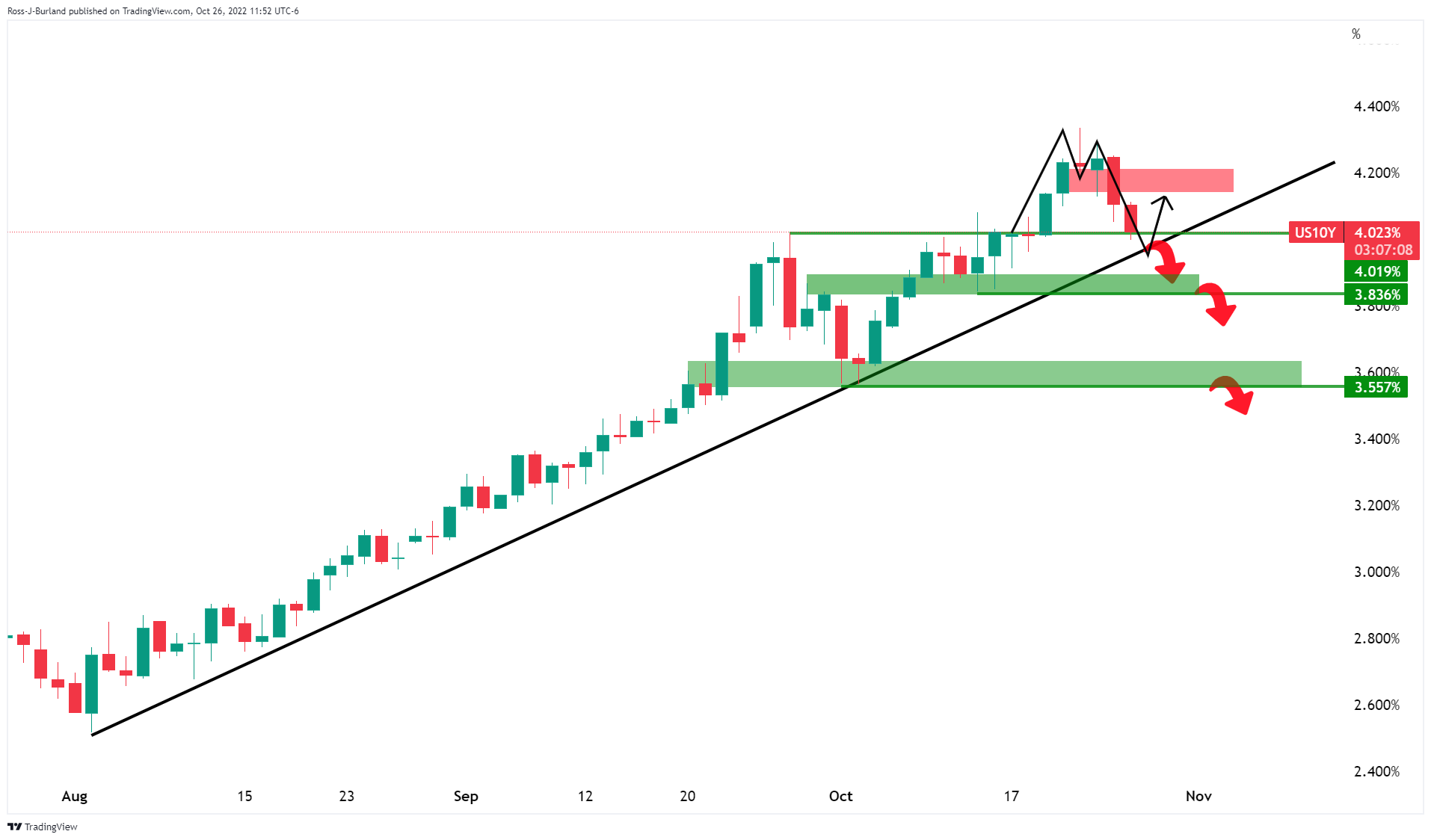
This Benchmark has now dropped to a one-week low, but the bond market might not be too hasty to totally write off a hawkish Fed and price in a Fed pivot entirely until the outcome of next week's meeting. This leaves the M-formation compelling on the daily charts as a reversion pattern that coexists with critical trendline and horizontal support which will likely see the vicinity of 4.00% as a robust area in the meantime, hamstringing gold prices as the DXY will find support:
DXY weekly chart
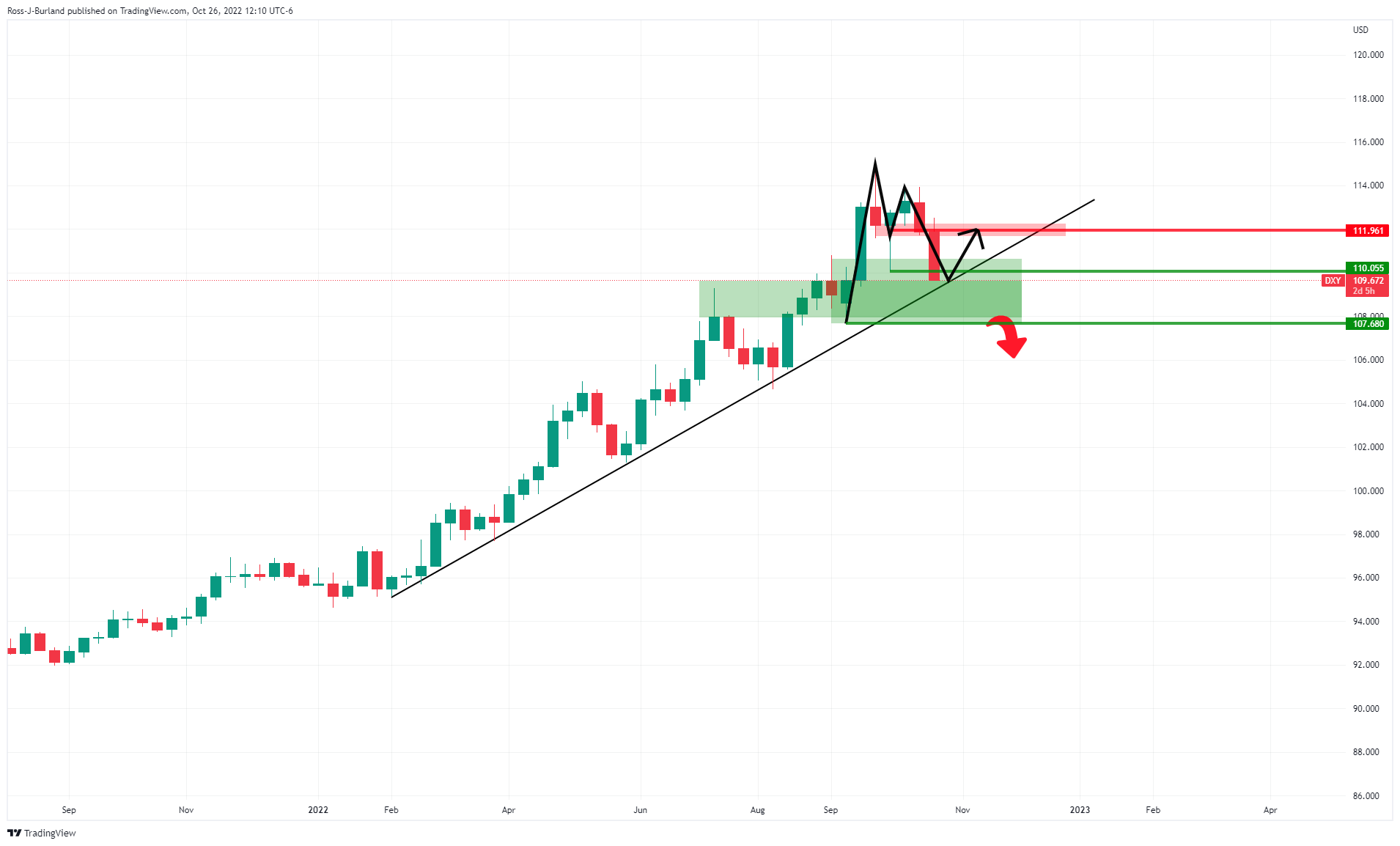
All depends on data and the Fed
Meanwhile, ''we reiterate that precious metals have yet to discount the implications of a prolonged period of restrictive rates that should continue to weigh on prices,'' analysts at TD Securities argued.
On the other hand, data will be key as central bankers, such as with the BoC today, will be reluctant to raise rates further which would be a positive environment for gold. Nevertheless, the Fed is still widely expected to raise the interest rate by 75 basis points in November and the yellow metal is sensitive to rising US interest rates, as they increase the opportunity cost of holding non-yielding bullion. Ahead of the event, US Gross Domestic Product data on Thursday, followed by US core inflation numbers on Friday could be the clincher before the event as investors might wish to front run it due to what clarity on the Fed rate-hike trajectory might come in the data. There will also be the European Central Bank meeting. it is worth noting that the ECB has failed to see the euro rally in several past meetings, fuelling a bid in the greenback.
Gold technical analysis
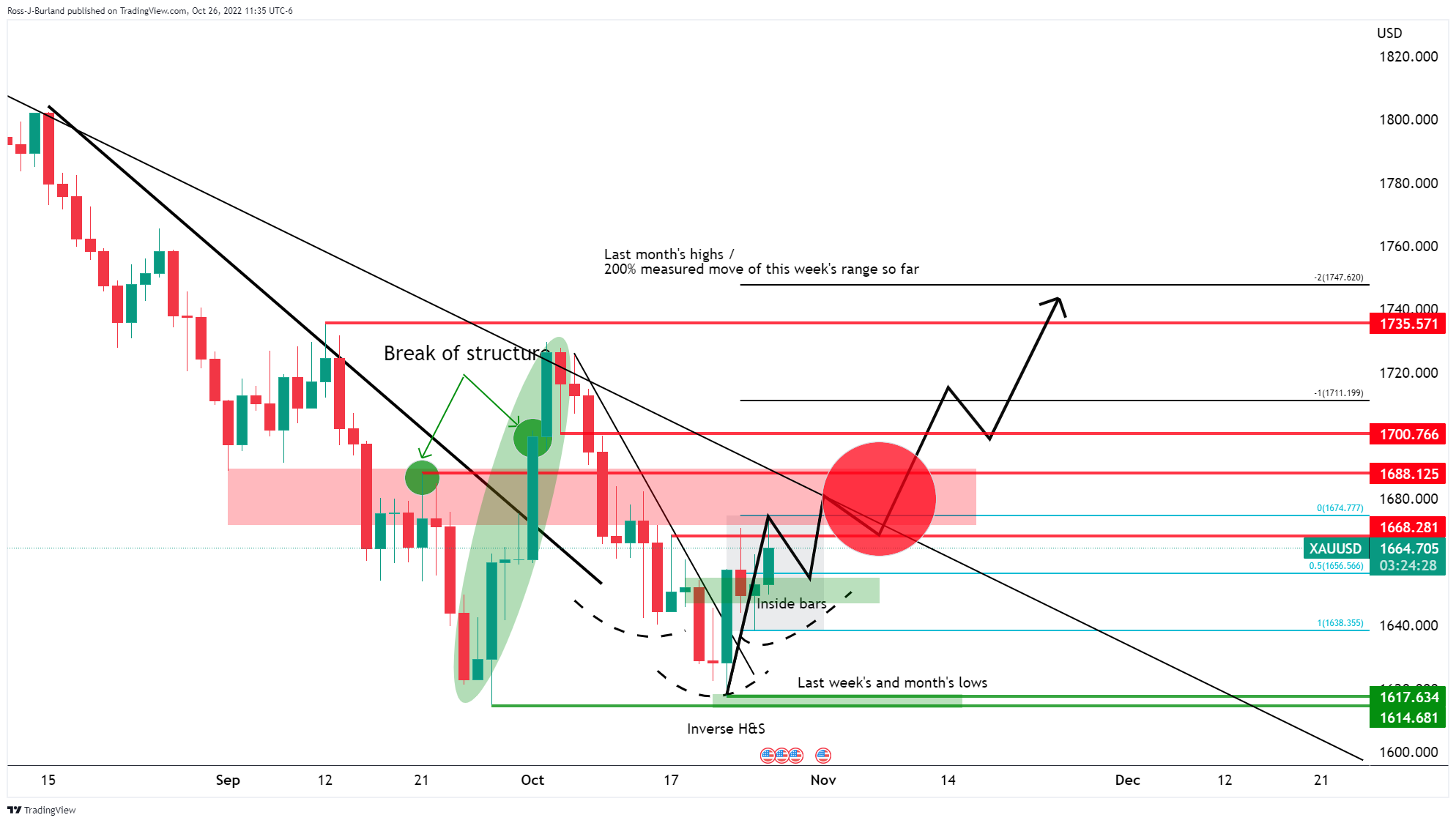
The daily chart, above, shows a number of bullish confluences. We had a break in daily structure back on Oct 3 to take the gold price on the back side of the daily trendline resistance. The price moved back into Wednesday 22 Sep bullish peak formation lows in a micro daily bear trend. We have broken on the backside of the micro (secondary) daily trendline on Fri 22 Oct and we have two prior inside days that are being broken today (bullish). This could be cementing the formation of an inverse head and shoulders for a 150% measured move of this week's range so far to target last month's highs of near $1,735. A close above the $1,670 neckline could be the trigger point to start looking for the set-up on lower time frames.
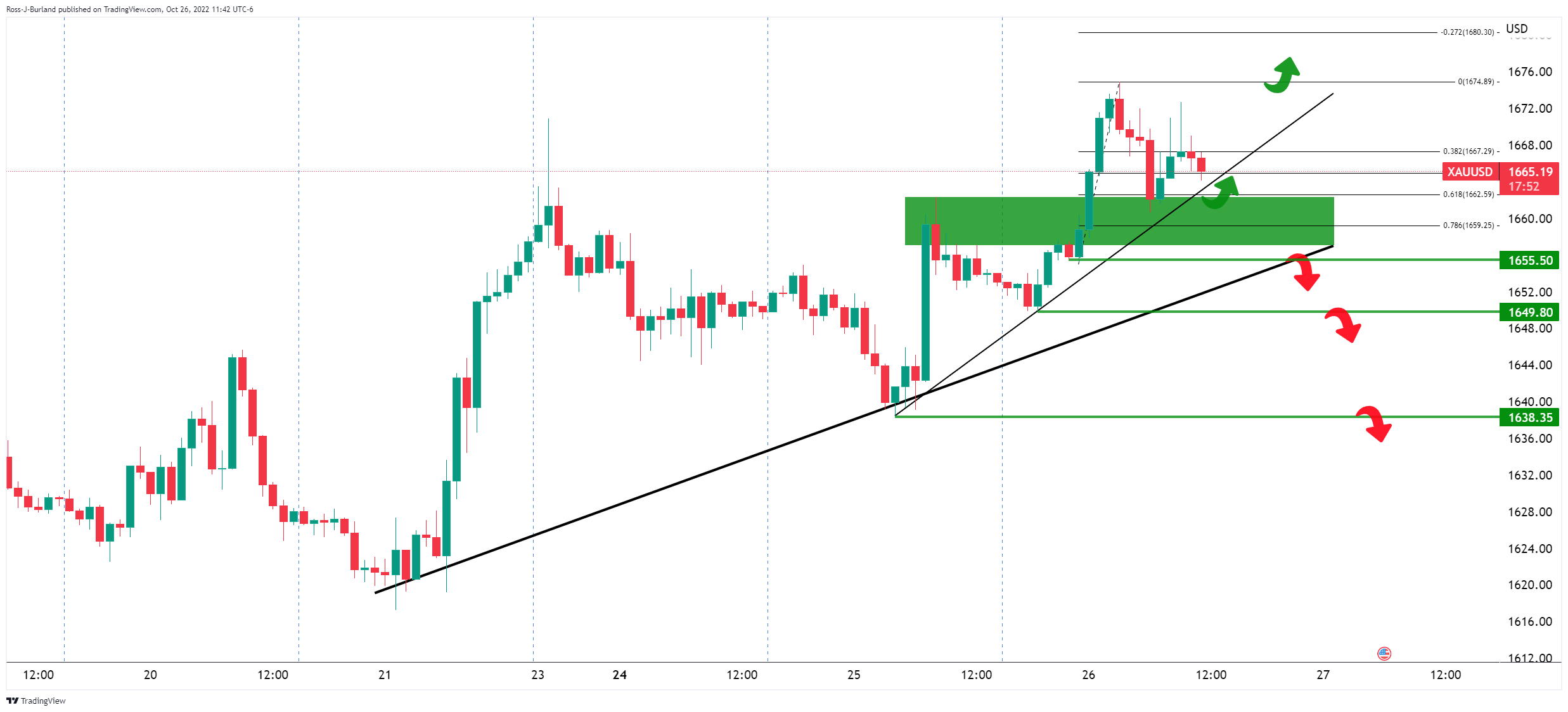
The daily chart is bullish but the hourly charts are starting to paint a different story. The bulls need to commit over the next day to the trendline supports or face the pressures below as illustrated above.
-
19:05
USD/CHF testing three-week lows at 0.9855 after pulling back from 0.9930
- The dollar fails at 0.9930 and returns to the 0.9855 support area.
- Hopes of slowing down by the Fed are weighing on the USD.
- Downside risks have increased below 0.9925.
The US dollar resumed its downtrend against the Swiss franc on Wednesday. The mild recovery attempt witnessed during the European session has been capped at 0.9930, and the pair gave away gains, later on, to test the 0.9855 area at the moment of writing.
The USD dives on Fed pivot expectations
The greenback is depreciating across the board for the second consecutive day, with investors starting to price in a slowdown on the Federal Reserve’s tightening path. A recent batch of negative indicators in the US has boosted concerns about the impact of the Fed’s hawkish policy in economic growth.
The market is still awaiting a 75 basis points hike next week, although the expectations for December have been downgraded to a 0.50% hike. This is hurting the USD, which had been surging over the last months, propelled by the Fed’s radical tightening pace.
USD/CHF: Downside risks have increased below 0.9925
Below 0.9925, the consolidative pace of the last three weeks has been broken, adding negative pressure on the pair. Immediate support lies now at 0.9850 (200-day SMA) before 0.9785 (October 4, 6 lows) and 0.9740 (September 29 low)
On the upside, the pair should return above the mentioned 0.9925 and the 100-day SMA, at 0.965 to ease negative pressure before setting its focus at the 1.0000 psychological level.
Technical levels to watch
-
18:22
WTI reaches two-week highs at around $88.00 on soft US Dollar
- Western Texas Intermediate (WTI), the US crude oil benchmark, has risen close to 4%.
- US inventories added 2.6 million barrels, above estimates but lower than Tuesday’s API’s 4.5 million build-ups.
- WTI Price Analysis: A move toward $90.00 is almost certain after regaining the 20/50-DMAs.
WTI soared during the New York session, propelled by the overall US Dollar weakening, tumbling more than 1%, while WTI’s exports hit an all-time high due to domestic refiners operating at a higher level. At the time of writing, WTI is trading at $88.05 per barrel after hitting a daily high of $88.38.
The US Dollar Index, a gauge of the buck’s value against a basket of peers, is stumbling for the second consecutive day, more than 1%, down from 111.135 highs to 109.774, a tailwind for the oil price.
Also, given the backdrop of the Organization of Petroleum Exporters Countries (OPEC) decision to cut oil output bolstered WTI price as the market prepares for tighter supply in the coming months. Additionally, the shortage of Russian products due to an oil embargo will have implications for inflation, according to Goldman Sachs, in a note quoted by Bloomberg.
In the meantime, US crude stockpiles rose by 2.6 million barrels, exceeding estimates but lower than data reported by the American Petroleum Institute (API), which showed a sharp increase of 4.5 million in US inventories. Furthermore, exports rose to 5.1 million BPD, the highest ever, while US imports dropped.
WTI Price Analysis: Technical outlook
WTI is neutral biased, though once it reclaimed the 20 and 50-day Exponential Moving Averages (EMAs) in the same trading session, a test of the $90.00 per barrel is on the cards. Notable, the Relative Strength Index (RSI) jumped in the last two days after oscillating around the 50-midline. So, as the RSI gathers bullish momentum, if oil buyers reclaim the $90.00 figure, a move towards the 100-day EMA at $94.05 would likely happen.
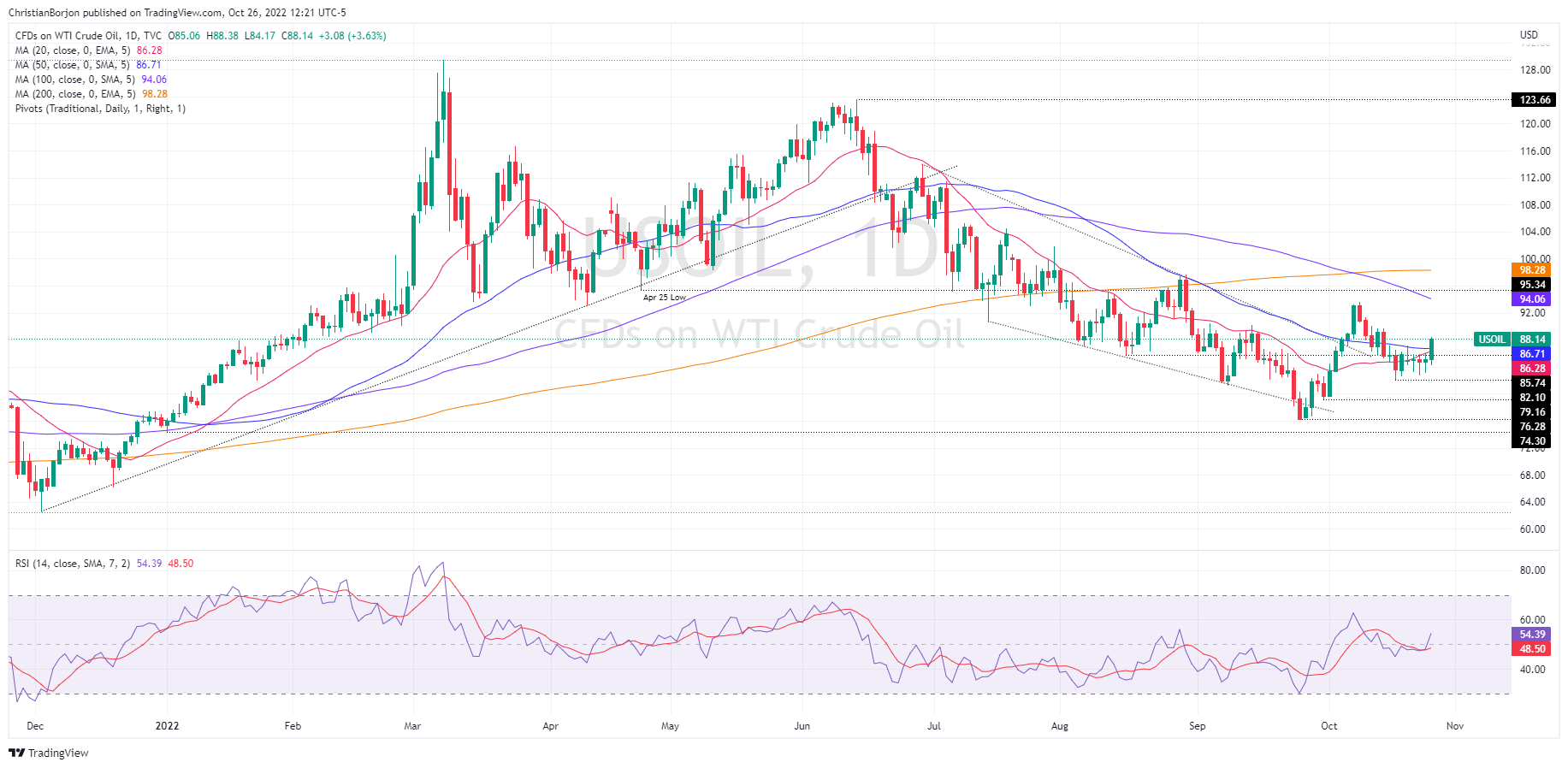
-
18:12
Silver Price Analysis: XAG/USD treads water above $19.50
- Silver prices' recovery stalls at $19.50 area.
- A weaker USD underpins the precious metals recovery.
- XAG/USD needs to breach an important resistance hurdle at $19.65/75.
Silver prices are trading higher for the second consecutive day on Wednesday, with the white metal extending its recovery from the $18.80 low on Tuesday to two-week highs at $1975, where it seems to have found a significant resistance hurdle.
USD weakness underpinning precious metals’ recovery
The XAG/USD appreciated earlier on Wednesday, fueled by a broad-based US dollar weakness, as the investors start to price in a slowdown on the Federal Reserve’s monetary tightening path.
The positive price action, however, has stalled right below the $19.65/75 area, where the 100-day SMA meets the 50% Fibonacci retracement level of the October 4-14 decline and the September 23 high.
A successful break above that area would put the pair aiming for the $20.00 psychological level (and the 61,8% Fib level of the aforementioned decline) before aiming at $20.85 October 6 and 7 highs.
On the downside, the 50-day SMA, at $19.00 is defending the pair from further decline, so far, with the next potential support area at $18.80 (Oct 25 low) ahead of the October 14 low at Oct 14.
XAG/USD daily chart
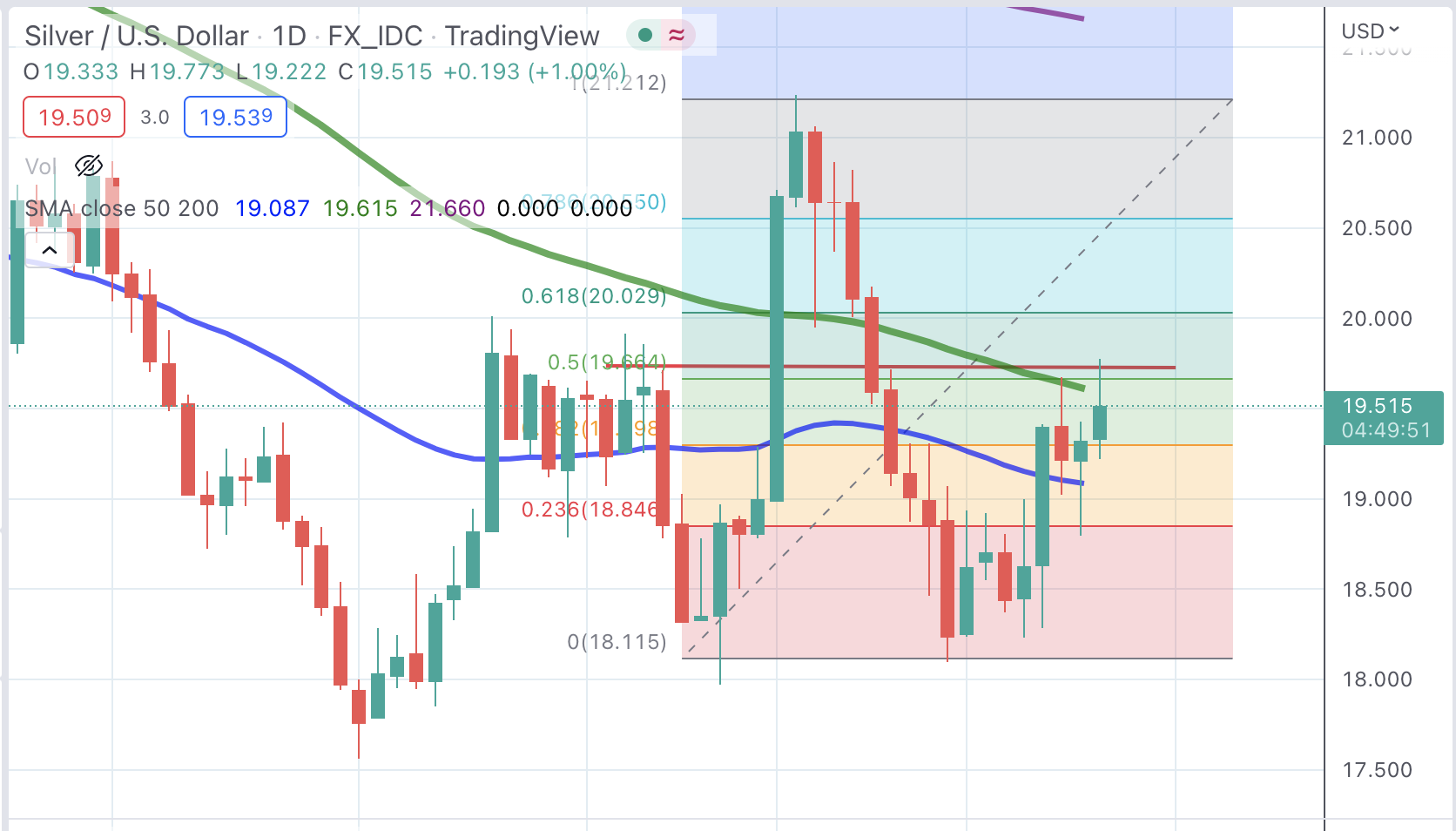
Technical levels to watch
-
18:03
United States 5-Year Note Auction fell from previous 4.228% to 4.192%
-
17:39
GBP/USD soars above 1.1600, hitting a fresh six-week high
- GBP/USD rallies sharply above 1.1600 due to a vote of confidence to UK’s PM Rishi Sunak.
- Speculations for a Fed pivot increase as recently featured data shows the housing market is crashing.
- GBP/USD: From a technical perspective is neutral-to-downward biased unless it reclaims the 100-DMA around 1.1750.
The Pound Sterling extended its rally against the US Dollar for two consecutive days, above its opening price by more than 1%, on news that the UK new Prime Minister Rishi Sunak may delay the announcement of a fiscal plan on October 31, to mid-November. Also, further US economic data shows deterioration in the housing market, weakening the USD, a tailwind for the GBP. At the time of writing, the GBP/USD is trading at 1.1620.
Sentiment remains positive, with Wall Street trading in the green. US economic data revealed by the US Commerce Department that home sales dropped at a 10.9% MoM pace in September, while August’s previous figures of 685K units were downward revised to 677K, signaling that the Federal Reserve aggression continues to dampen the housing market.
In the meantime, the financial markets’ perception of a Fed pivot continues to weigh in the greenback. The US Dollar Index, a measure of the buck’s value vs. a basket of six currencies, drops by almost 1%, down at 109.87, bolstering the GBP/USD.
Aside from this, Fed officials, in the blackout period ahead of the Federal Reserve Open Market Committee (FOMC) meeting in November, GBP/USD traders could shed some light on US economic data. On Thursday, the US calendar will feature the preliminary reading of the Gross Domestic Product (GDP) for Q3, which is expected at 2.4%. Of note, the last report of the Atlanta GDPNow estimates for Q3 GDP an increase of 2.9%.
GBP/USD Price Forecast: Technical outlook
The GBP/USD is neutral-to-downward biased until the major reclaims the 100-day Exponential Moving Average (EMA) at 1.1748. Nevertheless, with the Relative Strength Index (RSI) aiming higher, at 61.68, a move towards 1.1700 is on the cards. But traders should be aware of sudden market mood shifts, with sentiment remaining fragile in the last couple of weeks.
Therefore, the GBP/USD first resistance would be 1.1700, followed by the 100-day EMA at 1.1748, which will expose the 1.1800 figure once cleared. On the other hand, the GBP/USD first support would be 1.1600, followed by the 1.1500 figure, ahead of the October 26 daily low at 1.1430.

-
17:27
USD/CAD drops back below 1.3600 as the post-BoC reaction fades
- The USD resumes its downward trend and returns below 1.3600.
- The Canadian dollar spiked down after the BoC's "bearish hike".
- USD/CAD seen at 136 by year-end despite BoJ slowing down – BofA.
The US dollar resumed its bearish trend on Wednesday, retreating below 1.3600 after having spiked up to 1.3650 following the Bank of Canada’s bearish monetary policy decision earlier today.
The Canadian dollar dips after BoC's monetary policy decision
The Bank of Canada announced a 50 basis point hike, instead of the 75 bp hike the market had anticipated, and pointed out to further monetary tightening ahead even If, as they reckon, the economy might be entering a slight recession over the coming quarters.
According to the statement, future hikes will be influenced by the bank’s assessment of "how tighter monetary policy is working to slow demand, how supply challenges are resolving and how inflation and inflation expectations are responding”
On the other hand, the US dollar remains vulnerable, as the market starts to assume a slowdown in the Federal Reserve’s monetary tightening cycle. Although a 75 bp hike in November is already priced in, the recent downbeat macroeconomic data in the US suggests that the bank’s sharp rate hike is damaging economic growth, which might add pressure to the bank to approve a 0.50% hike in December.
USD/CAD, seen at 1.36 by year-end – BofA
Currency analysts at Bank of America see the pair at 1.36 by year-end, despite BoC slowing down: “We expect the actual delivery of a BoC downshift to allow CAD rates to continue to outperform those of the US. USD/CAD appeared to be overbought in September due to the August inflation surprise and broad risk-off sentiment in the market. The latest inflation prints should provide some short-term tailwind for CAD ahead of the BoC meeting (…) We keep our year-end forecast at 1.36 for USD/CAD.”
Technical levels to watch
-
17:08
BoC: Central bank to raise key interest rate to 4.25% – CIBC
The Bank of Canada raised the key interest rate by 50 basis points to 3.75% surprising market participants that expected a larger increase. Analysts at CIBC still expected the rate to peak at 4.25%, despite the “slight dabbing of the brakes” compared to previous hikes.
Key Quotes:
“The Bank of Canada hiked interest rates by a further 50bp to take the overnight rate to 3.75% today, although that move reflected a slight dabbing of the brakes relative to the prior pace of rate increases and what was expected by the market heading into today's decision (75bp was almost fully priced in). The press conference put some emphasis on avoiding the damaging consequences of an overshoot and the need to slow rate increases in the face of an economy that has started to slow in response to past increases.”
“While the Bank of Canada slightly under-delivered today in terms of the size of rate hike delivered, its downgraded view of potential growth and continued commitment that interest rates "will" need to rise further doesn't suggest to us that the peak in interest rates will be any lower than we were expecting heading into today's announcement.”
“The press conference opening statement suggested that we are getting closer to the end of the hiking cycle and that, barring a large surprise, steps of 75bps are now behind us. This is consistent with our forecast of a peak rate of 4.25%, and that rates will have to stay at that level at least through the end of 2023 to help bring inflation back down to target.”
-
17:00
Russia Industrial Output registered at -3.1%, below expectations (-1%) in September
-
16:56
BoC's Macklem: Cannot rely on global developments to bring down inflation
Bank of Canada (BoC) Governor Tiff Macklem responded to questions from the press following the bank's decision to raise the policy rate by 50 basis points to 3.75%.
Key takeaways
"We do expect rates will have to go up further, we will determine the pace depending on developments."
"We cannot rely on global developments to bring down inflation in Canada."
"We don't expect a severe economic contraction."
Market reaction
USD/CAD continues to trade in negative territory following the press conference and was last seen losing 0.35% on the day at 1.3560.
-
16:54
US: New home sales are likely to continue to decline in the months ahead – Wells Fargo
Data released on Wednesday showed that New Homes Sales fell 10.9% in the United States in September to an annual rate of 603K, above 583K of market consensus. Analysts at Wells Fargo point out sales are likely to continue to decline in the months ahead.
Key Quotes:
“August's robust growth in sales, which was driven by a temporary late-summer dip in mortgage rates, was revised slightly lower to a 24.7% gain.”
“Overall, homes priced over $400K comprised 66% of new home sales in September, up from 59% in August. The increase was driven by the share of sales for homes priced between $500-$749K rising to 30% from 24% the month prior.”
“New home sales are likely to continue to decline in the months ahead. Mortgage applications for purchase have dropped in every week so far in October and, as of October 21, are down 41.8% over the past year. The weakness in mortgage demand is explained by rising mortgage rates which have moved up markedly and are currently hovering above 7%, much higher than in August and September.”
-
16:47
EUR/USD hits fresh six-week highs above 1.0070
- US dollar extends slide across the board as Wall Street turns positive.
- US yields decline adding to dollar’s weakness.
- EUR/USD up for the fifth consecutive day, at six-week highs.
The EUR/USD rose further and printed a fresh six-week high at 1.0080, amid broad-based dollar weakness. It remains near the high, holding onto important daily gains the day before the European Central Bank meeting.
ECB meeting looms
The US dollar extended its correction lower on Wednesday during the American session amid a decline in US yields that reached fresh weekly lows. The DXY was falling almost 1%, trading below 110.00.
The European Central Bank will have its monetary policy meeting on Thursday. A 75 bps rate hike is expected. The decision, statement and Lagarde’s press conference will likely have an impact on euro’s crosses.
Analysts at Rabobank doubt about the possibility of the ECB sustaining a policy of large rate hikes after Thursday. They consider that taking into account the economic context, the central bank may be forced to slow the pace of its moves. “We continue to see scope for EUR/USD to drop to 0.95 into the winter months.”
Also on Thursday, the US will report the first reading of Q3 GDP growth and the weekly jobless claims report.
Going for the 100-day SMA
The EUR/USD is about to post the fifth daily gain in a row and it is consolidating above the parity and also the 55-day Simple Moving Average. The next target might be the 10-day SMA at 1.0092. Above the next resistance is seen at 1.0130.
On the flip side, a slide back under 0.9990 should alleviate the bullish pressure and could open the doors to a bigger decline initially to 0.9905 and then the 20-day SMA at 0.9825.
Technical levels
-
16:47
AUD/USD hits fresh three-week highs above 0.6500 as the USD dives
- The Aussie bounces up at 0.6450 and returns above 0.6500.
- The US dollar dives on hopes of a Fed pivot.
- Australian CPI accelerates to a 32-year high.
The Australian dollar remains strongly bid for the second consecutive day on Wednesday. The pair has resumed the upside trend, after testing support at 0.6450 earlier today, and exploring levels past 0.6500 for the first time since early October.
Hopes of a Fed pivot are hurting the US dollar
The greenback remains on the defensive amid the increasing evidence that the Federal Reserve’s tightening cycle might damage economic growth before inflation is tamed.
Tuesday’s macroeconomic data showed that US housing prices slowed down for the second consecutive month in August, with rising mortgage prices pushing buyers out of the market.
The Fed is widely expected to approve the fourth consecutive 0.75% hike after the November 1 and 2 meeting, but the market is starting to price in a 0,50% hike in December. A report by the Wall Street Journal confirmed this scenario last week, suggesting that Fed officials are discussing how to communicate lower rate hikes for the months ahead. This is taking a toll on the US dollar, which has surged across the board over the last months, propelled by a hawkish Fed.
On the other hand, Australian data showed earlier on Wednesday that the CPI expanded at its fastest pace in 32 years in the third quarter. The yearly inflation accelerated by 7.3% against the 7% anticipated by the analysts, which adds pressure on the RBA to keep increasing interest rates thus buoying demand for the aussie.
Technical levels to watch
-
16:34
BoC's Macklem: A significant slowing of the economy will occur
Bank of Canada (BoC) Governor Tiff Macklem responds to questions from the press following the bank's decision to raise the policy rate by 50 basis points to 3.75%.
Key takeaways
"A significant slowing of the economy will occur."
"We are seeing clearer evidence economy is slowing."
"Next time the bank raises rates, it could be another larger-than-normal hike, might be a normal-sized one."
"It was appropriate to slow the pace of increase in our policy rates from very big steps to a big step."
Market reaction
The loonie manages to stay resilient against the weakening dollar following these remarks and the USD/CAD pair was last seen losing 0.4% on the day at 1.3552.
-
16:11
BoC's Macklem: Getting closer to end of tightening phase
Following the Bank of Canada's (BoC) decision to hike the policy rate by 50 basis points, Governor Tiff Macklem said they are getting closer to the end of the tightening phase but added that they are not there yet.
Additional takeaways
"We are still far from the goal of ensuring inflation is low, stable and predictable."
"There are no easy outs to restoring price stability, we are trying to balance the risks of under- and over-tightening."
"We expect growth to stall in the next few quarters; once we get through this slowdown, growth will pick up."
"We noted the emergence of financial stresses in some markets in recent months."
"Seeing early encouraging signs that underlying inflation is coming down."
Market reaction
The USD/CAD pair, which jumped to a daily high of 1.3650 with the initial reaction to the BoC's dovish hike, lost its traction and was last seen losing 0.5% on the day at 1.3545.
-
15:52
ECB Preview: Forecasts from 15 major banks, no obstacles to a 75 bps hike
The European Central Bank (ECB) is set to announce its decision on monetary policy on Thursday, October 27 at 12:15 GMT and as we get closer to the release time, here are the expectations as forecast by the economists and researchers of 15 major banks.
Economists expect the ECB to raise borrowing costs by 75 bps for the second time in a row. That would put the main refinancing rate at 2% and the deposit rate at 1.50%.
SocGen
“We now expect another 75 bps hike by the ECB in October and more rate hikes through next spring, barring a deeper recession, for a terminal rate of 3% by mid-2023. Faster rate hikes also move quantitative tightening (QT) up the agenda, and we now expect a gradual start by mid-2023. However, with the balance sheet playing an important role for financial stability (see the UK) and avoiding fragmentation, QT options and communication will need to be assessed carefully. Focusing initially on private sector assets, allowing greater capital key flexibility and/or a faster TLTRO reduction could help smooth any market volatility or increased fragmentation.”
Danske Bank
“ECB meeting is set to bring another 75 bps rate hike in all three policy rates. We expect Lagarde to say that the probability of the ECB staff's downside risk scenario from the September projection exercise is becoming more likely but fall short of giving new significant policy signals. We expect the ECB to continue to hike its policy rates until early next year, with the risk of potential further hikes if fiscal initiatives support the growth outlook in such a way that inflation remains too high over the medium-term.”
ING
“A 75 bps hike looks like a done deal but the ECB has a lot on its plate at its October meeting. Quantitative Tightening talks are premature but it will seek to mop up bank liquidity. Rates, sovereign and money market spread upside dominates with the 10Y Bund set to test 2.5%. None of this should be enough to support the EUR.”
Nordea
“We expect the ECB to raise rates by 75 bps and signal that more hikes will be in store, point to incoming data and the new forecasts available in December determining the size of the next move but to generally sound hawkish, debate when and how to start reducing the ECB’s huge bond portfolio but leave the decision until the December meeting and announce technical changes to encourage banks to early repayments of the TLTROs and possibly also measures to ease the tensions in the government bond markets.”
Commerzbank
“We expect the ECB Council to decide to raise key interest rates by a further 75 bps as well as to change the TLTRO conditions so that commercial banks will no longer be able to make safe profits on TLTROs.”
TDS
“We expect the Governing Council to hike ECB rates by 75 bps, taking the Depo Rate to 1.50%. Messaging at this meeting is likely to remain focused on record-high inflation rather than soft growth.”
Rabobank
“A 75 bps rate hike seems like a done deal. We have also upgraded our expectations for the next few meetings, and now see the deposit rate reach 3% by March. The ECB seems determined to end the TLTRO arbitrage. We expect the ECB to try to minimise market impact, but we predominantly see risks of a more negative €STR-deposit rate spread. Quantitative tightening may be explored, but any tangible plans are unlikely.”
Nomura
“We forecast the ECB Governing Council will raise all three key interest rates by 75 bps. This would bring the depo rate to 1.50%, the refi rate to 2.00% and the marginal lending rate to 2.25%.”
Deutsche Bank
“We expect another 75 bps hike, followed by 75 bps in December, 50 bps in February and 25 bps in March, reaching a terminal rate of 3%. The press conference as ever will be a focal point and there’ll be lots of attention on technical things surrounding TLTROs and excess reserves.”
ANZ
“Faced with rising and broadening inflation, we expect the ECB to raise rates by 75 bps and maintain its hawkish guidance. There may be a focus on when 50 bps rise will be appropriate. At some point, quantitative tightening will need to be part of the normalisation process. The ECB will proceed with caution given the widening trend in regional spreads and recent turmoil in the gilts market. We think QT is an early 2023 story. Containing inflation is central to the euro area’s economic stability. There is hope that headline HICP may peak in the coming months following the fall in gas prices. However, core inflation and wages are rising.”
Citibank
“We expect the ECB to hike policy rate by 75 bps, taking the deposit rate to 1.5%. More rate hikes are likely to be signaled. It is probably too early to take complicated decisions on unwinding asset purchases.”
BMO
“We look for a 75 bps increase: the deposit facility to 1.50%, marginal lending facility to 2.25%, and the refi rate to 2.00%. This would be the second in a series of moves to get to terminal; or, as President Lagarde laid out in September, ‘it’s probably more than two, including this one, but it’s probably also going to be less than five’. Many ECB members have taken on increasingly hawkish tones. With headline inflation of 9.9% and core CPI at 4.8% (both a record) and headed higher, the Governing Council will likely be forced to front-load more aggressive hikes to fulfill its mandate of price stability. Even France’s François Villeroy de Galhau, whose views are more middle-of-the-road, declared that he expects the ECB to ‘go quickly’ to reach a 2% deposit rate by year-end.”
Wells Fargo
“We expect the ECB to deliver another 75 bps increase to its Deposit Rate, bringing that rate to 1.50%. We doubt any announcement on quantitative tightening would come before December, while we currently do not expect any implementation of quantitative tightening to begin before March 2023.”
Crédit Agricole
“We expect the Governing Council to meet the market expectations and deliver a 75 bps hike but to signal that the policy normalisation would slow down from here while a potential QT is not imminent. This much would warrant a cautious view on the EUR from current levels.”
BofA
“We expect the ECB to hike 75 bps with a clear signal of more to come, in line with recent communication and market pricing. We argue it is too early for QT (quantitative tightening), but the language around APP (Asset Purchase Programmes) reinvestments is likely to change, preparing the ground for discussions. An announcement on punitive tiering or changing TLTRO (Targeted Long Term Refi Operations) terms seems likely to us, even if the details follow later. In FX, we do not believe the hawkish ECB steps and tone will be enough to support the EUR, given market expectations and remaining challenges.”
-
15:51
USD/JPY extends slide under 147.00 as dollar remains under pressure
- Yen gains strength as central banks slowdown rate hikes.
- US Dollar continues on correction mode, DXY drops by 0.68%.
- USD/JPY falls for the third day out of the last four days.
The USD/JPY extended losses during the American session and hit fresh lows under 146.50 as the dollar continues to correct lower across the board and amid a less weak yen.
Less aggressive central banks?
Following the decision of the Bank of Canada to raise the key interest rate by 50 basis points, below the market consensus of 75 bps, the USD/JPY bottomed at 146.43, the lowest level in two days. The increase in interest below consensus adds to the expectations that the Federal Reserve might signal a slower pace of hikes after November.
US yields hit news weekly lows recently with the 10-year at 3.99% but then rebounded back above 4.00%, helping USD/JPY move off lows.
The yen is among the top performers on Wednesday even as Wall Street is holding onto most recent gains. The Dow Jones is up by more than 200 points or 0.66%, at fresh monthly highs.
Economic data from the US showed a 10.9% decline in New Home Sales in September to an annual rate of 603K, above the market consensus of 585K. On Thursday the US will release the first reading of Q3 GDP growth. The Bank of Japan will announce its decision on monetary policy on Friday.
Technical levels
-
15:37
USD/CAD oscillates above 1.3600 after BoC’s dovish 50 bps rate hike
- The Bank of Canada hikes rates by 50 bps, less than the 75 bps expected, and the USD/CAD tumbles.
- The BoC will continue its Quantitative Tightening (QT) program.
- USD/CAD jumped toward its daily high at 1.3650 in the release of the headline.
The USD/CAD rises following the Bank of Canada (BoC) monetary decision to lift rates by 50 bps on Wednesday, disappointing market participants, expecting a ¾ of percent increase due to Canada’s economy struggling with inflationary levels not seen in 30 years. Also, the BoC announced that it would continue its policy of quantitative tightening. The USD/CAD is trading at around 1.3619, above its opening price by 0.08%.
Summary of the BoC monetary policy statement
The BoC said global inflation remains high and broadly based, feeling the impact of higher commodity prices sparked by Russia’s attack on Ukraine. The BoC acknowledged that tightening monetary conditions to temper inflation is “weighing on economic activity around the world. As economies slow and supply disruptions ease, global inflation is expected to come down.”
Regarding the international outlook, the BoC expects no growth in the US economy and a recession in the Euro area. While China’s economy appears to have picked up, the property market will keep growth contained.
Domestically, the BoC sees the economy operating in excess demand with a tight labor market. Enough supplies for goods and services keep inflationary pressures high. And the full reopening of the economy “led to a sharp rise in the price of services.”
Even though Canada’s CPI declined to 6.9% from 8.1%, price pressures remain broadly based, impacting the Bank’s preferred measures of core inflation, which “are not yet showing meaningful evidence that underlying price pressures are easing.”
Therefore, the BoC Governing Council agreed that policy rates will need to rise further and would be influenced by the BoC’s Council assessment of the effects of tighter conditions working to slow demand, lower inflation, and how supply disruptions resolve.
USD/CAD Market’s Reaction
The USD/CAD 5 minutes chart shows the pair jumped from around 1.3580 to its daily high of 1.3650, on the headline, due to market participants’ expectations for a hefty rate hike. Of note, the USD/CAD retraced to 1.3600, erasing 50 pips of gains, though it would likely remain consolidated, as the Bank of Canada (BoC) Governor Tiff Macklem will hit the stand, at around 15:00 GMT.

Source: Refinitiv
-
15:36
GBP/USD to extend its rally towards 1.20 on a break above 1.1605/20 – Scotiabank
Sterling is one of the better G10 currency performers on the day. Economists at Scotiabank expect the GBP/USD to return to the 1.20 area on a break past the 1.1605/20 zone.
Breaking and holding above 1.14 is a bullish medium-term signal
“Cable breaking and holding above 1.14 is a bullish medium-term signal for the pound.”
“We expect firm support on dips to the low 1.14s/high 1.13s from here.”
“GBP gains are stalling in the 1.16 zone today, however, extending gains through the 1.1605/10 zone targets a return to the 1.20 area for cable.”
-
15:30
United States EIA Crude Oil Stocks Change above expectations (1.029M) in October 21: Actual (2.588M)
-
15:03
Gold Price Forecast: XAU/USD to suffer further falls with a top in place – Credit Suisse
Gold remains solidly below $1,691/76, reinforcing its “double top.” Subsequently, strategists at Credit Suisse expect XAU/USD to extend its losses.
Weekly close above 55-Day Moving Average at $1,699 to alleviate downside pressure
“Gold below $1,691/76 has reinforced its existing large ‘double top’. Hence, with a top in place, we expect XAU/USD to come under renewed pressure. We note that the next support is seen at $1,614, then $1,560 and eventually our core objective at $1,451/40.”
“Only a convincing weekly close above the 55-DMA at $1,699 would ease the pressure on the yellow metal, with next resistance then seen at the even more important 200-DMA, currently at $1,813, which we would expect to cap at the very latest.”
-
15:00
Breaking: Bank of Canada hikes policy rate by 50 bps vs 75 bps expected
The Bank of Canada (BoC) hiked its benchmark interest rate by 50 basis points (bps) to 3.75% at the end of the October policy meeting this Wednesday. The decision to slow the pace of policy tightening comes amid growing worries about a deeper global economic downturn and disappointed market participants anticipating a 75 bps rate hike.
Market reaction
The surprise move weighs heavily on the Canadian dollar and triggers an aggressive short-covering around the USD/CAD pair, which rallies nearly 150 pips from a three-week low touched earlier this Wednesday.
-
15:00
Canada BoC Interest Rate Decision came in at 3.75%, below expectations (4%)
-
15:00
United States New Home Sales Change (MoM) came in at -10.9%, above expectations (-13.9%) in September
-
15:00
United States New Home Sales (MoM) above forecasts (0.585M) in September: Actual (0.603M)
-
14:35
USD/CAD to slip under 1.35 on a BoC's hawkish hike – Scotiabank
USD/CAD losses checked near 1.35 ahead of the Bank of Canada (BoC) policy decision. Economists at Scotiabank expect the pair to drop below the 1.35 mark on a hawkish hike.
A dovish hike will drive USD/CAD back towards 1.38/1.39
“Assuming a 75 bps increase, a dovish hike – that is, 75 bps with guidance towards slower/limited hikes moving ahead and the rate cycle near its peak – will hurt the CAD and drive spot back towards 1.38/1.39.”
“A neutral hike – 75 bps with little or no guidance – likely keeps USD/CAD in its current range.”
“A hawkish hike – 75 bps and clear indications from the statement that there is a lot more work to do to curb inflation – should see spot edge under 1.35.”
See – BoC Preview: Forecasts from 10 major banks, taking what is offered, a 75 bps hike
-
14:27
USD Index bounces off multi-week lows near 110.00
- The sharp sell-off in the index meets support just below 110.00.
- US yields keep the corrective downside well in place so far on Wednesday.
- US trade deficit expected to widen to $92.22B in September.
The dollar remains entrenched in the negative territory on Wednesday, although it manages to rebound from lows in the sub-110.00 area when gauged by the USD Index (DXY).
USD Index weaker on Fed’s pivot, risk appetite
The intense improvement in the risk-associated universe continues to weigh on the greenback midweek, always amidst the continuation of the corrective retracement in US yields across the board.
In the meantime, the selling bias prevails around the dollar as investors continue to assess the probability that the Fed might introduce a pivot in its normalization plans as soon as in the next months. On this, some rate-setters have already hinted at a potential debate on the matter as soon as at the December meeting.
In the US data space, MBA Mortgage Applications contracted 1.7% in the week to October 21 and advanced Goods Trade Balance showed a $92.22B deficit during September. Later in the session, New Home Sales also for the month of September are due.
What to look for around USD
The dollar’s sharp decline seems to have met some initial contention around the 110.00 neighbourhood so far this week.
In the meantime, the firmer conviction of the Federal Reserve to keep hiking rates until inflation looks well under control regardless of a likely slowdown in the economic activity and some loss of momentum in the labour market continues to be the main factor underpinning the dollar, although this view could be put to the test amidst rising speculation of the introduction of a Fed’s pivot in the relatively short-term horizon.
Looking at the more macro scenario, the greenback also appears bolstered by the Fed’s divergence vs. most of its G10 peers in combination with bouts of geopolitical effervescence and occasional re-emergence of risk aversion.
Key events in the US this week: MBA Mortgage Applications, New Home Sales, Building Permits, Advanced Goods Trade Balance (Wednesday) – Flash Q3 GDP Growth Rate, Durable Goods Orders (Thursday) – PCE/Core PCE Price Index, Personal Income/Spending, Pending Home Sales, Final Michigan Consumer Sentiment (Friday).
Eminent issues on the back boiler: Hard/soft/softish? landing of the US economy. Prospects for further rate hikes by the Federal Reserve vs. speculation of a recession in the next months. Geopolitical effervescence vs. Russia and China. US-China persistent trade conflict.
USD Index relevant levels
Now, the index is retreating 0.70% at 110.11 and the breach of 109.94 (monthly low October 26) would open the door to 109.35 (weekly low September 20) and finally 107.68 (monthly low September 13). On the other hand, the next up barrier lines up at 113.88 (monthly high October 13) seconded by 114.76 (2022 high September 28) and then 115.32 (May 2002 high).
-
14:22
EUR/USD: Holding parity suggests more gains towards 1.03 – Scotiabank
EUR/USD regains parity. The pair could extend its gains towards the 1.03 mark, economists at Scotiabank report.
Regaining parity is a boost for the euro
“Gains yesterday through key trend resistance off the Feb EUR high are holding and what was resistance now becomes key support (0.9935).”
“Note that parity (0.9998) is the 23.6% retracement of the 2022 EUR decline; holding parity suggests more gains towards 1.03 (38.2% retracement at 1.0284).”
See – EUR/USD: Break of 1.00 could trigger quite a sharp short squeeze to 1.02 – ING
-
14:11
GBP/USD eases from multi-week top, still well bid around mid-1.1500s amid weaker USD
- A combination of factors lifts GBP/USD to a fresh six-week high on Wednesday.
- New UK PM pledges to fix his predecessor's policy errors and underpins sterling.
- Reduced bets for more aggressive Fed rate hikes continue to weigh on the USD.
- A softer risk tone helps limit losses for the safe-haven buck and caps the major.
The GBP/USD pair retreats a few pips from a six-week high touched earlier this Wednesday and is trading around mid-1.1500s during the early North American session.
The new British Prime Minister Rishi Sunak pledges to fix mistakes by the Truss administration and boosts investors' confidence. This leads to a further decline in the UK government borrowing costs and continues to underpin the British pound. Apart from this, the heavily offered tone surrounding the US dollar pushes the GBP/USD pair higher for the second successive day.
Investors scaled back their expectations for a more aggressive policy tightening by the Fed in reaction to the incoming US macro data, which pointed to a slowdown in the world's largest economy. This is evident from the ongoing downfall in the US Treasury bond yields, which drags the USD to its lowest level since September 20 during the mid-European session on Wednesday.
That said, a softer risk tone, as depicted by a generally negative sentiment around the equity markets, offers some support to the safe-haven buck and keeps a lid on any further gains for the GBP/USD pair. Investors also seem reluctant and might prefer to move to the sidelines ahead of the important US economic releases, including the Advance Q3 GDP report, on Thursday.
From a technical perspective, a convincing break through the 1.1475-1.1480 supply zone and a subsequent strength beyond the 1.1500 psychological mark favours bullish traders. Hence, any meaningful pullback could now be seen as a buying opportunity and is more likely to remain limited near the said resistance breakpoint, now turned support.
Next on tap is the release of the New Home Sales data from the US. This, along with the US bond yields and the broader risk sentiment, will influence the USD price dynamics and provide some impetus to the GBP/USD pair.
Technical levels to watch
-
13:36
US: International trade deficit widens to $92.2 billion in September
- International trade deficit of the US widened in September.
- US Dollar Index stays deep in negative territory but holds above 110.00.
The data published by the US Census Bureau showed on Wednesday that the US international trade deficit widened by $4.9 billion to $92.2 billion in September from $87.3 billion in August.
"Exports of goods for September were $177.6 billion, $2.8 billion less than August exports," the publication further revealed. "Imports of goods for September were $269.8 billion, $2.2 billion more than August imports."
Market reaction
The US Dollar Index recovered slightly from multi-week lows it touched earlier in the day and was last seen losing 0.45% on the day at 110.38.
-
13:33
When is the BoC monetary policy decision and how could it affect USD/CAD?
BoC Monetary Policy Decision – Overview
The Bank of Canada (BoC) is scheduled to announce its monetary policy decision this Wednesday at 14:00 GMT. The Canadian central bank is widely expected to lift its policy rate by 75 bps to 4% at the end of the October meeting to keep inflation expectations anchored. Apart from this, investors will take cues from the accompanying monetary policy statement and the post-meeting press conference for clues about the central bank's policy outlook
Analysts at Citibank offer a brief preview of the event and explain: “While it is a very close call between a 50 bps hike or a 75 bps hike, we still lean towards expecting a 50 bps hike but still expect a significant hawkish emphasis that rates are still likely to rise further and expect another 50 bps hike in December taking the policy rate to 4.25% before a pause, but with risks that hikes continue into 2023 and reach a higher terminal rate.”
How Could it Affect USD/CAD?
Ahead of the key central bank event risk, a combination of factors drag the USD/CAD pair to a three-week low during the first half of the European session on Wednesday. An uptick in crude oil prices underpins the commodity-linked loonie and exerts downward pressure on the major amid the prevalent US dollar selling bias.
The BoC could signal a dovish tilt amid looming recession risk, which could prompt some short-covering and lift the USD/CAD pair back above the 1.3600 mark. That said, BoC Governor Tiff Macklem had said that the primary goal of the bank is to restore price stability, suggesting that the immediate market reaction is likely to be short-lived.
Conversely, hints towards a more aggressive tightening, despite cooling inflation and deteriorating economic outlook, should be enough to provide a fresh boost to the Canadian dollar. This, in turn, would pave the way for an extension of the USD/CAD pair's recent sharp pullback from the 1.3975-1.3980 area, or the highest level since May 2020 touched earlier this month.
Key Notes
• BOC Preview: Getting ready for a dovish pivot?
• BoC Preview: Forecasts from 10 major banks, taking what is offered, a 75 bps hike
• USD/CAD to bounce but not as much as expected if the BoC does pitch for 50 bps – MUFG
About the BoC Interest Rate Decision
BoC Interest Rate Decision is announced by the Bank of Canada. If the BoC is hawkish about the inflationary outlook of the economy and raises the interest rates it is positive, or bullish, for the CAD. Likewise, if the BoC has a dovish view on the Canadian economy and keeps the ongoing interest rate, or cuts the interest rate it is seen as negative, or bearish.
-
13:31
United States Wholesale Inventories came in at 0.8%, below expectations (1%) in September
-
13:30
United States Goods Trade Balance fell from previous $-87.2B to $-92.2B in September
-
13:26
EUR/USD Price Analysis: The next hurdle comes at 1.0050
- EUR/USD surpasses the parity in a sustainable fashion.
- There is scope for a visit to the 1.0050 level in the near term.
The weekly upside in EUR/USD remains healthy and manages to leave behind the key parity zone on Wednesday.
The surpass of this key region could spark a more serious recovery in the short-term horizon. Against that, the immediate barrier is expected at the weekly top at 1.0050 (September 20).
In the longer run, the pair’s bearish view should remain unaltered while below the 200-day SMA at 1.0516.
EUR/USD daily chart

-
13:21
EUR/CAD could return to a 1.40-1.45 range on a break past 1.3825 – Scotiabank
EUR/CAD’s renaissance is gathering some momentum. In the opinion of economists at Scotiabank, the pair could return to the 1.40-1.45 range.
EUR/CAD recovery gathers momentum
“The longer run (monthly) chart strongly suggests a major low and bullish reversal developed around the Aug push below 1.30. A strong gain for the Oct month overall will “confirm” the bullish reversal.”
“Short-term gains above the 200-day MA (1.3586) will add to positive momentum; note that this point roughly converges with the 38.2% Fib retracement of the 2022 decline (1.3548) and a break higher allows the cross to challenge major resistance on the daily chart at 1.3825 – the collection of highs from the spring/early summer. Above here should see the cross return to a 1.40-1.45 range.
“Key support is 1.3420/25.”
-
12:50
EUR/USD set to drop toward 0.95 into the winter months – Rabobank
EUR/USD is back above parity. Economists at Rabobank see risk that this move could be short-lived.
European Central Bank may be forced to slow the pace of its moves
“Structurally higher rates of inflation in the post pandemic period could suggest higher for longer US policy rates, which could mean that relative USD strength could persist for some time, even when it retreats from its highs. In addition to this, we see a strong risk that the EUR is not fully priced for the economic impact of Europe’s energy crisis.”
“Yesterday Germany’s IFO economic institute warned that Germany is headed into recession and forecast that its economy will contract by 0.6% in Q4. This raises the question of how long the ECB can sustain a policy of large rate hikes. A 75 bps move is expected later this week. Beyond that, it may be forced to slow the pace of its moves.”
“We continue to see scope for EUR/USD to drop to 0.95 into the winter months.”
-
12:18
USD/CAD to bounce but not as much as expected if the BoC does pitch for 50 bps – MUFG
The Bank of Canada (BoC) meets today to decide on the size of the increase in the key policy rate. USD/CAD could bounce if the BoC delivers a 50 basis points hike instead of 75 bps as expected, economists at MUFG Bank report.
Therei is more logic in hiking by 50 bps rather than 75 bps
“Given the work done by the BoC and given the downside risks to growth that is becoming more evident in the data we think there’s more logic in hiking by 50 bps rather than 75 bps.”
“The revised forecasts to be released today as well may be the justification for slowing the pace with most forecasts now indicating a technical recession in 2023.”
“If the BoC does pitch for 50 bps, with 75 bps more than priced, we would expect USD/CAD to bounce although with USD sentiment particularly negative at present, the move might not be as large as it would have been say last week prior to the speculation of a Fed shift in tone next week.”
See – BoC Preview: Forecasts from 10 major banks, taking what is offered, a 75 bps hike
-
12:12
USD Index Price Analysis: Further weakness could revisit 108.40
- DXY accelerates losses and briefly pierces the 110.00 mark.
- A deeper correction could see the 108.40 region revisited.
DXY drops for the second session in a row and prints new multi-week lows in the sub-110.00 region on Wednesday.
The loss of 110.00 could force the index to retarget the 8-month support line near 108.40, an area coincident with the 100-day SMA. Below this zone, the downside pressure in the dollar is predicted to gather extra steam.
In the longer run, DXY is expected to maintain its constructive stance while above the 200-day SMA at 103.93.
DXY daily chart
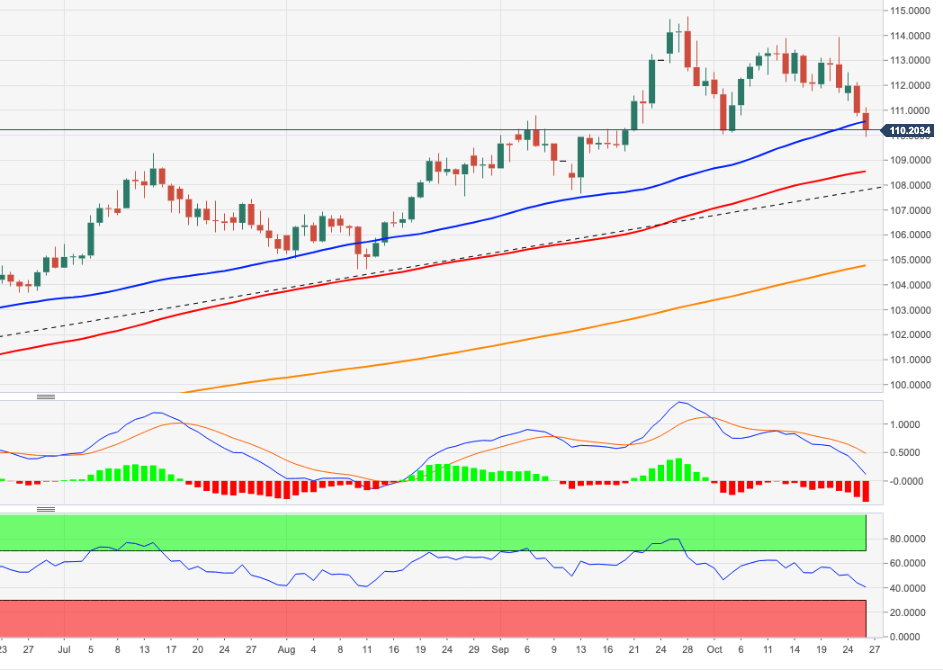
-
12:09
USD/CHF keeps the red below 0.9900 mark amid broad-based USD weakness
- USD/CHF continues losing ground for the second straight day and drops to a three-week low.
- Reduced bets for more aggressive Fed rate hikes weigh on the USD and exert some pressure.
- The lack of follow-through selling warrants some caution before positioning for further losses.
The USD/CHF pair remains under some selling pressure for the second successive day on Wednesday and retreats further from its highest level since May 2019 touched last week. The downward trajectory drags spot prices to a three-week low, around the 0.9855 area during the first half of the European session and is sponsored by the heavily offered tone surrounding the US dollar.
In fact, the USD Index, which measures the greenback's performance against a basket of currencies, dives to over a one-month low amid reduced for a more aggressive policy tightening by the Fed. Investors now expect that the US central bank will be forced to soften its hawkish stance amid signs of a slowdown in the world's largest economy. This is evident from a further decline in the US Treasury bond yields, which continues to weigh on the greenback and exerts downward pressure on the USD/CHF pair.
That said, the recent recovery in the global equity markets undermines the safe-haven Swiss franc and assists the USD/CHF pair to find some support in the vicinity of mid-0.9800s. Furthermore, traders might be reluctant to place aggressive bets and prefer to wait for a less hawkish shift from the US central bank. Hence, the focus will remain glued to the two-day FOMC monetary policy meeting next week, which will play a key role in influencing the USD and provide a fresh directional impetus to the major.
In the meantime, traders on Wednesday will take cues from the release of New Home Sales data from the US, which, along with the US bond yields, will drive the USD demand. Apart from this, the broader market risk sentiment might produce short-term trading opportunities around the USD/CHF pair. The focus, however, will be on Thursday's important US macro data, including the Advance Q2 GDP report. The market attention will then shift to the FOMC meeting and the closely-watched US NFP report next week.
Technical levels to watch
-
12:07
EUR/JPY Price Analysis: Extra gains remain on the cards
- EUR/JPY adds to the weekly recovery beyond the 147.00 mark.
- Next on the upside for the cross comes the 2022 high at 148.40.
EUR/JPY extends the corrective uptrend for the third session in a row and looks to consolidative above the 147.00 mark on Wednesday.
Considering the current price action in the cross, the door still looks open to extra upside. That said, the immediate target now emerges at the 2022 high at 148.40 (October 21) prior to the December 2014 top at 149.78 (December 8).
In the short term the upside momentum is expected to persist while above the October lows near 141.00.
In the longer run, while above the key 200-day SMA at 137.10, the broader constructive outlook should remain unchanged.
EUR/JPY daily chart

-
12:05
Singapore: Core inflation kept the uptrend unchanged – UOB
Senior Economist at UOB Group Alvin Liew and Senior FX Strategist Peter Chia review the latest publication of inflation data in Singapore.
Key Takeaways
“Headline CPI rose by 0.4% m/m, 7.5% y/y in Sep (from 0.9% m/m, 7.5% y/y in Aug), fastest y/y print since Jun 2008, and in line with Bloomberg median estimate. Core inflation (which excludes accommodation and private road transport) continued to march higher as it rose by 0.5% m/m, 5.3% y/y (from 0.5% m/m, 5.1% y/y in Aug), the highest y/y print since Nov 2008 (5.53% y/y).”
“Singapore’s inflation has continued to trend higher, with the increase in core inflation and upward pressures on services inflation particularly concerning. Earlier in the Jul CPI report, the MAS removed its previous expectation for core inflation to peak in 3Q (2022) and in the Aug CPI report, it only retained the mention that “MAS Core Inflation is projected to stay elevated over the next few months.” In the latest Sep CPI report, the MAS now projects core inflation “to stay elevated in the next few quarters before slowing more discernibly in H2 2023…” This further affirms our view that it likely means that core inflation may stay elevated for longer.”
“Inflation Outlook – MAS narrowed the inflation forecasts, with projections for 2022 headline inflation at around 6% and core inflation at around 4%, while for 2023, after taking into account all factors including the GST increase, core inflation is expected at 3.5–4.5% on average over the year, and CPI-All Items inflation at 5.5–6.5%. Even after excluding the one-off effects of the GST increase early next year, core inflation would still remain above trend at 2.5–3.5% and headline inflation at 4.5–5.5%. While we keep our 2022 headline (6.0%) and core (4.2%) inflation forecasts unchanged, we now expect headline inflation to average 5.0% and core inflation average 4.0% in 2023. Excluding the 2023 GST impact, we expect headline inflation to average 4.0% and core inflation average 3.0% in 2023.”
-
12:04
United States MBA Mortgage Applications up to -1.7% in October 21 from previous -4.5%
-
12:01
EUR/CHF points towards a stronger near-term recovery to 1.0022/69 – Credit Suisse
EUR/CHF has broken above the high from September at 0.9867, which warn of a much deeper short-term recovery to 1.0022/69, analysts at Credit Suisse report.
Fall back below 0.9641 to shift the risk lower again
“We think that a stronger near-term recovery is likely to unfold. Nonetheless, we stay medium-term bearish whilst the market remains below the falling 200-day average and the 23.6% retracement of the 2018/22 decline at 1.0022/69, where we expect a crucial barrier to be found to avoid questioning the core bearish view.”
“A fall back below 0.9641 remains seen as needed to shift the risk lower again and open the door to the YTD low at 0.9409.”
-
11:33
USD vulnerable to a further correction lower in the near-term – MUFG
The US dollar has continued to trade at weaker levels. Economists at MUFG Bank expect the greenback to extend its correction lower in anticipation of slowdown in pace of Fed hikes.
Fed officials considering delivering a smaller 50 bps hike
“While another 75 bps hike is still seen as a done deal at the next FOMC meeting on 2nd November, market participants are more hopeful now that the Fed will slow the pace of hikes at the final FOMC meeting of the year on 14th December.”
“The US rate market is currently pricing in just less than a 50:50 probability of another 75 bps hike in December. It follows the release at the end of last week of the WSJ report stating that Fed officials were considering delivering a smaller 50 bps hike. It leaves the US dollar vulnerable to a further correction lower in the near-term especially if the upcoming slowdown in the pace of hiking is confirmed by Fed speakers.”
-
11:31
USD/JPY Price Analysis: Bounces off daily low, shows some resilience below 147.00 mark
- USD/JPY remains under some selling pressure for the second straight day amid weaker USD.
- The intraday slide shows some resilience below the 23.6% Fibo. level, around the 147.00 mark.
- Any meaningful upside might confront a stiff barrier and remain capped near the 100-hour SMA.
The USD/JPY pair recovers a few pips from the daily low and is currently trading just above the 147.00 mark, still in the red for the second successive day.
The US dollar plummets to a one-month low during the first half of the European session on Wednesday and turns out to be a key factor exerting downward pressure on the USD/JPY pair. Expectations that the Fed will be forced to soften its hawkish stance amid the deteriorating US economic outlook lead to a further decline in the US Treasury bond and continues to weigh on the buck.
Apart from this, the recent market intervention by the Japanese government offers some support to the domestic currency and further contributes to the offered tone around the USD/JPY pair. Spot prices, however, show resilience below the 147.00 mark, which coincides with the 23.6% Fibonacci retracement level of a sharp fall from highest-level August 1990 touched last Friday.
From current levels, any subsequent move up is more likely to confront stiff resistance near the 147.60 region ahead of the 148.00 mark. The latter represents 38.2% Fibo. level, above which the USD/JPY pair could surpass the 148.35-148.40 intermediate hurdle and climb to the 50% Fibo. level, around the 148.75 zone, before testing the 100-hour SMA near the 149.00 round figure.
On the flip side, sustained weakness below the 147.00 mark could be seen as a fresh trigger for bearish traders and pave the way for deeper losses. The USD/JPY pair might then accelerate the fall towards the 146.30 support en route to the 146.00 mark. Spot prices could eventually drop to the next relevant support around the 145.45 region, or the weekly swing low touched on Monday.
USD/JPY 1-hour chart
-638023769661185960.png)
Key levels to watch
-
11:17
USD/CAD to move back to and probably below 1.30 next year – ING
The big event of the day is the Bank of Canada (BoC) Monetary Policy Announcement. In the view of economists at ING, the BoC should hike rates to 4%, which should certainly help the loonie.
Canadian dollar deposits soon to start paying 4%
“The BoC is expected to deliver a hawkish hike in the policy rate to 4.00%. The BoC could hike a further 75 bps in the cycle compared to the further 44 bps currently priced into the Canadian OIS curve.”
“Presumably, interest in the 4%-yielding AAA Canadian dollar securities will only build from the reserve management community. It helps as well that as an energy exporter, Canada has been on the right side of this year's terms of trade shock.”
“If equity markets can remain stable today, the hawkish BoC event risk could push USD/CAD down to 1.3500 on the day. But a sustained move below there requires a turn in the big dollar trend, which may not be a story until 2Q23.”
See – BoC Preview: Forecasts from 10 major banks, taking what is offered, a 75 bps hike
-
11:07
UK’s Hunt: Medium-term fiscal plan being delayed to November 17
UK Chancellor Jeremy Hunt announced in a statement on Wednesday, the medium-term fiscal plan is being delayed to November 17.
Additional quotes
“The delay is the best way to make sure we take the right decisions.”
“I am willing to make choices that are politically embarrassing.”
“The fiscal plan needs to be based on the most accurate forecasts possible.”
“I have discussed the delay with Bank of England Governor Bailey, he understands our reasoning.”
“The fiscal plan will show debt is falling over the medium-term.”
“Medium-term fiscal plan is extremely important.”
“Economic stability and restoring confidence is our number one priority.”
BBC News reported that the fiscal plan will be upgraded to the Uk Autumn Statement, which will be accompanied by an OBR forecast.
Market reaction
The British pound came under fresh selling pressure on Hunt’s comments, retreating to near 1.1570 after hitting a new six-week high at 1.1621 earlier on. The spot is adding 0.95% on the day.
-
10:55
GBP/USD to extend its race higher towards the 1.1820 mark – OCBC
GBP/USD extends its run higher. The break past 1.1540 opens up further gains towards 1.1820 levels, analysts at OCBC Bank report.
Benefit of doubt
“For now, it appears that markets are giving Sunak-Hunt the benefit of doubt to come up with a plan to demonstrate that the new government is committed to fiscal discipline.”
“Next resistance at 1.1540 (61.8% fibo retracement of Aug high to Sep low). Decisive break out of those levels may see GBP extend gains towards 1.1820 levels.
“Support at 1.1390 (50DMA), 1.1310 (50% fibo) and 1.1220 (21 DMA).”
-
10:43
Gold Price Analysis: XAU/USD hits two-week high, around $1,675 area amid weaker USD
- Gold climbs to a nearly two-week high on Wednesday amid the prevalent USD selling bias.
- Diminishing odds for more aggressive Fed rate hikes continue to weigh on the greenback.
- The prospects for further tightening by major central banks could cap any further upside.
Gold gains strong positive traction on Wednesday and rallied to a nearly two-week high, around the $1,675 region during the first half of the European session. The intraday move-up is exclusively sponsored by the heavily offered tone surrounding the US dollar, which tends to benefit the dollar-denominated commodity.
In fact, the USD Index, which measures the greenback's performance against a basket of currencies, hits a one-month low amid diminishing odds for a more aggressive policy tightening by the Fed. The dismal US macro data released on Tuesday pointed to deteriorating growth in the world's largest economy and might force the US central bank to soften its hawkish stance. Investors now anticipate a potential slowdown in the pace of the Fed's rate-hiking cycle. This is evident from a further decline in the US Treasury bond yields, which continues to weigh heavily on the buck and provides an additional lift to the non-yielding gold.
The Fed, however, is still expected to continue to raise interest rates in the near future to combat stubbornly high inflation. Furthermore, other major central banks - the European Central Bank and the Bank of England- are also expected to deliver a jumbo rate hike at the upcoming policy meetings. This, in turn, might hold back traders from placing aggressive bullish bets around gold. Apart from this, signs of stability in the financial markets might further contribute to capping the safe-haven XAU/USD, at least for the time being. Hence, any subsequent move up is more likely to confront resistance near the $1,780-$1,782 supply zone.
Market participants now look forward to the release of the New Home Sales data from the US for some impetus later during the early North American session. This, along with the US bond yields, will drive the USD demand and produce short-term opportunities around gold. Traders will further take cues from the broader market risk sentiment. The focus, however, will remain on important US macro data due on Thursday, which will influence the near-term trajectory ahead of the FOMC meeting and the US NFP report next week.
Technical levels to watch
-
10:42
Saudi Aramco’s CEO: Realignment is happening in oil market with Russian discounts
Amin H. Nasser, CEO of Saudi Aramco, said on Wednesday, “realignment is happening in the oil market with Russian discounts.”
Additional quotes
“There are still lots of uncertainties in the market ahead of the planned price cap on Russian oil.”
“The investment in oil is still not sufficient enough to address global demand.”
Meanwhile, Saudi Finance Minister noted, “Saudi Arabia are taking steps to stabilize the energy market.”
Market reaction
WTI was last seen trading near daily highs of $85.62, capitalizing from the relentless sell-off in the US dollar across the board.
-
10:25
AUD/USD could sustain a substantial drop to the low of 2020 at 0.5506 – Credit Suisse
AUD/USD is set to remain under pressure. Therefore, economists at Credit Suisse expect the pair to potentially dive to the low of 2020 at 0.5506.
AUD/USD to suffer a deeper decline
“With medium-term momentum staying bearish, we look for a fall to the 78.6% retracement of the 2020/21 uptrend and the low from April 2020 at 0.6041/5978 after the pause. Whilst we would not rule out another short pause here, a convincing break lower would raise a prospect for a move all the way to 0.5506 – the low of 2020.”
“We look for any attempt for a stronger move higher to be held at the falling 55-day average at 0.6651.”
-
10:21
IMF’s Georgieva: New PM Sunak to steer UK towards path of medium-term fiscal sustainability
The International Monetary Fund (IMF) Managing Director Kristalina Georgieva told Reuters on Wednesday, she expects new UK PM Sunak to steer Britain towards a path of medium-term fiscal sustainability.
She said that she will speak with British Finance Minister in the coming days.
Market reaction
The above comments have little to no impact on the pound, with GBP/USD consolidating its recent upswing to multi-week highs at 1.162. The pair is adding 1.16% on the day to trade at 1.1600, as of writing.
-
09:58
USD/JPY: Bearish momentum intact, next support aligns at 146.80 – OCBC
USD/JPY slipped below 147. Next relevant support is located at the 21-Day Moving Average (DMA) of 146.80, analysts at OCBC Bank report.
Intervention risks linger ahead of the BoJ meeting
“Bearish momentum on daily chart intact while decline in RSI moderated.”
“Expect range-bound trade, driven by USD directional bias.”
“Support at 146.80 (21 DMA), 146 levels. Resistance at 149.90, 152.”
“FX intervention risks should continue to linger ahead of the Bank of Japan MPC on Friday.”
See: USD/JPY to remain elevated while BoJ Governor Kuroda is in charge – Credit Suisse
-
09:51
USD/CNH: Still scope for a move to 7.4000 – UOB
USD/CNH could still attempt to reach the 7.4000 region in the next few weeks, comment UOB Group’s Markets Strategist Quek Ser Leang and Senior FX Strategist Peter Chia.
Key Quotes
24-hour view: “We highlighted yesterday that ‘solid upward momentum is likely to lead to further advance in USD’. We added, ‘A break of 7.3500 would not be surprising but in view of the deeply overbought conditions, 7.4000 is unlikely to come into view”. Our expectation was not wrong as USD soared to 7.3746. However, we did not expect the sharp drop from the high (low of 7.3034 in NY). Conditions remain overbought and this combined with waning momentum suggests USD is unlikely to advance further. For today, USD is more likely to consolidate and trade between 7.2950 and 7.3550.”
Next 1-3 weeks: “Yesterday (25 Oct, 7.3200), we indicated that the overbought USD rally will most likely continue. We noted that the next resistance is at 7.3500, followed by 7.4000. USD subsequently soared to a high of 7.3746 before pulling back. Upward momentum has waned somewhat with the pullback but as long as 7.2600 (no change in ‘strong support’ level from yesterday) is not breached, there is still chance for USD to rise to the major resistance at 7.4000.”
-
09:47
Gains in stocks drag DXY to early October low of 110.055 and EUR/USD to parity – SocGen
Another impressive up-day for the S&P 500 (+1.6%) leaves the US Dollar Index (DXY) vulnerable. What’s more, the EUR/USD pair has a go to parity, economists at Société Générale report.
Higher stocks lift European currencies
“The move lower in yields must be nuanced. The bulk of the flattening since last week has taken place in the long end, courtesy of mean reversion and adjustment in positioning. Moves in the front end are modest and no significant repricing has taken place in where US rates will peak next year.”
“But at the current rate of gains in stocks, the DXY will soon test the early October low of 110.055 and EUR/USD will have a go at parity.”
“European currencies led by SEK, GBP, NOK and EUR are shining for a change as we approach month-end.”
-
09:45
USD/CNY set for a move to 7.4220/7.4540 – Credit Suisse
USD/CNY remains in a clear uptrend looks set for further medium-term strength. Economists at Credit Suisse expect the pair to chllagenge the 7.4220/7.4540 resistance zone.
Fresh upside territory
“Next resistance is seen at the 61.8% retracement of the 2005/14 downtrend and the trendline from late 2016 at 7.4220/7.4540, where we would look for at least a temporary pause. Nonetheless, a convincing break above here would raise a prospect of rising all the way to the 78.6% retracement at 7.7978, where we would have greater confidence of a solid cap.”
“Whilst we look for 7.0810 to hold any abrupt leg lower, a break below would see scope to test the 55-day moving average at 7.0093, which we would expect to hold to avoid a potentially deeper correction.”
-
09:37
USD/CAD weakens further below mid-1.3500s, refreshes multi-week low ahead of BoC
- USD/CAD dives to a three-week low amid the prevalent USD selling bias.
- Diminishing odds for more aggressive Fed rate hikes weigh on the buck.
- Subdued oil prices to undermine the loonie and limit losses ahead of BoC.
The USD/CAD pair remains under heavy selling pressure for the second straight day and drops to a three-week low during the first half of the European session on Wednesday. The downward trajectory drags spot prices to the 1.3530 area in the last hour and is exclusively sponsored by the heavily offered tone surrounding the US dollar.
In fact, the USD Index, which measures the greenback's performance against a basket of currencies, plummets to a one-month low amid diminishing odds for a more aggressive policy tightening by the Fed. The recent US macro data pointed to signs of a slowdown in the world's largest economy and might force the US central bank to soften its hawkish stance. This is evident from a further decline in the US Treasury bond yields, which, in turn, continues to weigh on the buck and exert some follow-through downward pressure on the USD/CAD pair.
With the latest leg down, spot prices confirm a fresh bearish breakdown below the 1.3600 mark and seem vulnerable to sliding further. That said, subdued crude oil prices could undermine the commodity-linked loonie and help limit losses for the USD/CAD pair. The American Petroleum Institute (API) reported on Tuesday that US crude inventories grew more than anticipated, by 4.5 million barrels in the week of October 21. This, along with worries that a deeper economic downturn will dent fuel demand, act as a headwind for black liquid.
The mixed fundamental backdrop warrants some caution before positioning for a further depreciating move. Traders might also prefer to move to the sidelines ahead of the Bank of Canada monetary policy decision, due to be announced later during the early North American session. The Canadian central bank is expected to hike interest rates by 75bps. Hence, the focus will be on the accompanying policy statement and the post-meeting press conference.
Investors will look for clues if the BoC will shrug off the looming recession risk and continue with its aggressive policy tightening path or signal a dovish tilt. This, in turn, will play a key role in influencing the Canadian dollar and provide some meaningful impetus to the USD/CAD pair. The market attention will then turn to important US macro releases, including the Advance GDP report for the September quarter, on Thursday.
Technical levels to watch
-
09:25
EUR/USD surpasses parity and rose to 5-week tops
- EUR/USD gathers extra steam above the parity zone.
- The dollar remains well on the defensive as risk appetite improves.
- Consumer Confidence in France surprises to the upside in October.
The optimism around the European currency remains well and sound for yet another session and this time lifts EUR/USD to the area beyond the parity level for the first time in the last five weeks on Wednesday.
EUR/USD boosted by dollar weakness
EUR/USD advances for the 5th consecutive session and trades in multi-week highs on the back of the acute sell-off in the greenback, which forced the USD Index (DXY) to challenge October lows in the vicinity of the 110.00 support.
Adding to the decline in the dollar comes another pullback in US yields across the curve in line with the negative price action seen so far in the German 10-year bund, which sheds ground for the 4th session in a row.
The renewed upbeat tone in the risk-associated universe comes in tandem with rising speculation that the Fed might slow the pace of its normalization process in the next months amidst some loss of momentum in some key US fundamentals.
In the domestic calendar, Consumer Confidence in France improved to 82 for the month of October in what was the sole release in the calendar on Wednesday.
Across the ocean, weekly Mortgage Applications tracked by MBA come next seconded by flash trade balance figures and New Home Sales.
What to look for around EUR
EUR/USD keeps pushing higher and already leaves behind the psychological parity region with decent conviction amidst the renewed and marked offered stance in the dollar.
In the meantime, price action around the European currency is expected to closely follow dollar dynamics, geopolitical concerns and the Fed-ECB divergence. Following latest results from key economic indicators, the latter is expected to extend further amidst the ongoing resilience of the US economy.
Furthermore, the increasing speculation of a potential recession in the region - which looks propped up by dwindling sentiment gauges as well as an incipient slowdown in some fundamentals – adds to the sour sentiment around the euro
Key events in the euro area this week: France Consumer Confidence (Tuesday) -Germany GfK Consumer Confidence, Italy Consumer Confidence, ECB Interest Rate Decision, ECB Lagarde (Thursday) – France/Italy/Germany Flash Inflation Rate, Germany Preliminary Q3 GDP Growth Rate, EMU Final Consumer Confidence, Economic Sentiment
Eminent issues on the back boiler: Continuation of the ECB hiking cycle vs. increasing recession risks. Impact of the war in Ukraine and the persistent energy crunch on the region’s growth prospects and inflation outlook.
EUR/USD levels to watch
So far, the pair is gaining 0.62% at 1.0023 and faces the next up barrier at 1.0050 (weekly high September 20) followed by 1.0092 (100-day SMA) and finally 1.0197 (monthly high September 12). On the flip side, the breakdown of 0.9631 (monthly low October 13) would target 0.9535 (2022 low September 28) en route to 0.9411 (weekly low June 17 2002).
-
09:22
Gold Price Forecast: XAU/USD to struggle as high inflation keeps central banks on a tightening cycle – ANZ
Inflation is soaring everywhere. Therefore, central banks are hiking rates, pummeling the yellow metal.
Investment demand is bleak
“Inflation remains stubbornly high, so monetary policy is likely to tighten further. US benchmark yields are likely to rise given the hawkish tone from the US Federal Reserve. This is providing support to the currency. These remain headwinds for gold.”
“Gold investment demand has suffered. Physical demand remains strong, with spot premiums rising in Asia. This is offsetting some of the weakness in the investment sector.”
See – Gold Price Forecast: XAU/USD could soar when end to aggressive rate hikes comes into view – Commerzbank
-
09:14
GBP/USD hits fresh multi-week high, eyes 1.1600 mark amid notable USD supply
- GBP/USD climbs to a fresh six-week high and is supported by a combination of factors.
- The appointment of Rishi Sunak as the new British PM continues to underpin sterling.
- Diminishing odds for more aggressive Fed rate hikes weigh heavily on the greenback.
The GBP/USD pair catches fresh bids during the early European session and climbs to its highest level since September 14, around the 1.1575-1.1580 region in the last hour.
Investors welcomed the appointment of Rishi Sunak as the new British Prime Minister. This is evident from a further decline in the UK gilt yields, which continues to underpin the British pound. Apart from this, the prevalent US dollar-selling bias provides an additional lift to the GBP/USD pair and remains supportive of the momentum.
In fact, the USD Index, which measures the greenback’s performance against a basket of currencies, dives back closer to the monthly low amid reduced bets for a more aggressive tightening by the Fed. Tuesday's weaker US macro data pointed to signs of a slowdown in the world's largest economy and might force the Fed to soften its hawkish stance.
The repricing of the Fed's rate-hiking path leads to an extension of the recent downfall in the US Treasury bond yields, which, in turn, is seen weighing on the buck. Adding to this, signs of stability in the financial markets dents the greenback's safe-haven status and support prospects for a further appreciating move for the GBP/USD pair.
Even from a technical perspective, a convincing break through the 1.1480 supply zone and a subsequent move beyond the 1.1500 psychological mark adds credence to the positive outlook. That said, worries about a deeper global economic downturn might cap the optimism and hold back bulls from placing aggressive bets around the GBP/USD pair.
Market participants now look forward to the release of New Home Sales data from the US. This, along with the US bond yields and the broader risk sentiment, will drive the USD and provide some impetus to the GBP/USD pair ahead of important US macro releases on Thursday. The focus will then shift to the FOMC meeting and the NFP report next week.
Technical levels to watch
-
09:12
USD/JPY still looks consolidative for the time being – UOB
According to UOB Group’s Markets Strategist Quek Ser Leang and Senior FX Strategist Peter Chia, USD/JPY remains stuck within the 144.00-152.00 range in the near term.
Key Quotes
24-hour view: “Yesterday, we held the view that USD ‘could continue to trade in a choppy manner, likely between 147.40 and 150.10’. USD subsequently traded within a narrower range than expected (147.51/149.09). The underlying tone has softened and USD is likely to edge lower for today. That said, any decline is likely limited to a test of 147.00. Resistance is at 148.50, followed by 149.00.”
Next 1-3 weeks: “We continue to hold the same view as yesterday (25 Oct, spot at 148.80). As highlighted, the recent volatile price actions have resulted in a mixed outlook. Further volatility is not ruled out and USD could trade within a wide range of 144.00/152.00 for the time being.”
-
09:09
USD Index challenges monthly lows near 110.00
- The index extends the weekly leg lower to the vicinity of 110.00.
- The risk complex picks up extra pace on speculation around Fed’s pivot.
- Housing data, Trade Balance results next on tap in the docket.
The greenback, when gauged by the USD Index (DXY), loses further momentum and approaches the 110.00 area, or 5-week lows, on Wednesday.
USD Index weaker on risk-on mood, Fed
The index adds to Tuesday’s losses and extends further the recent weakness amidst the extra improvement in the sentiment surrounding the risk-linked galaxy on Wednesday.
Indeed, speculation that a Fed’s pivot could be closer than many have expected keeps weighing on the buck and undermines further the price action around the dollar and sustains the decline in US yields.
In the US data space, the weekly MBA Mortgage Applications is due seconded by advance Goods Trade Balance results and New Home Sales.
What to look for around USD
The dollar accelerates the corrective decline and trades closer to the key suppoer at the 110.00 neighbourhood midweek.
In the meantime, the firmer conviction of the Federal Reserve to keep hiking rates until inflation looks well under control regardless of a likely slowdown in the economic activity and some loss of momentum in the labour market continues to prop up the underlying positive tone in the index.
Looking at the more macro scenario, the greenback also appears bolstered by the Fed’s divergence vs. most of its G10 peers in combination with bouts of geopolitical effervescence and occasional re-emergence of risk aversion.
Key events in the US this week: MBA Mortgage Applications, New Home Sales, Building Permits, Advanced Goods Trade Balance (Wednesday) – Flash Q3 GDP Growth Rate, Durable Goods Orders (Thursday) – PCE/Core PCE Price Index, Personal Income/Spending, Pending Home Sales, Final Michigan Consumer Sentiment (Friday).
Eminent issues on the back boiler: Hard/soft/softish? landing of the US economy. Prospects for further rate hikes by the Federal Reserve vs. speculation of a recession in the next months. Geopolitical effervescence vs. Russia and China. US-China persistent trade conflict.
USD Index relevant levels
Now, the index is retreating 0.70% at 110.11 and the breach of 110.05 (weekly low October 4) would open the door to 109.35 (weekly low September 20) and finally 107.68 (monthly low September 13). On the other hand, the next up barrier lines up at 113.88 (monthly high October 13) seconded by 114.76 (2022 high September 28) and then 115.32 (May 2002 high).
-
09:03
USD Index to hold the big psychological level of 110 – ING
The dollar has softened a little this week. US Dollar Index stays below 111 but economists at ING expect the DXY to hold above the 110 psychological level.
It is too early to declare the 'all-clear' for equity markets
“It does feel like it is too early to declare the 'all-clear' for equity markets – e.g. the Fed could well push US real rates deeper into restrictive territory – meaning that we are treating this dollar decline as corrective.”
“110 is a big psychological level for DXY and we would assume that it would hold ahead of another 75 bps hike from the Fed next week.”
-
09:01
European Monetary Union M3 Money Supply (3m) climbed from previous 5.8% to 6% in September
-
09:01
Italy Trade Balance non-EU increased to €-5.44B in September from previous €-5.792B
-
09:00
European Monetary Union Private Loans (YoY) meets forecasts (4.4%) in September
-
09:00
European Monetary Union M3 Money Supply (YoY) above forecasts (6.1%) in September: Actual (6.3%)
-
09:00
Switzerland ZEW Survey – Expectations came in at -53.1 below forecasts (-43.8) in October
-
08:59
AUD/USD: Further upside lies ahead near term – UOB
In light of the recent price action, further recovery in AUD/USD appears well on the cards for the time being, note UOB Group’s Markets Strategist Quek Ser Leang and Senior FX Strategist Peter Chia.
Key Quotes
24-hour view: “We did not expect the strong surge in AUD that sent it to a high of 0.6412 (we were expecting sideway-trading). While overbought, the rapid rise in AUD could test 0.6420 first before the risk of a pullback increases. AUD is unlikely to challenge the major resistance at 0.6460. Support is at 0.6365 but only a break of 0.6340 would indicate that the current upward pressure has eased.”
Next 1-3 weeks: “Yesterday (25 Oct, spot at 0.6330), we noted that the underlying tone for AUD appears to have firmed. We indicated that AUD has to move and stay above 0.6410 before a sustained advance is likely. AUD subsequently rose to 0.6412 before closing on a strong note at 0.6394 (+1.28%). Upward momentum has improved and AUD is likely to edge higher to the major resistance at 0.6460. On the downside, a break of the ‘strong support’ at 0.6305 (level was at 0.6220 yesterday) would indicate that the build-up in momentum has fizzled out.”
-
08:57
Japan’s Matsuno: Important to keep enough FX reserves to support own currency
Japan Chief Cabinet Secretary Matsuno said on Wednesday that it is “important to keep enough foreign reserves to support own currency in case of sharp and excessive market volatility.
His comments come after the Kyodo News Agency reported that Japan will likely spend JPY25.1 trillion ($170 billion) in its upcoming economic stimulus package.
-
08:40
EUR/USD: Break of 1.00 could trigger quite a sharp short squeeze to 1.02 – ING
EUR/USD continues to edge higher toward the key parity level. A break above here could trigger a sharp short squeeze to 1.02, economists at ING report.
Next week's Fed meeting could provide some more support to the dollar
“It has been several weeks in the making, but it does now seem that EUR/USD is responding to the lower natural gas prices and the improvement in the terms of trade position. We should be a little careful here since EUR/USD is now threatening to break out of a bearish channel that has contained price action all year. That means a break of 1.00 could trigger quite a sharp short squeeze to 1.02 and at the very least slow the rate (5% per quarter) of this year's EUR/USD decline.”
“It is probably a question then of whether the 1.00 level can hold EUR/USD up to and including tomorrow's ECB meeting, before next week's Fed meeting could provide some more support to the dollar.”
-
08:34
AUD/USD climbs to three-week high, around mid-0.6400s amid sustained USD selling
- A combination of supporting factors lifts AUD/USD to a nearly three-week high on Wednesday.
- Hotter-than-expected Australian CPI report boosts the aussie amid sustained USD selling bias.
- Reduced bets for more aggressive Fed rate hikes and sliding US bond yields weigh on the USD.
The AUD/USD pair gains traction for the second successive day on Wednesday and builds on its intraday ascent through the early European session. This also marks the fourth day of a positive move in the previous five and lifts spot prices to a nearly three-week high, around the 0.6450-0.6455 region in the last hour.
The US dollar remains under some selling pressure amid reduced bets for a more aggressive tightening by the Fed, which, in turn, is seen as a key factor pushing the AUD/USD pair higher. In fact, the softer US macro data released on Tuesday pointed to signs of a slowdown in the world's largest economy and might force the US central bank to soften its hawkish stance. This is reinforced by a further pullback in the US Treasury bond yields and keeps the USD bulls on the defensive.
The Australian dollar, on the other hand, draws additional support from hotter-than-expected domestic consumer inflation figures. The Australian Bureau of Statistics (ABS) reported that the headline CPI rose 1.8% in the September quarter and the annual rate shot up to 7.3% - the highest since 1990. The data suggests that the Reserve Bank of Australia may have acted prematurely in slowing the pace of policy tightening in October and will need to raise rates to combat inflation.
The combination of fundamental factors pushes the AUD/USD pair through the 0.6400-0.6410 resistance zone, prompting some technical buying. This might have also set the stage for a further appreciating move. That said, a softer risk tone - amid growing worries about a deeper global economic downturn, might hold back traders from placing aggressive bullish bets around the risk-sensitive aussie. This warrants caution for bulls and positioning for any further gains.
Market participants now look forward to the US economic docket, featuring the release of New Home Sales data later during the early North American session. This, along with the US bond yields and the broader risk sentiment, will influence the USD price dynamics and provide some impetus to the AUD/USD pair. The focus will then shift to important US macro releases on Thursday, which should determine the near-term trajectory ahead of the FOMC meeting and the NFP report next week.
Technical levels to watch
-
08:32
UK Finance Minister Hunt spoke to BOE Governor Bailey on Tuesday – Reuters
Citing sources, Reuters reported on Wednesday, UK Finance Minister Hunt spoke to BOE Governor Bailey on Tuesday.
Uk Finance Minister Hunt reaffirmed his commitment to the bank's independence and inflation target and both agreed to work closely to restore confidence and stability in the UK economy, Reuters said.
Market reaction
GBP/USD is gathering upside traction above 1.1500, mainly driven by an extended US dollar sell-off alongside the Treasury yields. The pair is rallying 0.70% on the day at 1.1549, as of writing.
-
08:25
GBP/USD: Breach of 1.15 clears the way towards 1.1750 – ING
The pound took another leg higheron Tuesday. Economists at ING expect the pair to extend its race higher towards 1.1750 on a break past 1.15.
EUR/GBP to move within a 0.8650-08750 near-term trading range
“1.1500 is clearly a big level in GBP/USD. A break could see the correction extend to 1.1750. But such a correction would more likely be driven by a global re-assessment of risk ($ negative) than a further re-rating of UK prospects.”
“0.8650-08750 looks to be the EUR/GBP near-term trading range.”
-
08:16
RBA cash rate to peak at 3.85% on accelerating inflation – ANZ
Inflation in Australia rose more than expected in the third quarter. Subsequently, economists at ANZ Bank have upgraded their RBA cash rate forecasts.
Higher inflation to extend into 2023
“We have upgraded our RBA cash rate forecasts on the back of the upside surprise in the Q3 CPI data, adding a 25 bps hike in December this year to take the peak to 3.85% in May 2023.”
“A 50 bps rise in November is possible, but we think the RBA will prefer to hike more frequently than shift back to 50 bps, given the reasoning behind the decision to go 25 bps in October.”
“We see higher inflation extending into 2023 due to both the stronger Q3 data and the upside risks ahead given continuing cost pass-through, flooding, lower AUD and evidence of persistence in inflationary pressures globally.”
-
08:11
Inflation tends to slow to drift lower again when hits levels as high as right now – Deutsche Bank
When inflation hits 8% throughout history, what happens next? Economists at Deutsche Bank take a dispassionate look at how inflation has evolved following previous spikes.
Should we have been so surprised by the stickiness of inflation?
“The evidence shows that once inflation spikes above 8%, median inflation takes around 2 years to even fall beneath 6%, before settling around that level out to 5 years after the initial 8% shock. This is around 2pp above the pre-shock median of c. 4%.”
“The current consensus expects us to be back at or even below 3% just two years after we initially moved above 8%. This is far from impossible, but it would be around the 25th percentile of observations through history, and around 4pp beneath the median outcome.”
-
08:04
USD/ILS set to climb towards 3.65 later in Q4 – Credit Suisse
General elections will be held in Israel on Tuesday, November 1. Ahead of general elections, economists at Credit Suisse continue to expect USD/ILS to rise towards 3.65 later in the fourth quarter.
Ready to buy USD/ILS on possible dips on “clean” election outcome
“The latest polls show a tie between former Prime Minister Netanyahu’s right-wing bloc and the one led by current Prime Minister Yair Lapid. Although this points to possible lingering political uncertainty, we do not expect much of an impact on the shekel.
“We continue to expect USD/ILS to rise towards 3.65 later in Q4.”
“We would view possible short-term pullbacks in USD/ILS on the back of a clear election outcome as a buying opportunity.”
-
07:59
Ex-US Treasury Sec. Mnuchin: I believe we have recession in the US
Former US Treasury Secretary Steven Mnuchin said on Wednesday that “I believe we have a recession in the US,” adding “I believe it will continue.”
Additional quotes
US and China have to learn how to co-exist.
Middle East economic issues need to be dealt with regionally .
-
07:58
USD/CNH: Q$ forecast range raised to 7.10-7.55 – Credit Suisse
USD/CNH has reached the top end of Credit Suisse’s forecasted 7.00-7.35 trading range. Therefore, the Q4 USD/CNH target has been revised to 7.10-7.55.
Continuity in economic policy points to further “flexibility” on the exchange rate
“President Xi did not specifically mention FX policy during his Work Report speech, but continuity in economic policy points to further ‘flexibility’ on the USD/CNY exchange rate.”
“Tuesday’s USD/CNY fix (to 7.1668, an increase of 438 pips) ‘broke’ the previous USD/CNY fix range of 7.10-7.12 seen since 10 October, confirming that yuan weakness can continue.”
“We expect negative sentiment in China equities to continue spilling over into the yuan, and now raise our Q4 USD/CNH forecast range to 7.10-7.55.”
-
07:57
USD/CAD: Loonie to benefit short-term if the BoC hikes by 75 bps – Commerzbank
The market is likely to keep a close eye on the rate decision as well as the Bank of Canada’s projections in its new monetary policy report. The loonie could enjoy some gains in the short-term if the BoC delivers a 75 basis points hike as expected, economists at Commerzbank report.
If the BoC only hikes by 50 bps, the loonie is set to lose further ground
“We expect that CAD will be able to benefit short-term if the BoC hikes its key rate by 75 bps with the market considering its statement to be hawkish. Increasing fears of a recession might constitute a fly in the ointment though, which would reduce possible gains.”
“If the BoC does not meet expectations today and only hikes the key rate by 50 bps the loonie is likely to lose further ground against the USD. Downside pressure on USD/CAD would increase further if the BoC then also issued a dovish statement.”
See – BoC Preview: Forecasts from 10 major banks, taking what is offered, a 75 bps hike
-
07:56
Forex Today: Dollar stays on the backfoot following Tuesday's selloff
Here is what you need to know on Wednesday, October 26:
Following the disappointing macroeconomic data releases from the US on Tuesday, the greenback came under heavy selling pressure and the US Dollar Index (DXY) lost more than 1%. The DXY is struggling to stage a rebound early Wednesday and stays below 111.00 despite the risk-averse market mood as reflected by falling US stock index futures. September Goods Trade Balance and New Home Sales data will be featured in the US economic docket later in the day. More importantly, the Bank of Canada (BoC) will announce its monetary policy decisions.
On Tuesday, the US data revealed that home prices continued to decline at an accelerating pace in August. Moreover, the Conference Board's Consumer Confidence Index declined to 102.5 in October from 107.8 in September, missing the market expectation of 105.9. According to the CME Group FedWatch Tool, the probability of a 50 basis points rate (bps) hike in December after a 75 bps hike in November climbed to 50% from only 22% last week. Consequently, the benchmark 10-year US Treasury bond yield lost more than 3% on the day.
The BoC is expected to raise its policy rate by 75 bps to 4% from 3.25%. Previewing the event, "it seems unlikely that the bank will decide to shift gears and slow down the pace of tightening, as it remains committed to raising rates until inflation is brought under control. In case it does, the crucial details could be outlined in the MPR accompanying the rate decision," said FXStreet Analyst Dhwani Mehta. USD/CAD was last seen trading at its lowest level in three weeks below 1.3600.
BOC Preview: Getting ready for a dovish pivot?
During the Asian trading hours, the data from Australia showed that the Consumer Price Index (CPI) climbed to 7.3% on a yearly basis in the third quarter from 6.1% in the second quarter. Fueled by hot inflation data and the broad dollar weakness, AUD/USD gathered bullish momentum and was last seen rising 0.5% on the day at 0.6430.
USD/JPY lost nearly 100 pips on Tuesday and closed below 149.00 following Monday's volatile action. The pair stays relatively quiet at around 147.80 in the early European session mid-week.
GBP/USD took advantage of the dollar selloff and climbed to 1.1500 for the first time since mid-September late Tuesday before going into a consolidation phase below that level.
EUR/USD gained traction during the American trading hours on Tuesday and gained nearly 100 pips on the day. The pair continues to edge higher toward the key parity level in the European morning.
Gold capitalized on falling US Treasury bond yields and staged a decisive rebound late Tuesday. XAU/USD preserves its bullish momentum on Wednesday and trades above $1,660.
Bitcoin benefited from risk flows and climbed above the key $20,000 level after having spent the last couple of weeks below it. Similarly, Ethereum gained nearly 9% on Tuesday and extended its rally toward $1,500 early Wednesday.
-
07:53
FX option expiries for Oct 26 NY cut
FX option expiries for Oct 26 NY cut at 10:00 Eastern Time, via DTCC, can be found below.
- EUR/USD: EUR amounts
- 0.9850 750m
- 0.9900 1.7b
- 0.9910 1.3b
- 0.9950 755m
- 1.0000 1.4b
- GBP/USD: GBP amounts
- 1.1500 953m
- USD/JPY: USD amounts
- 145.00 485m
- 148.15 560m
- USD/CHF: USD amounts
- 0.9910 375m
- AUD/USD: AUD amounts
- 0.6200 802m
- 0.6300 700m
- 0.6520 377m
- 0.6550 562m
- USD/CAD: USD amounts
- 1.3635 310m
- 1.3725 473m
- NZD/USD: NZD amounts
- 0.5720 381m
- 0.5950 351m
- EUR/GBP: EUR amounts
- 0.8400 500m
-
07:50
USD/BRL to test the 30 Aug lows around 5.01 on a clear victory by Bolsonaro – Credit Suisse
Economists at Credit Suisse restate their 5.00-5.50 USD/BRL target range ahead of the final round of presidential elections on 30 October and preview FX implications of different political outcomes.
A Lula victory can produce some degree of local investor disappointment
“A clear victory by President Bolsonaro is likely to be the most constructive for BRL, consistent with a rapid re-test of the 30 Aug lows in USD/BRL around 5.01.”
“We suspect that any recently re-emerged fears of postelection turbulence would likely be quickly vanquished in the event of a Bolsonaro victory, adding reasons for BRL strength to local investors’ well-documented preference for the incumbent over the opposition candidate.”
“While a Lula victory can produce some degree of local investor disappointment, we also remain of the view that any ensuing rallies in USD/BRL towards the top end of our 5.00-5.50 target range will rapidly attract sellers – as long as the pre-vote promises by Lula about picking an ‘orthodox’ finance minister are realized.”
“We do not have a strong reason to expect a significantly different cabinet choice in the event of a Lula victory, but if this widely held assumption were to falter, the risk of a deeper correction in BRL past 5.50 would increase sharply.”
-
07:45
France Consumer Confidence registered at 82 above expectations (77) in October
-
07:45
EUR/CHF still has some upside scope – Commerzbank
EUR/CHF is trading close to parity again. Economists at Commerzbank believe that the pair could extend its advance.
Swiss National Bank can still sit back for now
“During the last monetary policy evaluation, the head of the SNB Thomas Jordan had pointed out that the franc would contribute to dampening inflation pressure: at the time CHF had appreciated by 7% since June.”
“The franc has not completely retraced its gains which might explain why the SNB can still sit back for now. However, it also means that EUR/CHF still has some upside scope until the SNB might begin to feel unhappy about the developments.”
-
07:41
Gold Price Forecast: XAU/USD needs acceptance above 21DMA to confirm bullish reversal
Gold price is looking to build on to the previous recovery from sub-$1,650 levels. Will XAU/USD regain hold above 21DMA? FXStreet’s Dhwani Mehta analyzes the yellow metal's technical picture.
Initial support aligns at $1,650
“Gold price is looking to test the 21-Daily Moving Average (DMA) at $1,668 on the road to recovery. Daily closing above the latter will confirm a bullish reversal from near 2022 lows of $1,615. The next upside barrier is seen at Monday’s high of $1,671. Further up, buying resurgence will be seen above the October 13 high at $1,683, as buyers target the $1,700 threshold.”
“On the downside, the $1,650 psychological support will be challenged, at first. It’s critical for bulls to defend the previous day’s low of $1,638. A breach of the last will reopen the downside towards $1,600.”
-
07:38
USD/JPY to remain elevated while BoJ Governor Kuroda is in charge – Credit Suisse
Ahead of the Bank of Japan (BoJ) decision, economists at Credit Suisse still expect the USD/JPY to trade on a solid foot.
Limited prospect for a major turn in actual BoJ policy before April 2023
“Last week, we said we were not inclined to fade USD/JPY strength, even with the pair trading near our 150 target. With no visibility on the outcome of this week’s BoJ decision and no strong indications that a change is imminent beyond a shift in market expectations, we still do not see a strong urge to adopt a different approach for now.”
“In the event that the BoJ was indeed to signal a change in forward guidance, a dip further towards the lower end of our Q4 140-150 target range is possible, but far from a given, given the backdrop of already fairly aggressive market expectations.”
“We are also sceptical of the view that a minor change in forward guidance would trigger a deeper or longer-lasting correction, given our sanguine view on Fed tightening and the still limited prospect for a major turn in actual BoJ policy before the end of Governor Kuroda’s term, in April 2023.”
-
07:37
Silver Price Analysis: XAG/USD climbs back above mid-$19.00s, bulls flirt with 100-day SMA
- Silver climbs back closer to a nearly two-week high touched on Monday.
- Bulls await a move beyond the 100-day SMA before placing fresh bets.
- A break below the $18.00 mark is needed to negate the positive outlook.
Silver builds on the previous day's bounce from the 200-hour SMA support and gains some follow-through traction for the second successive day on Wednesday. The positive move lifts the white metal back above the mid-$19.00s during the early European session, closer to a nearly two-week high touched on Monday.
The XAG/USD is currently flirting with the 100-day SMA barrier, which if cleared decisively should pave the way for a further near-term appreciating move. Meanwhile, oscillators on hourly charts are holding in the bullish territory and have just started moving in the positive zone on the daily chart. This, in turn, supports prospects for an eventual breakout through the aforementioned barrier.
The XAG/USD might then aim to surpass the $20.00 psychological mark and climb further towards the next relevant hurdle near the $20.50 region. Bulls might then aim to reclaim the $21.00 round-figure mark. The latter coincides with the 200-day EMA, above which the momentum could eventually lift spot prices back towards the monthly swing high, around the $21.25 region.
On the flip side, the $19.20 area now seems to protect the immediate downside ahead of the $19.00 mark and the 200-hour SMA, currently around the $18.80 region. A convincing break below might prompt some technical selling and make the XAG/USD vulnerable to accelerate the fall towards the $18.30-$18.25 intermediate support en route to the next relevant support near the $18.00 round figure.
Failure to defend the latter will negate any near-term positive bias and shift the bias back in favour of bearish traders. The subsequent downfall has the potential to drag the XAG/USD further towards the YTD low, around the $17.55 area touched in September. The downward trajectory could get extended to the next relevant support near the $17.00 round-figure mark.
Silver 1-hour chart
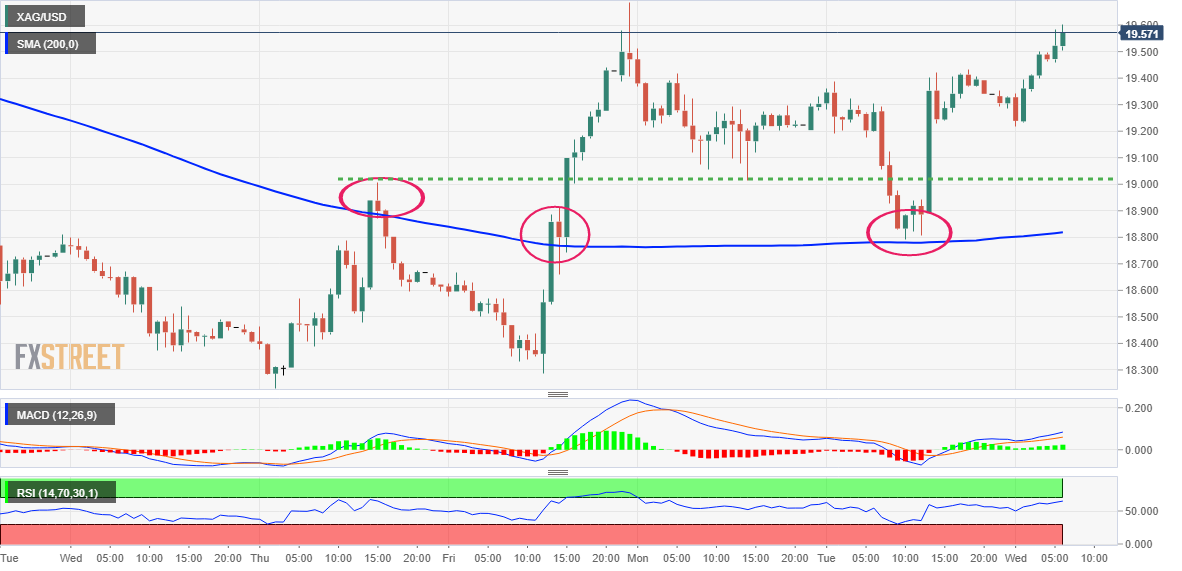
Key levels to watch
-
07:27
EUR/USD: It is still too early to expect a sustainable reversal – Commerzbank
EUR/USD managed to climb well above the 0.99 mark again on Tuesday. Is the reversal in EUR/USD sustainable? In the view of economists at Commerzbank, there are still a number of vagaries that might soon lead to a deterioration in euro sentiment.
Fall in energy prices might provide some relief at least this month
“The eurozone is unlikely to avoid a recession not least due to the significantly increased energy prices, which eroded purchasing power, over past months. But at least the mild weather means that it can start into the winter as well-prepared as possible. And the significant fall in energy prices, in particular the gas price, might provide some relief at least this month.”
“It is still too early to expect a sustainable reversal. Only yesterday the head of the IEA warned that ‘the world is not out of the woods yet’ as regards gas supplies. He pointed out that in case of an economic recovery in China, global supplies of LNG might soon become tighter which would constitute a challenge for Europe as it has to replace Russian gas imports over the winter.”
-
07:18
NZD/USD juggles around 0.5750 as the focus shifts to US GDP data
- NZD/USD is oscillating in a 12-pip range as investors await US GDP data.
- US households are bound to postpone their new home demand due to higher interest obligations.
- ANZ Business Confidence dropped to -42.7 VS. projections of 42.0 and the prior release of -36.7.
The NZD/USD pair has delivered a north-side break of the consolidation formed in a narrow range of 0.5740-0.5752 in the early European session. The asset is advancing towards the round-level resistance of 0.5800 as the risk-on impulse is aiming to regain the glory.
S&P500 futures witnessed a vertical fall in early Asia led by weaker guidance from tech-giant Microsoft (MSFT), however, the three-day buying spree in the 500-stock basket indicates sheer optimism in the overall market structure. The US dollar index (DXY) is struggling to sustain above 111.00 and a subdued performance could accelerate volatility in the counter.
Meanwhile, returns on US government bonds are declining sharply amid positive market sentiment. The 10-year US Treasury yields have dropped to 4.07% and have still not displayed any sign of exhaustion.
For further guidance, investors are awaiting the release of the US Gross Domestic Product (GDP) data. As per the projections, the US economy has grown at 2.4% rate vs. a decline of 0.6% reported earlier in the third quarter of CY2022. It would be worth watching the placement of the GDP figures in comparison with the projections as Monday’s PMI numbers reported by S&P were lower than expectations.
But before that, the US New Home Sales data will display the condition of the US real estate market. The economic catalyst is seen lower at 0.585M vs. the prior release of 0.685M on a monthly basis. In addressing mounting inflationary pressures, the Federal Reserve (Fed) is continuously accelerating interest rates. This has resulted in higher interest obligations for households, which has forced them to postpone their demand for new homes.
In early Tokyo, ANZ Business Confidence dropped further to -42.7 against the projections of 42.0 and the prior release of -36.7. The kiwi dollar didn’t react much to the qualitative data, therefore, the entire focus will remain on the DXY’s movement and risk profile.
-
07:17
UK’s Cleverly: Can't confirm if budget will come on October 31
UK Foreign Minister James Cleverly said on Wednesday that they “can't confirm if it will come on October 31.”
Additional quotes
PM Ssunak will want to take time to look at the detail of the fiscal statement.
We know it needs to come soon.
Market reaction
At the time of writing, GBP/USD is advancing 0.08% on the day at 1.1473, cheering renewed US dollar selling.
-
07:00
Sweden Trade Balance (MoM) registered at -1.8B above expectations (-8.8B) in September
-
06:58
USD/JPY struggles to gain any meaningful traction, stuck in a range around 148.00 mark
- A combination of diverging forces fails to provide any impetus to USD/JPY on Wednesday.
- The UD languishes near a multi-week low amid a further pullback in the US bond yields.
- The Fed-BoJ policy divergence continues to act as a tailwind and helps limit the downside.
- Traders also seem to prefer to wait on the sidelines ahead of the BoJ decision on Thursday.
The USD/JPY pair struggles to gain any meaningful traction and oscillates in a narrow band through the first half of trading on Wednesday. The pair is currently placed just above the 148.00 mark and remains well within the previous day's broader trading range.
The US dollar languishes near a three-week low and turns out to be a key factor acting as a headwind for the USD/JPY pair. The softer US macro data released on Tuesday pointed to signs of a slowdown in the world's largest economy and might force the Federal Reserve to its hawkish stance. This led to a further decline in the US Treasury bond yields, which continues to weigh on the greenback.
The Japanese yen, on the other hand, draws support from the recent currency market intervention by the government. Apart from this, a softer tone around the equity markets offers additional support to the safe-haven JPY. That said, a bid divergence in the policy stance adopted by the US central bank and the Bank of Japan helps limit the downside for the USD/JPY pair, at least for the time being.
The Fed is still expected to hike interest rates by 75 bps in November and continue with its policy tightening path, albeit at a slower pace. The BoJ, on the other hand, remains committed to its ultra-loose monetary policy settings. This, in turn, suggests that the path of least resistance for the USD/JPY pair is to the upside, though bulls seem reluctant ahead of the BoJ meeting on Thursday.
Heading into the key central bank event risk, reluctance to place aggressive bets could lead to an extension of the USD/JPY pair's range-bound price action. Market participants now look to the US New Home Sales data for some impetus later during the early North American session. This, along with the US bond yields, and the broader market risk sentiment might influence the major.
Technical levels to watch
-
06:51
BoC Preview: Forecasts from 10 major banks, taking what is offered, a 75 bps hike
The Bank of Canada (BoC) is set to announce its interest rate decision on Wednesday, October 26 at 14:00 GMT and as we get closer to the release time, here are the expectations as forecast by the economists and researchers of 10 major banks, regarding the upcoming announcement.
The Bank of Canada (BoC) is on track to deliver another 75 basis points (bps) hike, raising its policy rate from 3.25% to 4.00%. The bank’s Monetary Policy Report (MPR) will be published parallelly at the time of the interest rate decision. Governor Tiff Macklem’s press conference at 15:00 GMT will be also closely scrutinized for the bank’s next policy move.
BMO
“We are now expecting a like-sized 75 bps hike from the BoC. This would take the overnight rate to 4.0%, and we suspect that will not be the end of it – pencilling in a 25 bps move in December.”
ING
“In Canada, the central bank is under pressure to hike rates a further 75 bps given the upside surprise in inflation. Job creation has also returned and consumer activity is holding up so we agree that 75 bps is the most likely outcome having previously forecast a 50 bps hike.”
TDS
“We look for the BoC to lift its policy rate by 75 bps in October due to stubbornly broad and persistent underlying inflation. We expect an additional 25 bps move in December with a terminal rate of 4.25%, as rapidly slowing growth will warrant a pause in the new year. The CAD is doomed. The higher that rates go, the greater the downside macro shock and the more the CAD needs to reflect it.”
RBC Economics
“We expect a 50 bps increase to take the overnight rate to 3.75%. That’s smaller And risks remain that the central bank could go bigger: markets are currently leaning toward a 75 bps increase. We continue to expect higher inflation and interest rates to push Canada into a moderate recession in the first half of next year. That would put the central bank in a position to pause interest rate hikes by the end of 2022. And indeed, we expect the overnight rate to end the year at 4%. But risks to that assumption are still tilted to the upside, and are contingent on broader inflation trends showing further evidence of slowing.”
NBF
“Expect the BoC to hike the overnight target rate 75 bps to 4%. That would make 375 ps of cumulative tightening via six consecutive decisions. Wednesday’s hike may not be the last and the BoC will likely be reticent to wave the ‘all clear’ via forward guidance, at least until inflation is more controlled. But by pushing rates into decisively restrictive territory more quickly, it’s less obvious to us that rates will need to move up much further. Wednesday’s rate announcement will be followed by a press conference in which policymakers could signal a turn towards a more data dependant approach for the BoC.”
CIBC
“We suspect that still hot inflation (even excluding food/energy) will tip the Bank into another 75 bps interest rate hike, rather than the 50 bps move that we had previously anticipated. However, policymakers will soon have to find a creative way to pause this rate hike cycle, without damaging its inflation-fighting credibility, while they wait to assess how the economy is coping with the rate hikes that have already been delivered.”
Citibank
“While it is a very close call between a 50 bps hike or a 75 bps hike, we still lean towards expecting a 50 bps hike but still expect a significant hawkish emphasis that rates are still likely to rise further and expect another 50 bps hike in December taking the policy rate to 4.25% before a pause, but with risks that hikes continue into 2023 and reach a higher terminal rate.”
Rabobank
“We expect the Bank of Canada to raise rates another 75 bps, taking the policy rate up to 4.00%. Canada has not felt interest rates that high since the beginning of 2008. We are likely to see significant repricing of the curve and FX volatility in the aftermath of the decision. This will be compounded by the release of a new Monetary Policy Report and all the projections within, and volatility won’t end there given that Governor Macklem will hold a press conference an hour after the decision. In short, this week’s decision could prove a lively one for BoC watchers and CAD traders.”
Wells Fargo
“We do expect the BoC to raise interest rates, although the 50 bps policy rate increase to 3.75% that we forecast would be smaller than the rate hikes delivered at the July and September announcements.”
BofA
“We expect the BoC to slow down the pace and hike the overnight rate by 50 bps to 3.75%. Inflation and inflation expectations remain high and the labor market is still tight, so another higher-than-normal rate hike is very likely. Still, the risk of another 75 bps hike is relatively high.”
-
06:51
Asian Stock Market: Rebounds despite weak S&P500 futures, DXY remains mute, PBOC intervenes
- Asian indices have rebounded firmly despite the absence of support from S&P500 futures.
- The PBOC has intervened in currency markets to provide a cushion for the weakening yuan.
- The DXY is declining towards a two-week low at 110.76 while alpha on US government bonds has tumbled.
Markets in the Asian domain have rebounded sharply after individual headwinds despite a vertical fall in the S&P500 futures. The 500-stock futures basket has tumbled 0.90% after a three-day buying spree as tech-giant Microsoft (MSFT) has trimmed its sales growth forecast by 5%. In the opinion of economists at Morgan Stanley, the rally in S&P500 could be extended well into the 4000/4150 area. Therefore, a decline in the US index could be considered a corrective move.
At the press time, Japan’s Nikkei225 gained 0.84%, ChinaA50 jumped 1.15%, and Hang Seng soared 1.43%. Indian markets are closed on account of Diwali Balipratipada.
Chinese markets have rebounded sharply as investors have shrugged off uncertainty that rose after China’s XI Jinping’s leadership for the third term got the green signal. Meanwhile, Reuters reported that the People’s Bank of China (PBOC) intervened in currency markets to support the weakening yuan. Reports claim that Chinese state-owned banks sold U dollars both in onshore and offshore markets on Tuesday.
Japanese investors have shifted their focus towards the interest rate decision by the Bank of Japan (BOJ), scheduled on Friday. BOJ Governor Haruhiko Kuroda is expected to continue dovish tone on interest rates to safeguard the economy against external shocks. Prolonged weakness in the Japanese yen is impacting importers dramatically. Purchases of imported goods from oil to food products need US dollars for payouts, which are hurting firms that bank upon raw materials from foreign suppliers.
On the US dollar index (DXY) front, the mighty DXY is displaying a sheer downside move after failing to sustain above the 111.00 hurdle. The DXY is expected to surrender the two-week low of 110.76 amid overall optimism in market spirit. The 10-year US Treasury yields have dropped further to 4.08%.
-
06:43
Natural Gas Futures: Rebound has further legs to go
Considering advanced prints from CME Group for natural gas futures markets, open interest resumed the uptrend and rose by around 1.2K contracts on Tuesday. Volume, in the same direction, increased by almost 41K contracts and partially reversed the previous daily drop.
Natural Gas now looks at the 200-day SMA
Prices of the natural gas extended the rebound from multi-month lows (October 24) amidst rising open interest and volume on Tuesday, hinting at the view that further recovery stays on the cards in the very near term. The next up barrier of note, in the meantime, appears at the 200-day SMA, today at $6.718 per MMBtu.
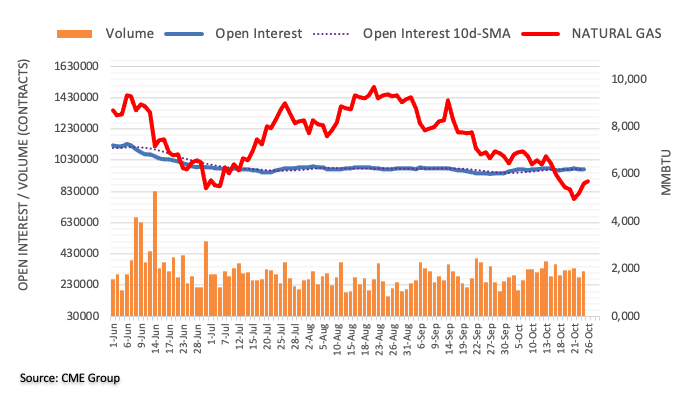
-
06:36
Crude Oil Futures: Further range bound looks likely
CME Group’s flash data for crude oil futures markets noted traders added around 3.1K contracts to their open interest positions on Tuesday, adding to the previous daily build. In the same line, volume reversed three daily retracements in a row and rose by nearly 30K contracts.
WTI: The next support of note comes at $80.00
Prices of the WTI traded in a volatile fashion and ended Tuesday’s session with small gains. The move was amidst increasing open interest and volume and leaves the door open to the continuation of the current consolidation. On the downside, prices face the next contention at the key $80.00 mark per barrel.
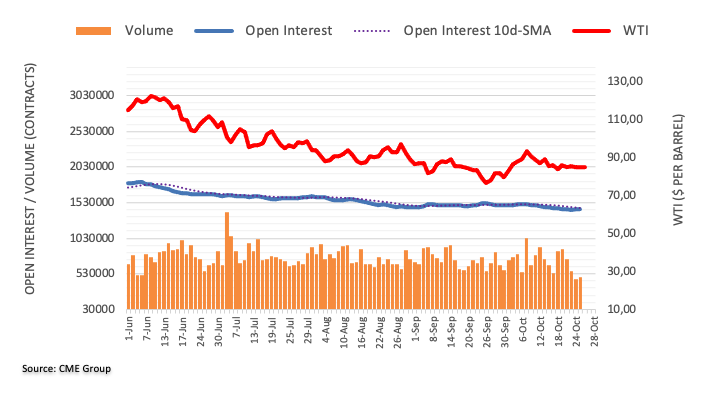
-
06:26
GBP/USD: Next resistance comes at 1.1600 – UOB
In the opinion of UOB Group’s Markets Strategist Quek Ser Leang and Senior FX Strategist Peter Chia, GBP/USD could now target the 1.1600 region in the near term.
Key Quotes
24-hour view: “Our expectation for GBP to trade sideways yesterday was incorrect as it lifted off in NY trade and surged to 1.1500 before easing to close at 1.1472 (+1.68%). The sharp and swift rally appears to be overdone but GBP could test 1.1520 first before easing. For today, the next resistance at 1.1600 is unlikely to come into view. On the downside, 1.1380 is likely strong enough to hold any intraday pullback (minor support is at 1.1420).”
Next 1-3 weeks: “We highlighted yesterday (25 Oct, spot at 1.1300) that GBP is mildly supported and could edge higher. We added, “any advance is expected to face solid resistance at 1.1440”. The anticipated resistance did not materialize as GBP blew past 1.1440 and surged to 1.1500. The strong boost in momentum is likely to lead to further GBP strength. The next resistance is at 1.1600. The GBP strength is intact as long as it does not move below 1.1310 (‘strong support’ level was at 1.1150 yesterday).”
-
06:17
Gold Futures: Probable continuation of the rebound
Open interest in gold futures markets increased for the second session in a row on Tuesday, this time by around 11.8K contracts according to preliminary readings from CME Group. Volume followed suit and went up by around 25.5K contracts, extending the ongoing choppiness.
Gold now targets $1,730
Gold prices posted decent gains on Tuesday and partially faded the retracement seen at the beginning of the week. The uptick was on the back of rising open interest and volume and allows for further gains in the very near term. Further recovery in the precious metal is expected to target the October high at $1,729 per ounce troy.
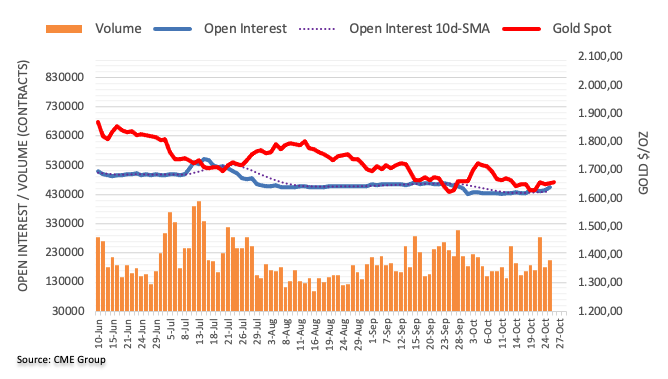
-
06:15
Gold Price Forecast: XAU/USD extends gains after picking bids around $1,650, yields eye 4%
- Gold price has recovered firmly to near $1,650.00 amid a subdued DXY’s performance.
- The risk-on profile is attempting to regain traction as yields have slipped further below 4.10%.
- This week, the US GDP will be a key event for making informed decisions.
Gold price (XAU/USD) has extended its gains to near $1,657.50 after a firmer recovery from the critical support of $1,650.00. The precious metal is expected to remain on the tenterhooks as investors are awaiting the release of the US Gross Domestic Product (GDP) data, which will release on Thursday.
The risk profile is displaying mixed responses as the S&P500 futures are attempting a rebound after dropping significantly in Tokyo. Meanwhile, the US dollar index (DXY) has failed to sustain above the round-level resistance of 111.00, which indicates a decline in safe-haven’s appeal.
Alpha generated by US Treasuries is looking for more downside as investors have ditched the risk-aversion theme. The 10-year US Treasury yields have dropped below 4.10% and the current downside momentum could weigh more pressure ahead.
On Thursday, the release of the US GDP data is expected to bring sheer volatility in gold prices. As per the preliminary estimates, the US growth rate for the third quarter of CY 2022 is 2.4% against a negative rate of 0.6% reported earlier.
Gold technical analysis
On an hourly scale, gold prices have bounced back sharply after dropping below the horizontal support placed from Thursday’s high at $1,640.55. The downward-sloping trendline placed from October 13 high at $1,682.53 will act as major resistance for the gold prices ahead.
The precious metal is expected to display a sideways movement ahead as the Relative Strength Index (RSI) (14) has shifted into the 40.00-60.00 range. The 20-period Exponential Moving Average (EMA) near $1,651.50 is acting as major support for the counter.
Gold hourly chart

-
06:07
USD/CAD battles 1.3600 as bears stay in control ahead of BOC
- USD/CAD is consolidating the downside ahead of the BOC expected 75 bps hike.
- Upbeat Asian markets take the wind out of the USD recovery, WTI trades listlessly.
- The pair looks to test the 1.3565 support after the rising wedge breakdown.
USD/CAD is trading on the defensive while keeping its range around the 1.3600 level, as the US dollar recovery fizzles out amid a strong advance in Asian equities. Investors shrug off the drop in the S&P 500 futures, led by the downbeat earnings reports of Microsoft and Alphabets after the US markets close.
The lackluster performance in the WTI price is also doing little to help the loonie extend its previous rally, as the US oil remains confined around the $84.50 mark. The major also remains weighed down by weaker US Treasury yields amid fading hopes of the Fed continuing its aggressive rate hike track amid slowing economic activity in America.
All eyes now turn towards the Bank of Canada (BOC) rate hike decision, with a 75 bps rate increase fully baked in after another beat in the Canadian inflation data. However, economists are expecting the central bank to shift towards a dovish pivot, in the face of growing recession risks. With inflation still hot, the BOC could stick to its pledge of the need for further rate increases until inflation is brought down.
From a short-term technical perspective, USD/CAD is holding the lower ground after confirming a rising wedge breakdown last Friday.
That said, the downside remains exposed towards the monthly lows at 1.3502. Ahead of that, the October 6 low at 1.3565 could come to buyers’ rescue.
The 14-day Relative Strength Index (RSI) has pierced through the midline for the downside, implying that the tide has turned against bulls.
USD/CAD: Daily chart
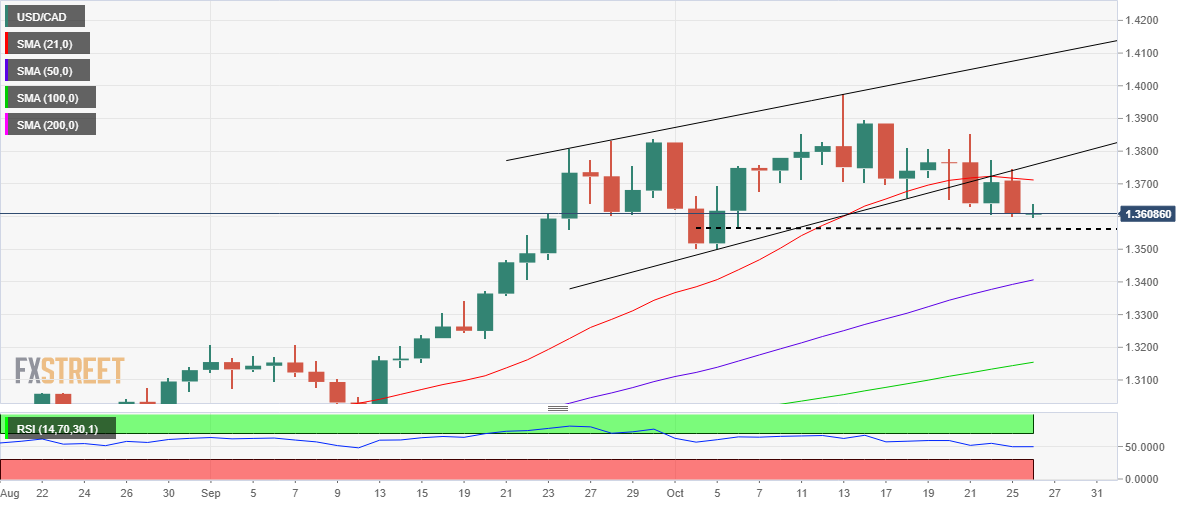
On the flip side, any upside attempt will need to clear the mildly bearish 21-Daily Moving Average (DMA) at 1.3711. Acceptance above the latter will put the wedge support-turned-resistance at 1.3758 under threat.
Daily closing above the latter will call for a fresh uptrend towards the 1.3800 round figure.
USD/CAD: Additional levels to consider
-
06:04
Japan Leading Economic Index above forecasts (100.9) in August: Actual (101.3)
-
06:04
Japan Coincident Index came in at 101.8, above expectations (101.7) in August
-
06:01
Singapore Industrial Production (MoM) registered at 0%, below expectations (1.1%) in September
-
06:00
Singapore Industrial Production (YoY) came in at 0.9%, below expectations (1.3%) in September
-
06:00
EUR/USD: Rising bets for a breakout of parity – UOB
UOB Group’s Markets Strategist Quek Ser Leang and Senior FX Strategist Peter Chia suggest EUR/USD could surpass the parity zone in the next few weeks.
Key Quotes
24-hour view: “We noted yesterday that ‘upward momentum is building’ and we expected EUR to strengthen. However, we were of the view that ‘the chance of EUR breaking the major and solid resistance at 0.9935 is not high’. The build-up in momentum surpassed our expectation as EUR easily took out 0.9935 and surged to a 3-week high of 0.9976. The strong boost in momentum suggests EUR is likely to strengthen further. In view of the overbought conditions, EUR might not be able to maintain a foothold above 1.0000 (the next resistance at 1.0050 is unlikely to come under threat). Support is at 0.9935, followed by 0.9905.”
Next 1-3 weeks: “Yesterday (25 Oct, spot at 0.9885), we indicated that the risk for EUR is shifting to the upside but it has to break through 0.9935 first before a sustained advance is likely. While our view of the upside risk in EUR was correct, we did not expect the rapid manner in which EUR jumped above 0.9935 (EUR soared to a high of 0.9976 in NY trade). Upward momentum has increased further and there is a high chance of EUR breaking 1.0000. The next resistance is at 1.0050. Overall, the current EUR strength appears to have room to extend in the coming days and only a break of 0.9850 (‘strong support’ level was at 0.9780 yesterday) would indicate that EUR is unlikely to advance further.”
-
05:37
EUR/USD advances towards 1.0000 amid hawkish ECB bets, US GDP eyed
- EUR/USD is marching towards parity as the odds of a bigger rate hike by the ECB have strengthened.
- Mixed responses from the risk profile have put the DXY on the sidelines.
- The US GDP data is seen higher at 2.4% vs. a decline of 0.6%.
The EUR/USD pair is juggling in a 0.9943-0.9969 range in the Tokyo session amid a quiet market mood. The asset has turned sideways after a perpendicular upside move and is looking to kiss the parity ahead as bets have soared for a bigger rate hike by the European Central Bank (ECB). Market sentiment has been hit amid a decent drop in S&P500 futures after Microsoft (MSFT) announces a cut in sales growth projections. However, the overall market spirit is upbeat.
The US dollar index (DXY) is continuously performing lackluster in Tokyo after a sheer drop from 112.00 in the late New York session. The mighty DXY is playing around 111.00. Also, the 10-year US Treasury yields have felt the heat of sheer demand for US government bonds and have dropped to 4.10%.
This week, the release of the US Gross Domestic Product (GDP) data will be a major trigger. As per the projections, the US economy has grown at a 2.4% rate vs. a decline of 0.6% reported earlier in the third quarter of CY2022. It would be worth watching the placement of the GDP figures in comparison with the projections as Monday’s PMI numbers reported by S&P were lower than expectations.
On the Eurozone front, the odds of a gas price mechanism announcement are gaining more attention. Talking on the European energy crisis, Germany’s Economy Minister Robert Habeck said on Tuesday that they “expect the gas price mechanism decision at the next EU Council.” He further added that “Joint EU purchases are the best way to keep the gas price low,”
Going forward, ECB President Christine Lagarde is set to announce a second consecutive 75 basis point (bps) rate hike, as per analysts at Rabobank. Projections of 75 bps rate hike have also been approved by Economists at ING. In addition to that, they believe that the hike should fail to offer substantial and long-lasting support to the euro.
-
05:02
AUD/USD Price Analysis: Prepares for an impulsive rally, 0.6400 a key hurdle
- Aussie bulls are aiming to refresh three weeks’ high above 0.6410.
- The asset is completely out of the woods after a two-week range breakout.
- The RSI (14) has shifted into the bullish range of 60.00-80.00.
The AUD/USD pair has displayed topsy-turvy moves in a range of 0.6372-0.6400 in the Tokyo session. The asset is hovering around intraday’s high as the US dollar index (DXY) has slipped again below the 111.00 mark.
Meanwhile, risk impulse is mixed as S&P500 futures have witnessed losses in morning trade after a three-day buying spell. The 10-year US Treasury yields have slipped further to 4.09%.
On a four-hour scale, the asset is completely out of the woods after a breakout of the consolidation formed in a two-week range of 0.6200-0.6356. The major is hovering around the immediate hurdle of 0.6411 recorded on Monday. A small consolidation near weekly highs is acting as an inventory accumulation phase before an impulsive rally.
The 20-and 50-period Exponential Moving Averages (EMAs) at 0.6343 and 0.6325 respectively are advancing, which indicates that the trend has shifted towards the north.
Also, the Relative Strength Index (RSI) (14) has shifted into the bullish range of 60.00-80.00, which indicates more gains ahead.
Going forward, a decisive break above Monday’s high at 0.6411 will strengthen the aussie bulls. This will drive the asset towards October 4 low at 0.6451, followed by October 4 high at 0.6548.
On the flip side, a downside break of Thursday’s low at 0.6229 will drag the asset toward the fresh two-year low at 0.6170 and April 2020 low at 0.5991.
AUD/USD four-hour chart

-
04:57
GBP/USD remains pressured around 1.1450 as US dollar recovers
- GBP/USD is consolidating its retreat around 1.1450 as the US dollar finds demand in Asia.
- Investors turn cautious amid discouraging US tech giants’ earnings, flaggings recession fears.
- Cable buyers will hold the fort so long as the price stays above the bearish 50DMA.
GBP/USD is consolidating the latest pullback from six-week highs of 1.1499, as the US dollar finds fresh demand amid a cautious market mood.
The safe-haven dollar is staging a modest comeback after disappointing US corporate earnings from the tech titans Microsoft and Alphabet marred a three-day rally on Wall Street and knocked off S&P 500 futures by 1%. The below forecast results from tech giants hinted at possible early signs of a slowdown in the US economy.
However, the pair remains supported by the advances in the Asian indices, as investors remained hopeful that the pace of US and global rate hikes will start to slow. Further, the pound also cheers the UK Prime Minister Rishi Sunak taking office, with eyes on his fiscal plan. Reports were doing the rounds on Tuesday that Sunak could delay its budget announcement beyond October 31.
The focus now shifts towards the US economic releases due later in the day, especially after the country’s CB Consumer Confidence Index rose to 108.00 in September from 103.6 in August (revised from 103.2). The US New Home Sales, Goods Trade Balance and Wholesale Inventories data will be closely eyed for fresh implications on the Fed rate hike outlook. The UK political and fiscal updates will also have a significant impact on the sentiment around the pound.
The spot could extend the retreat should the US dollar recovery gather strength on the renewed weakness in the Wall Street stocks, as investors digest the downbeat earnings and brace for another batch of corporate results.
GBP/USD: Technical levels
-
04:47
USD/CNY drops below 7.30 afte PBOC intervenes in FX market
The Chinese yuan was once again rescued by the People’s Bank of China (PBOC) after Reuters reported, citing sources, major Chinese state-owned banks sold US dollars in both onshore and offshore markets in late trade on Tuesday.
One of the sources said that “the selling of dollars by state banks in early US trading hours lifted the yuan.”
The other source also spotted such state banks' dollar selling in the onshore market late in the Asian day.
“It was unusual for the domestic branches of China's big banks to be active in onshore trades during London or New York trading hours,” the sources said.
Market reaction
In an immediate reaction to the above headlines, USD/CNY came under renewed selling pressure and surrendered the 7.30 level. The pair is trading at 7.2903, down 0.21% on the day, as of writing. The yuan has been hitting successive record lows in recent days, reflecting a strengthening dollar and worries over a slowing Chinese economy.
-
04:23
WTI rebounds from $84.00 ahead of EIA data, central banks’ policies remain key
- Oil prices have picked bids around $84.00 after a corrective move.
- The EIA is expected to report a build-up of oil inventories by 0.2M barrels.
- Hawkish monetary policies by global central banks may impact oil demand ahead.
West Texas Intermediate (WTI), futures on NYMEX, have rebounded after dropping to near $84.00 in the Tokyo session. The oil prices corrected in the late New York session after reporting healthy gains as the American Petroleum Institute (API) displayed a build-up of stockpiles for the last week ending October 24.
The oil stockpiles reported addition of 4.52M barrels of oil which indicates a decline in oil demand last week. It is worth noting that the US administration is releasing oil from the Strategic Petroleum Reserve (SPR) to address cuts in the global oil supply by OPEC. Therefore, the oil inventory buildup could be the outcome of additional oil infusion.
A tug of war between distinct ideologies of the US administration and the oil cartel as the former has pledged to weaken oil prices to trim global inflationary pressures while the latter believed the oil prices are imbalanced and are required to be stabilized with production cuts.
US President Joe Biden announced that the oil released from SPR will be replenished once oil prices will drop below $70.00.
Going forward, the critical oil report from Energy Information Administration (EIA) will display a true picture of oil inventories. As per the projections, the EIA report will report a marginal build-up of oil by 0.2M barrels.
Meanwhile, the People’s Bank of China (PBOC) has announced a liquidity infusion of CNY 280B through seven-day Reverse Repo at 2% through open market operations.
This week, monetary policies from global central banks will be the major trigger. The Bank of Canada (BOC), the European Central Bank (ECB), and the Bank of Japan (BOJ) will announce their interest rate decision. The BOC and ECB are expected to deliver a hawkish stance while the BOJ would stick to its dovish remarks.
-
04:11
BOC Preview: Laser-focus on whether central banks will “pivot” – Goldman Sachs
Analysts at Goldman Sachs offer a sneak peek at what to expect from Wednesday’s Bank of Canada (BOC) interest rate decision.
Key quotes
"This week's Bank of Canada meeting is a close call, with consensus split on whether they will take another step down in the hiking pace after more mixed activity news and a slightly softer Business Outlook Survey, but still-firm inflation.”
"This could have important implications for CAD; the market is laser-focused on whether central banks will "pivot" or at least "fall off the pace" of the Fed.”
“So far this year, the Canadian Dollar has been a clear outperformer due to the BoC's aggressive actions and the loonie's tight links with the USD. However, as recent AUD depreciation demonstrates, if the BoC gives the impression that it is starting to take a more balanced approach, then CAD would probably see some of that outperformance fade.”
-
03:30
Gold Price Forecast: XAU/USD buyers stay hopeful whilst above $1,644 – Confluence Detector
- Gold price has faltered on its previous rebound as the US dollar makes a comeback.
- Cooling aggressive Fed rate hike calls, China concerns and dismal US tech earnings weigh on risk sentiment.
- XAU/USD sees range play amid battle lines well-defined ahead of critical US events.
Gold price is treading water in a familiar range around the $1,650 psychological level, lacking a follow-through upside bias amid a modest comeback staged by the US dollar across the board. The risk-off flows have returned to markets, as disappointing earnings from the US tech giants, Microsoft and Google, revived recession fears and revived the dollar’s safe-haven appeal. However, the risk-aversion-driven weakness in the Treasury yields combined with easing aggressive Fed rate hike expectations keep the downside cushioned in the bright metal. Investors also refrain from placing big bets on the bullion ahead of the critical event risks, including the ECB rate hike decision and the US advance Q3 GDP, scheduled later this week. The US corporate earnings reports and China’s covid updates will be closely followed for any impact on the risk sentiment, which will be pivotal for fresh dollar and gold valuations.
Also read: Markets steady as investors eye earnings and ECB
Gold Price: Key levels to watch
The Technical Confluence Detector shows that the gold price is flirting with a bunch of healthy support levels at around $1,650, the convergence of the SMA50 one-hour, SMA10 one-day and the previous low four-hour.
The next cushion is placed at $1,648, where the Fibonacci 61.8% one-day meets with the Fibonacci 38.2% one-week.
The last line of defense for XAU buyers is envisioned at $1,644, the intersection of the SMA5 one-day and Fibonacci 23.6% one-month.
Alternatively, gold price needs to clear the convergence of the Fibonacci 23.6% one-week and one-day at $1,657. A firm break above the latter will trigger a fresh upswing towards the Fibonacci 38.2% one-month at $1,660.
The previous day’s high at $1,662 will be next on buyers’ radars.
Here is how it looks on the tool
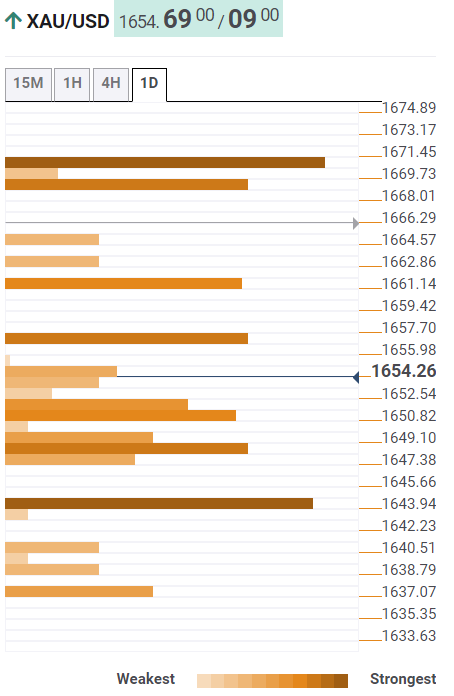
About Technical Confluences Detector
The TCD (Technical Confluences Detector) is a tool to locate and point out those price levels where there is a congestion of indicators, moving averages, Fibonacci levels, Pivot Points, etc. If you are a short-term trader, you will find entry points for counter-trend strategies and hunt a few points at a time. If you are a medium-to-long-term trader, this tool will allow you to know in advance the price levels where a medium-to-long-term trend may stop and rest, where to unwind positions, or where to increase your position size.
-
03:30
Commodities. Daily history for Tuesday, October 25, 2022
Raw materials Closed Change, % Silver 19.347 0.67 Gold 1653.14 0.19 Palladium 1931.4 -1.5 -
03:22
Australian Treasurer Chalmers: Don’t expect inflation forecast to change markedly
Australia's Treasurer Jim Chalmers said on Wednesday, the government doesn’t expect the inflation forecast to change markedly.
He added that “we expect inflation to peak around the same level at end of year.”
This comes after the Australian Consumer Price Index (CPI) rose to 7.3% QoQ in the September quarter.
Market reaction
AUD/USD remains pressured below 0.6400 amid risk-aversion, unable to capitalize on Australia’s hot inflation data. The pair is trading at 0.6388, down 0.07% on the day.
-
03:01
EUR/USD consolidates after a wild ride on Tuesday, bulls eye parity ahead of ECB and Fed
- EUR/USD is under pressure in Asia, unable to cling to the high seen overnight.
- The US dollar was sold off heavily in a switch-up in market sentiment.
EUR/USD rallied hard to the upper quarter of the 0.99 area and bulls were eyeing a move into parity before the day was up but were left stranded in a phase of consolidation. In Asia, there has been little in the way of follow-through and the price has trickled lower between 0.9967 and 0.9943.
Federal Reserve officials are in a quiet period through the Nov. 1-2 Federal Open Market Committee meeting and sentiment is left to dictate the direction of markets based on economic data. A change of heart is apparent in fixed income and risk on appetite has dominated the week as investors ponder as to whether the Federal Reserve's path of interest rate hikes is about to switch up due to the cracks in the economy. Consequently, this has been sinking yields and the US dollar along with it.
The dollar index, DXY, which measures the greenback vs. a basket of currencies fell to a low of 110.759 on Tuesday from a high of 112.127 in a sizeable drop that led to strong and rapid gains in risk assets and forex, such as the euro. The index is now below the 111 mark, a level not seen in almost three weeks, as speculation that the Federal Reserve would slow the pace of interest rate hikes later this year has diminished the greenback's appeal.
ECB in focus
In the eurozone, business expectations improved modestly in October according to data released earlier Tuesday, but the current assessment declined, leaving the business climate measure virtually unchanged. The European Central Bank meets on Thursday when a 75 basis point increase is expected.''We expect the ECB to repeat Sep's 75bps hike at the Oct meeting, taking the Depo Rate to 1.50%, and leaving it arguably in the middle of the range that the ECB considers being "neutral", analysts at TD Securities said. ''While the growth outlook has deteriorated recently, with inflation surging to 9.9%, the ECB will likely emphasise the risk that higher inflation expectations become entrenched.''
-
02:44
BOJ buys more bonds than planned at regular operation
The Bank of Japan (BOJ) on Wednesday offered to purchase more Japanese government bonds (JGBs) across various maturities at its scheduled Open Market Operation (OMO).
Key details
BOJ offers to purchase 575bln yen of 3-5 year JGBs.
BOJ offers to purchase 650bln yen of 5-10 year JGBS.
BOJ offers to purchase 350bln yen of 10-25 year JGBs.
BOJ offers to purchase 150bln yen of >25 year JGBs.
Market reaction
At the time of writing, USD/JPY is off the 148.37 daily highs, trading at 148.25, still up 0.25% on the day.
-
02:36
AUD/NZD bulls move in on 1.1150 but capped despite strong Aussie CPI data
- AUD/NZD bulls perk up on CPI data released from Australia.
- Aussie CPI beats estimates and raises prospects of a more hawkish RBA.
Australia’s third quarter Consumer Price Index has put a bid into AUD crosses. AUD/NZD is trading at 1.1125 and has travelled between a low of 1.1097 and a high of 1.1144. The data has raised expectations that the Reserve Bank of Australia could be more aggressive when it meets next week and hence AUD rallied. Financial markets have all but priced in another quarter-point hike from the Reserve Bank of Australia in November, and cash rates are expected to peak around 4.3%.
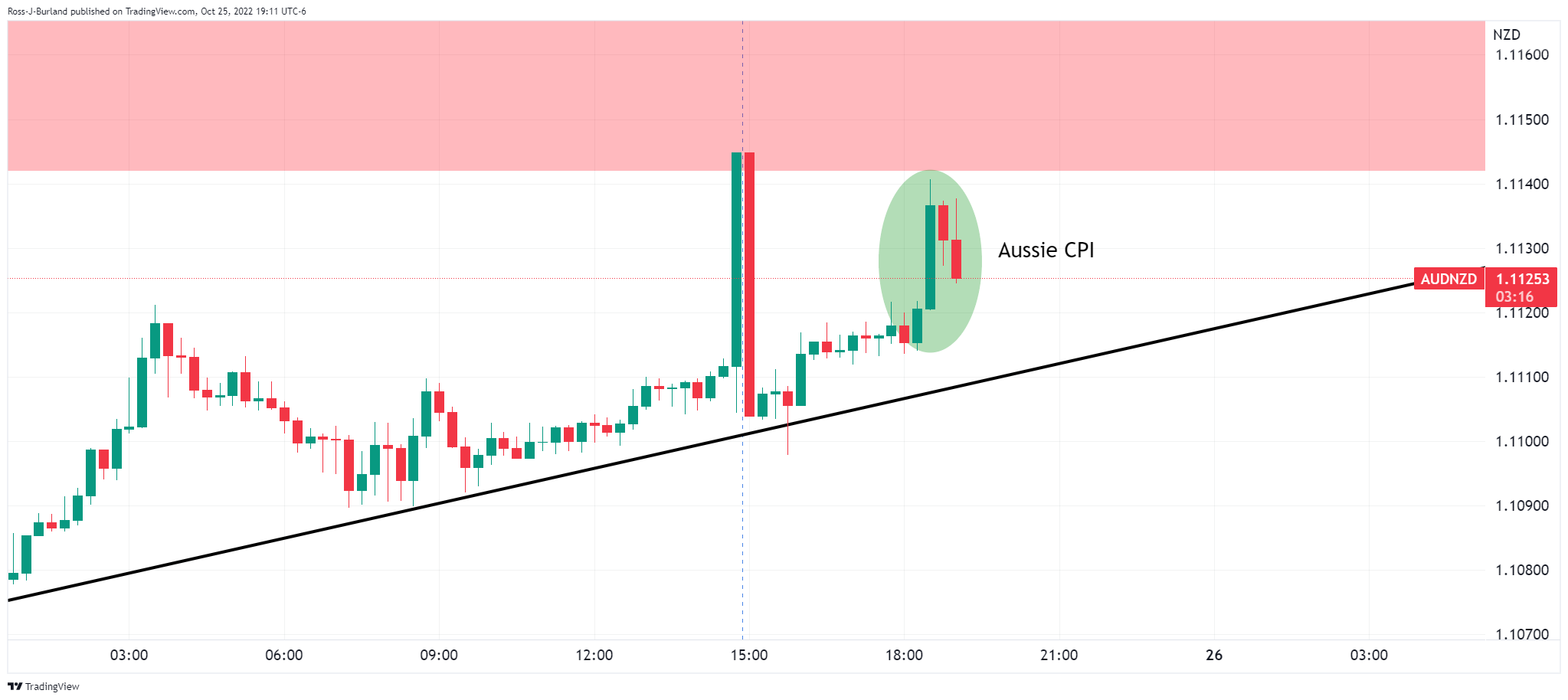
Aussie CPI
- Australia Q3 RBA trimmed mean CPI +1.8% QoQ (Reuters poll +1.5 pct).
- Australia Q3 CPI (all groups) +1.8 pct QoQ (Reuters poll +1.6 pct).
- Australia Q3 RBA weighted median CPI +1.4% QoQ (Reuters poll +1.5 pct).
- Australia Q3 RBA trimmed mean CPI +6.1% YoY (Reuters poll +5.6 pct).
- Australia Q3 RBA weighted median CPI +5 % YoY (Reuters poll +4.8 pct).
Meanwhile, Australian and New Zealand currencies are recovering from the concerns about China's prospects under new party leaders and the poor data released as the greenback is falling back below the 111 mark, a level not seen in almost three weeks. Speculation that the Federal Reserve would slow the pace of interest rate hikes later this year boosted appetites for the high beta currencies such as the Aussie and kiwi. This dollar's weakness was seen across the board, with some of the most pronounced selling activity against the British pound as investors welcomed Rishi Sunak as the new UK prime minister.
AUD/NZD technical analysis
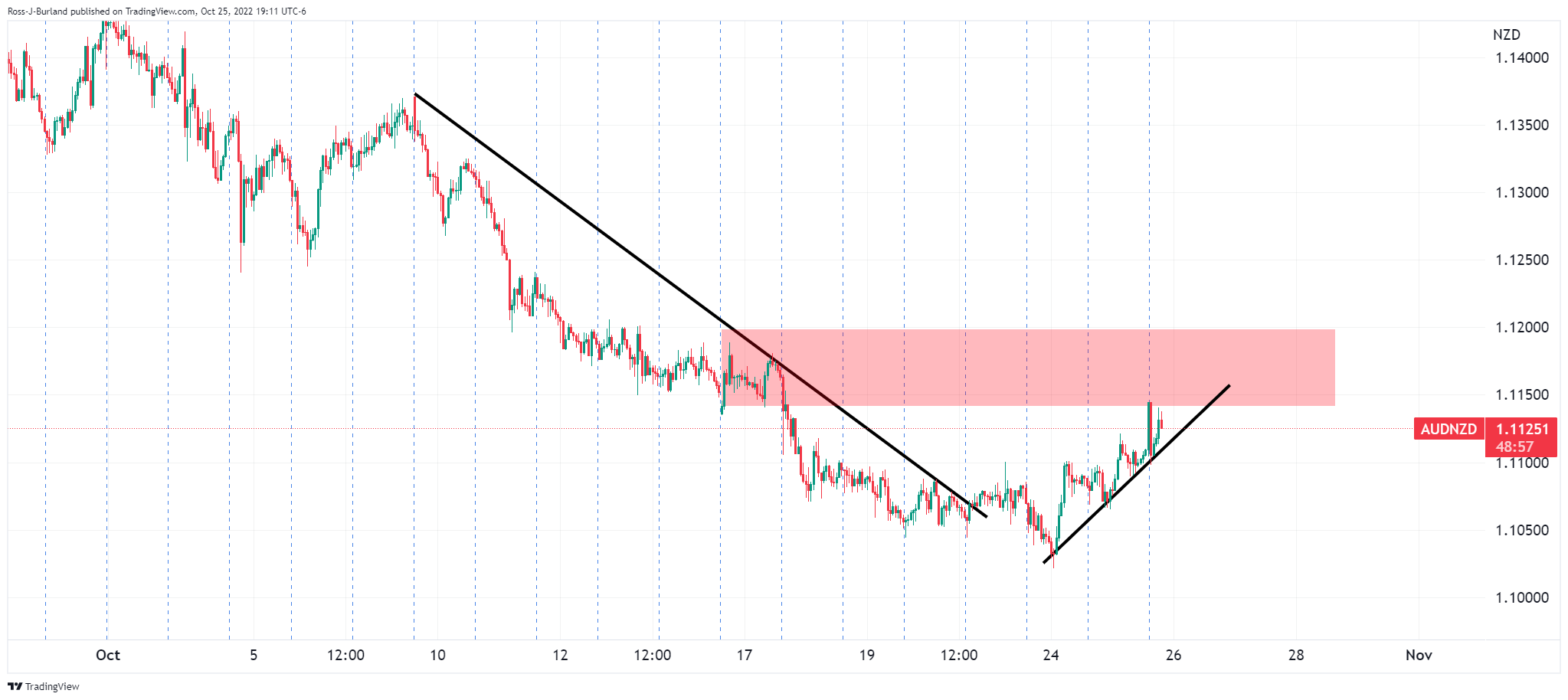
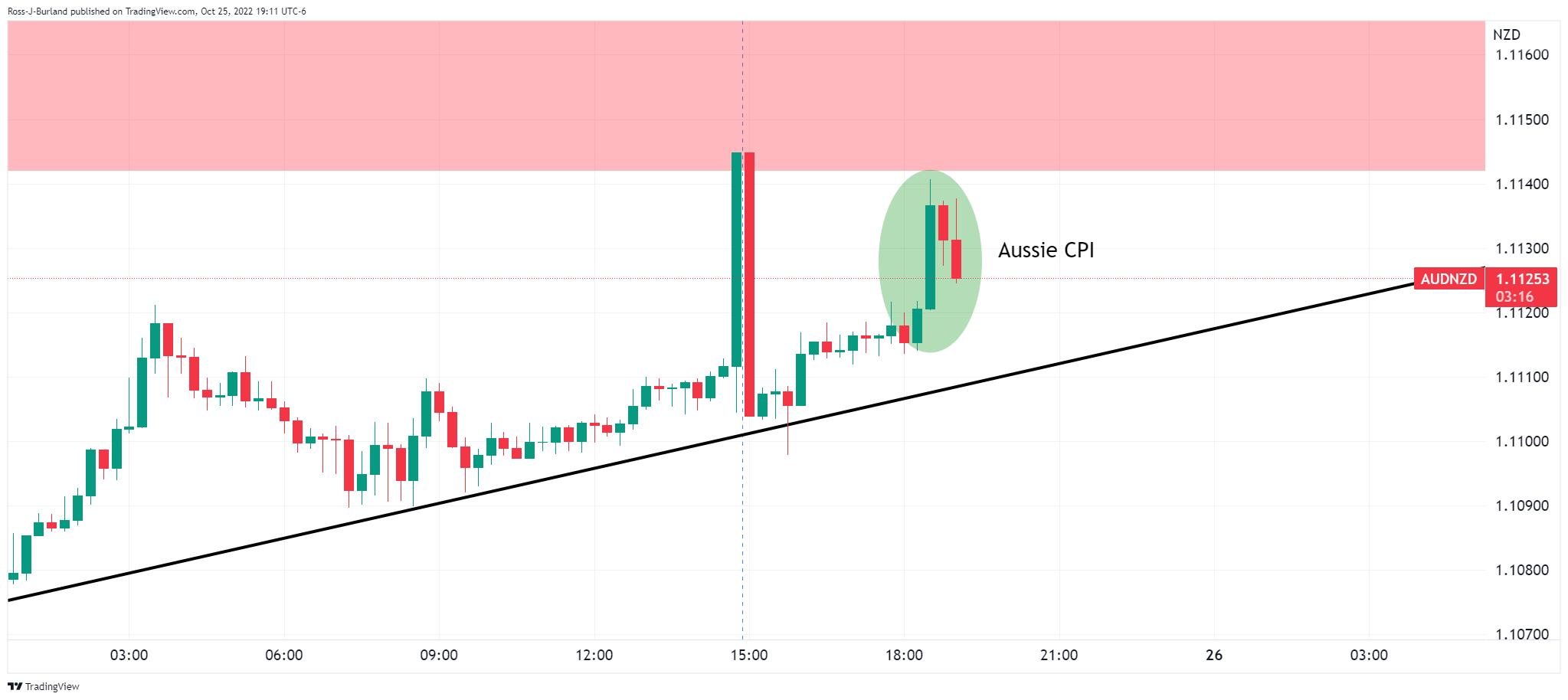
So long as the pair stays above the trendline, the price is destined higher beyond 1.1150 and 1.1180 eyed there after.
-
02:36
USD/JPY establishes above 148.00 as risk-off mood returns, BOJ policy hogs limelight
- USD/JPY has shifted its auction profile above 148.00 as the risk aversion theme has been underpinned.
- S&P500 futures have tumbled more than 1% on a decline in Microsoft’s sales growth forecasts.
- The BOJ may continue its ultra-dovish path to keep the economic prospects active.
The USD/JPY pair has comfortably shifted its business above the critical hurdle of 148.00 in the Asian session. The asset has witnessed a fresh demand at around 148.00 as the risk-off impulse has returned.
Investors’ risk appetite has been trimmed which has resulted in a steep fall in S&P500 futures. The 500-stock futures basket has tumbled 1.15% after a three-day buying spree as Microsoft (MSFT) has trimmed its sales growth forecast by 5%. Meanwhile, the US dollar index (DXY) has reclaimed the round-level hurdle of 111.00 amid an improvement in safe-haven’s appeal.
The alpha on US Treasury has recovered minutely but is still in a bearish trajectory. The 10-year US Treasury yields are hovering around 4.10% after rebounding from 4.05%.
On Wednesday, the US New Home Sales data will hog the limelight. The economic data is expected to decline to 0.585M vs. the prior release of 0.685M on a monthly basis. As interest rates are accelerating sharply, individuals have postponed their real estate demand due to higher interest obligations. However, the US Gross Domestic Product (GDP) data will remain the ultimate trigger for the mighty DXY. The annualized GDP is expected to improve significantly to 2.4% vs. a decline of 0.6% reported earlier.
It is worth noting that the responsiveness of a decline in the USD/JPY pair was observed lower than the decline in the DXY on Tuesday after the risk-on impulse heated. Therefore, a rebound move in the USD/JPY pair could be firmer than the DXY as the risk aversion theme is knocking markets.
On the Tokyo front, investors seek more clarity on the stealth intervention in the currency markets by the Bank of Japan (BOJ) to make informed positions. Along with that, Friday’s interest rate decision by the BOJ will keep the anxiety at best. Most likely, BOJ Governor Haruhiko Kuroda will leave the interest rates unchanged and will continue its dovish tone amid weaker demand.
-
02:33
USD/CNY fix: 7.1638 vs. the previous fix of 7.1668
In recent trade today, the People’s Bank of China (PBOC) set the yuan (CNY) at 7.1638 vs. the previous fix of 7.1668 and the previous close of 7.2652.
About the fix
China maintains strict control of the yuan’s rate on the mainland.
The onshore yuan (CNY) differs from the offshore one (CNH) in trading restrictions, this last one is not as tightly controlled.
Each morning, the People’s Bank of China (PBOC) sets a so-called daily midpoint fix, based on the yuan’s previous day's closing level and quotations taken from the inter-bank dealer.
-
02:05
AUD/JPY reverses gains sharply from 94.80, Australian inflation climbs to 7.3%
- AUD/JPY has surrendered its sheer move to 94.78 amid Australia’s steeper inflation impact.
- Australia’s headline CPI has touched a high of 7.3% vs. expectations of 7.0%.
- Going forward, BOJ’s monetary policy will be the key trigger.
The AUD/JPY pair has reversed its sharp move to an intraday high of 94.78 and has resulted in a selling tail in the Tokyo session after better-than-projected Australian Consumer Price Index (CPI) data.
The Australian Bureau of Statistics has reported the headline Consumer Price Index (CPI) for the third quarter of CY2022 at 7.3%, higher than the expectations of 7.0% and the prior release of 6.1% on an annual basis. Also, the quarterly inflation rate has landed in line with the former print of 1.8% and higher than the projections of 1.5%.
It is worth noting that the inflation rate has crossed the RBA’s projection of 7.0% provided in September’s monetary policy meeting. This has triggered a risk of further decline in economic projections as the Reserve Bank of Australia (RBA) will be required to return to its earlier 50 basis points (bps) rate hike spell.
In its October monetary policy meeting, RBA Governor Philip Lowe trimmed the extent of the rate hike to 25 bps in order to keep the spirits of economic prospects along with the fight against soaring inflationary pressures.
Meanwhile, the cross is still far from the knee-jerk reaction recorded on Monday at around 95.44. The suspected Bank of Japan (BOJ)’s intervention in the currency markets against disorderly moves impacting the Japanese yen has kept the market participants on the sidelines.
This week, the major event will be BOJ’s interest rate decision, which is due on Friday. Considering the demand shocks from the global economy, BOJ Governor Haruhiko Kuroda may prefer to continue a loose monetary policy.
-
01:41
AUD/USD climbs firmly to near 0.6400 on higher-than-projected Australian CPI at 7.3%
- AUD/USD has advanced to 0.6400 as Aussie headline CPI has landed at 7.3% vs. projections of 7.0%.
- The RBA would require returning to its 50 bps rate hike spell in absence of inflation exhaustion signals.
- A rebound in the risk-off impulse has pushed the DXY above 111.00.
The AUD/USD pair has jumped to 0.6400 as the Australian Bureau of Statistics has reported the headline Consumer Price Index (CPI) for the third quarter of CY2022 at 7.3%, higher than the expectations of 7.0% and the prior release of 6.1% on an annual basis. Also, the quarterly inflation rate has landed in line with the former print of 1.8% and higher than the projections of 1.5%.
This may force the Reserve Bank of Australia (RBA) to announce a bigger rate hike in the upcoming monetary policy. It is worth noting that the RBA hiked the Official Cash Rate (OCR) by 25 basis points (bps) to 2.6% in its October monetary policy meeting. RBA Governor Philip Lowe slowed down the pace of hiking rates in October as the central bank was banking upon a 50 bps rate hike spell earlier. Now, a bigger-than-projected rate hike will compel the RBA to return to a 50 bps rate hike spell
On Tuesday, the aussie bulls displayed a steep rise and defended China’s Jinping-infused pessimism. The unprecedented third term for China’s XI Jinping leadership dented the sentiment of investors favoring Chinese equities and other related assets. The antipodean was punished for being a leading trading partner of China, as Jinping’s ideology-driven approaches are not healthy for China’s economic prospects.
Meanwhile, the US dollar index (DXY) is displaying a pullback move and has crossed the 111.00 hurdle. The risk-on profile has witnessed a dent as S&P500 futures have witnessed a vertical fall after a three-day buying spree. This could be a correction in the 500-stock basket of the US after a firmer rally.
-
01:37
Breaking: Aussie CPI beats estimates, putting a bid into AUD/USD
Australia’s third quarter Consumer Price Index has put a bid into AUD/USD:
Aussie CPI
- Australia Q3 RBA trimmed mean CPI +1.8% QoQ (Reuters poll +1.5 pct).
- Australia Q3 CPI (all groups) +1.8 pct QoQ (Reuters poll +1.6 pct).
- Australia Q3 RBA weighted median CPI +1.4% QoQ (Reuters poll +1.5 pct).
- Australia Q3 RBA trimmed mean CPI +6.1% YoY (Reuters poll +5.6 pct).
- Australia Q3 RBA weighted median CPI +5 % YoY (Reuters poll +4.8 pct).
AUD/USD update

About Aussie CPI
The Consumer Price Index released by the RBA and republished by the Australian Bureau of Statistics is a measure of price movements by the comparison between the retail prices of a representative shopping basket of goods and services. The trimmed mean is calculated as the weighted mean of the central 70% of the quarterly price change distribution of all CPI components, with the annual rates based on compounded quarterly calculations.
-
01:31
Australia Consumer Price Index (QoQ) came in at 1.8%, above forecasts (1.5%) in 3Q
-
01:31
Australia RBA Trimmed Mean CPI (YoY) came in at 6.1%, above expectations (5.6%) in 3Q
-
01:31
USDCAD: The Loonie to fall towards 1.3500, as the Bank of Canada prepares to lift rates 75 bps
- Improvement in risk appetite due to speculations of a Fed pivot weakened the US Dollar.
- Worse-than-expected US economic data, namely consumer confidence, and housing data are headwinds for the USD, bolstering the CAD.
- The Bank of Canada is expected to hike 75 bps, but if it goes 50 bps, the USDCAD can rally towards 1.3700.
- If the USDCAD is neutral-to-upward biased, but a break below 1.3600 will send the pair towards 1.3500.
The US Dollar recovers some ground as Wednesday’s Asian Pacific session begins, following Tuesday’s trading session, characterized by risk appetite increasing as shown by US equities registering gains due to investors speculating that a Federal Reserve’s pivot is imminent, while the US Dollar weakened. Contrarily, the Canadian dollar was underpinned by expectations of the Bank of Canada’s (BoC) lifting interest rates by 75 bps at its monetary policy decision. Hence the USD/CAD is trading at 1.3626, above its opening price by 0.16%.
The US Dollar gets battered on risk-on mood, weaker consumer confidence, and falling US home prices
Besides US corporate earnings beating previous quarter reports, the US Dollar was hit by weaker-than-expected economic data. The Conference Board (CB) reported October’s Consumer Confidence, which ebbed due to increasing worries about inflation and a possible recession in the United States. The index fell to 102.5 from 107.8 in September and missed street analysts’ forecasts of 106.5. The USDCAD dived in the release, from around 1.3700, toward the 1.3620 area, as consumer confidence data added to weaker US housing market figures, revealed earlier.
The United States calendar revealed that the US housing market continues to cool down, weighed by the Federal Reserve’s monetary policy stance. The S&P CoreLogic Case-Shiller Index reported that prices in 20 large US cities tumbled 1.3% MoM in August, the most since March 2009. At the same time, the Federal Housing Finance Agence (FHFA), in a separate report, flashed that house prices rose by 11.9% YoY in August, though trailed by July’s 13.9% increases.
US Treasury yields dropped, weakening the USD and boosting the CAD
Meanwhile, US bonds rallied, which weighed on US Treasury bond yields. The US 10-year benchmark note rate plunged fourteen bps from around 4.22% toward 4.08%, weakening the greenback, as shown by the US Dollar Index (DXY). The DXY lost almost 1% on Tuesday, capitalized by Canadian dollar buyers, which extended the USDCAD losses toward its daily low of 1.3601.
The Bank of Canada is expected to hike 75 bps the bank rate
Aside from this, the Bank of Canada (BoC) monetary policy meeting looming bolstered the CAD. Given that the last BoC Consumer Survey showed that business sentiment softened and price pressures eased, inflation expectations remained high, as shown by the poll. Also, the Canadian Consumer Price Index (CPI) for September, a measure for inflation, rose by 6.9% YoY, above estimates of 6.8%, though lower than August’s 7.0%, justifying the need for higher interest-rate hikes by the BoC.
In Wednesday, the Canadian economic docket will feature the Bank of Canada’s monetary policy decision. On the US front, additional housing data, with September’s Building Permits, and New Home Sales, would add further downward pressure on the USD, which could be positive for the CAD.
USDCAD price forecast
The USDCAD is neutral-to-upward biased, as shown by the daily chart. On Tuesday, the Loonie strengthened vs. the US Dollar as the exchange rate slumped below the 20-day Exponential Moving Average (EMA), hitting a fresh three-week low at 1.3600. Although the USD recovered some ground, it remains vulnerable to selling pressure, as the Relative Strength Index (RSI) at 50.43 extended its fall, aiming towards the bearish territory. That could mean sellers are gathering enough momentum to push the USDCAD towards the 1.3500 figure.
Key support levels lie at 1.3600, followed by the October 6 daily low at 1.3564, ahead of the 1.3500 figure. On the flip side, the USDCAD’s first resistance would be the 1.3700 mark, followed by the 20-day EMA at 1.3715 and October’s 25 high at 1.3747.
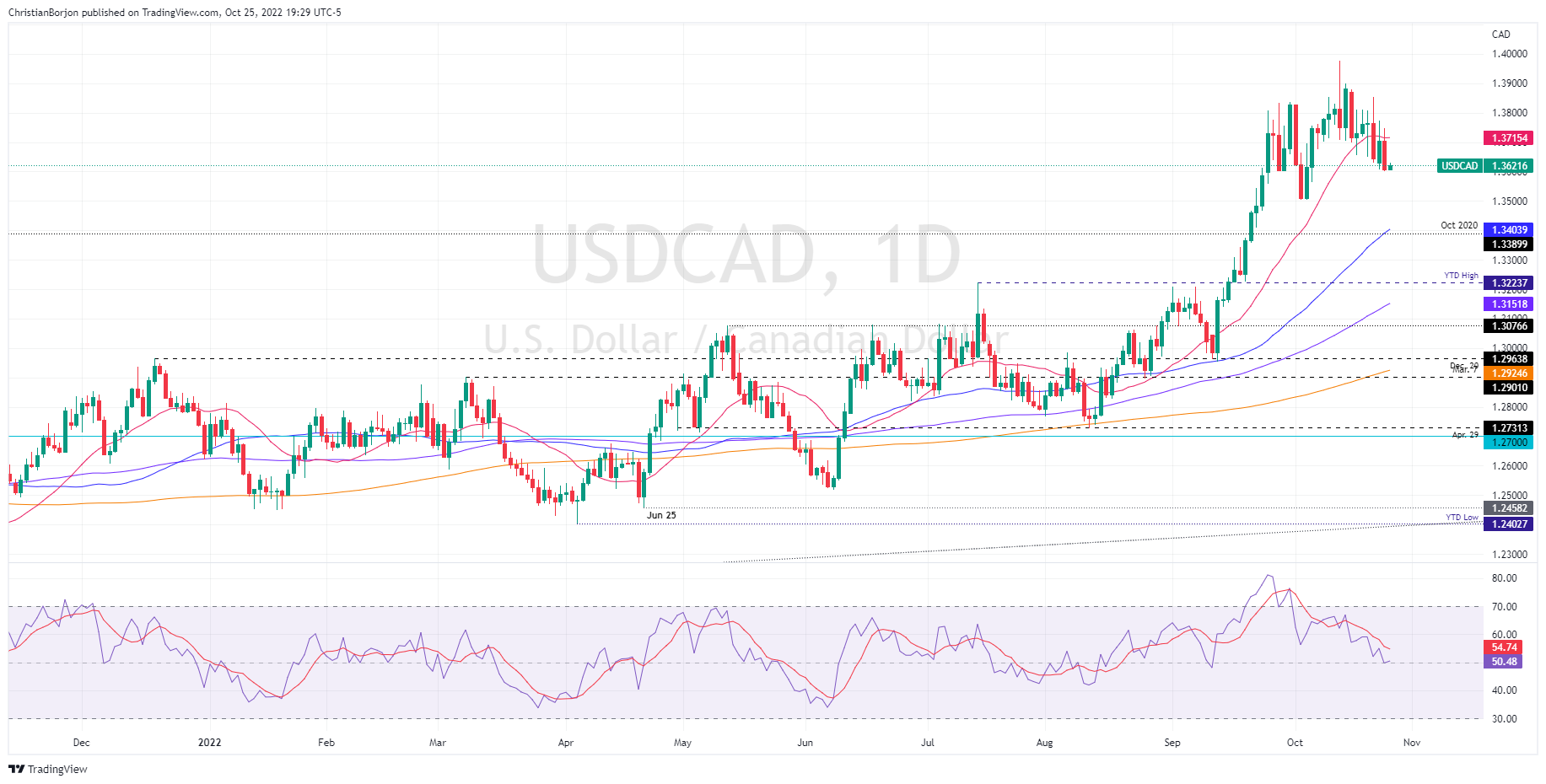
-
01:30
Australia RBA Trimmed Mean CPI (QoQ) above expectations (1.5%) in 3Q: Actual (1.8%)
-
01:30
Australia Consumer Price Index (YoY) registered at 7.3% above expectations (7%) in 3Q
-
01:30
Stocks. Daily history for Tuesday, October 25, 2022
Index Change, points Closed Change, % NIKKEI 225 275.38 27250.28 1.02 Hang Seng -15.1 15165.59 -0.1 KOSPI -1.09 2235.07 -0.05 ASX 200 19.2 6798.6 0.28 FTSE 100 -0.52 7013.48 -0.01 DAX 121.51 13052.96 0.94 CAC 40 119.19 6250.55 1.94 Dow Jones 337.12 31836.74 1.07 S&P 500 61.77 3859.11 1.63 NASDAQ Composite 246.5 11199.12 2.25 -
01:29
Yellen respects Japan's stance of not disclosing fact of fx intervention
Reuters reported that the US Treasury Secretary Janet Yellen respects Japan's stance of not disclosing whether it had intervened in the foreign exchange market, Japan's top currency diplomat said on Wednesday, adding he was in close touch with the United States every day.
"We will monitor the market to see if there are any excessive, disorderly moves and will continue to take decisive steps as needed," Vice Finance Minister of International Affairs Masato Kanda told reporters at the ministry.
-
01:15
Currencies. Daily history for Tuesday, October 25, 2022
Pare Closed Change, % AUDUSD 0.63882 1.23 EURJPY 147.502 0.2 EURUSD 0.99655 0.93 GBPJPY 169.742 0.94 GBPUSD 1.14669 1.66 NZDUSD 0.57452 0.99 USDCAD 1.36099 -0.73 USDCHF 0.99467 -0.57 USDJPY 148.005 -0.73 -
01:06
GBP/USD Price Analysis: Test of a triangle breakout near 1.1400 to offer a bargain buy
- A breakout of a triangle pattern is generally validated with a test of the breakout zone.
- An establishment of the cable above the 50-and 200-EMAs adds to the upside filters.
- The RSI (14) has shifted into the bullish range of 60.00-80.00.
The GBP/USD pair is displaying back-and-forth moves around 1.1450 in the Tokyo session. The cable has turned sideways after a sheer rally amid an upbeat market mood. A three-day buying spree in S&P500 indicates that the risk appetite of investors has accelerated.
Meanwhile, the US dollar index (DXY) is facing the heat and has dropped below the round-level cushion of 111.00. Also, the 10-year US Treasury yields have nosedived to 4.09%.
On a four-hour scale, pound bulls are on an adrenaline rush after a breakout of the symmetrical triangle chart pattern. The upward-sloping trendline of the chart pattern is placed from October 12 low at 1.0924 while the downward-sloping trendline is plotted from October 5 high at 1.1496. The asset is required to test the breakout area around 1.1400 for a breakout validation.
The cable has climbed above the 50-and 200-period Exponential Moving Averages (EMAs) at 1.1283 and 1.1309 respectively, which indicates that the trend has shifted towards the north.
Also, the Relative Strength Index (RSI) (14) has shifted into the bullish range of 60.00-80.00, which indicates more gains ahead.
Going forward, a test of triangle breakout at around 1.1400 will offer a bargain buy to investors. This will drive the cable towards October 17 high at 1.1440 followed by September 14 high at 1.1590.
On the flip side, a drop below Friday’s low at 1.1060 will drag the asset toward the psychological support of 1.1000. If cable surrenders the psychological support, it will expose to more downside towards October 12 low at 1.0924.
GBP/USD four-hour chart

-
01:00
New Zealand ANZ Activity Outlook came in at -2.5%, above expectations (-2.9%) in October
-
01:00
New Zealand ANZ Business Confidence below expectations (-42) in October: Actual (-42.7)
-
00:59
When is Aussie CPI and how might AUD/USD be affected?
Australia’s third quarter Consumer Price Index will be released at the top of the hour, 00.30 GMT, whereby food, dwellings, electricity and domestic holidays are expected to continue driving headline inflation higher, though various state government energy rebates should provide an offset, the extent of which is highly uncertain, as analysts at Westpac argued.
Hence, Westpac anticipates 1.1% and 1.5% rises for the headline and trimmed mean CPI measures, respectively (market forecast: 1.6% and 1.5% respectively), taking the headline’s annual pace to 6.5% (market 7.0%).
Meanwhile, analysts at TD Securities expect a more dovish headline CPI print due to the significant offset from the rebates and lower pump prices. ''However, trimmed-mean CPI may stay elevated at 1.6% QoQ as broader price pressures are still brewing, especially in the housing and food categories. Unless trimmed-mean inflation is strongly higher, we expect the Bank to stick with 25bps hikes until March 2023.''
How might AUD/USD react?
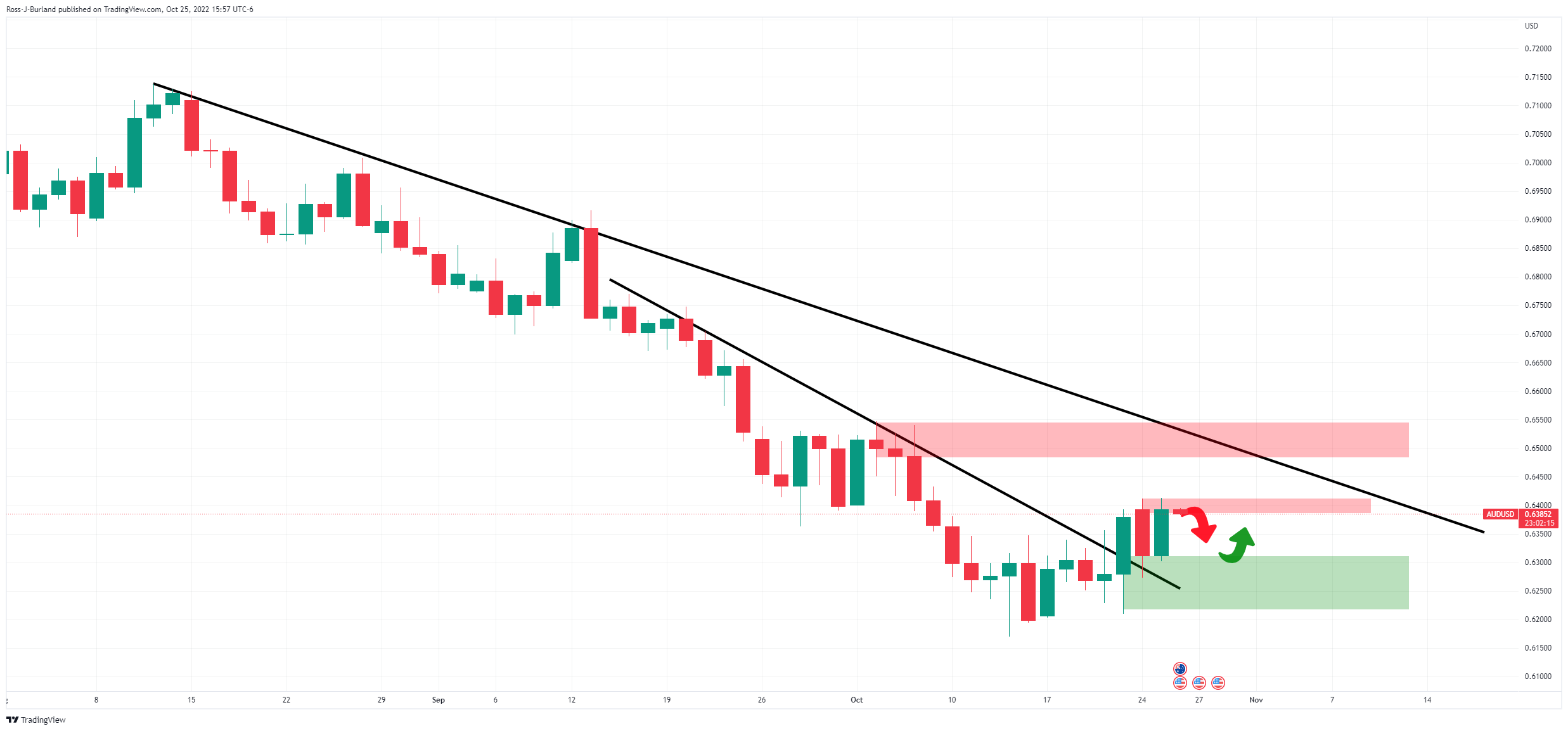
The sentiment around the Federal Reserve monetary tightening and the policy direction of top trading partner China after President Xi Jinping have seen a lot of volatility in the price with the ATR picking up to over 100 pips for any given day. Therefore we could see some heightened volatility.
If the data comes in hot, given that the Reserve Bank of Australia only delivered a smaller-than-expected 25 basis point rate hike earlier this month, then there could be prospects of stronger action next time around that will only feed into the bullish AUD playbook.
The daily chart is neutral with both the upside and downside to play for at this juncture. However, the double top on the hourly chart shows the price under pressure:
AUD/USD H1 chart
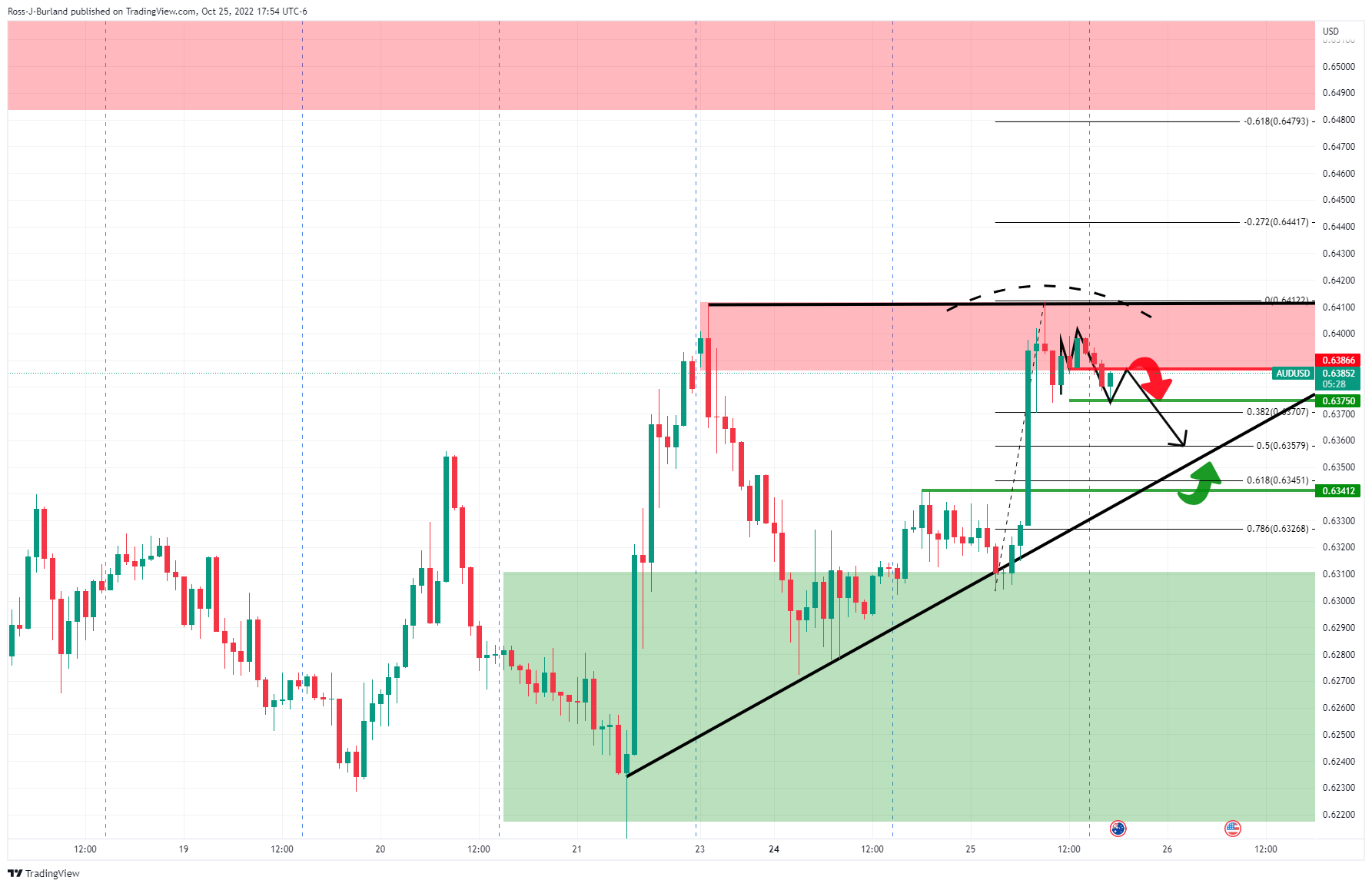
The price is coiling within a geometrical pattern and is forming an M-top with prospects of a move into mitigating the price imbalance of the hourly impulse towards trendline support.About Aussie CPI
The Consumer Price Index released by the RBA and republished by the Australian Bureau of Statistics is a measure of price movements by the comparison between the retail prices of a representative shopping basket of goods and services. The trimmed mean is calculated as the weighted mean of the central 70% of the quarterly price change distribution of all CPI components, with the annual rates based on compounded quarterly calculations.
-
00:38
EUR/JPY approaches 148.00 despite BOJ’s stealth intervention, ECB/BOJ policy grabs focus
- EUR/JPY is aiming to recapture the 148.00 hurdle despite BOJ’s stealth intervention.
- To address external demand shocks, the BOJ could continue its ultra-dovish policy.
- Even an ECB’s 75 bps rate hike could fail to offer substantial support to Euro.
The EUR/JPY pair is gradually marching towards the immediate resistance of 148.00 in the early Tokyo session. The asset has overstepped the low-impact hurdle of 147.40 and is scaling more highs despite the headwinds of the Bank of Japan (BOJ)’s stealth intervention in the currency markets amid one-sided speculative moves against the Japanese yen.
The risk profile is extremely cheerful as S&P500 has recorded significant gains consecutively for the past three trading sessions. It is worth noting that the cross has crossed the knee-jerk reaction recorded from 147.40 on Monday to near 143.72. On Monday, Analysts at National Australia Bank (NAB) in Sydney cited that “It’s blindingly obvious that the BOJ is intervening,” Therefore, the knee-jerk reaction recorded on Monday could be the result of BOJ’s intervention in the currency markets.
Going forward, investors are shifting their focus toward the interest rate decision by the BOJ. Considering the external demand shocks, BOJ Governor Haruhiko Kuroda would continue with an ultra-loose monetary policy to spurt the growth prospects. Also, Japanese officials are worried that the inflation rate could return below 2% again, therefore, keeping policy extremely loose is an optimal option.
On the Eurozone front, the European Central Bank (ECB) is set to announce a second consecutive 75 basis point (bps) rate hike, as per analysts at Rabobank. Projections of a 75 bps rate hike have also been approved by Economists at ING. In addition to that, they believe that the hike should fail to offer substantial and long-lasting support to the euro.
Talking on the European energy crisis, Germany’s Economy Minister Robert Habeck said on Tuesday that they “expect the gas price mechanism decision at the next EU Council.” He further added that “Joint EU purchases are the best way to keep the gas price low,”
-
00:10
United States API Weekly Crude Oil Stock rose from previous -1.27M to 4.52M in October 21
-
00:05
USD/CHF Price Analysis: Plays around H&S’s neckline at 0.9930, more downside looks likely
- An H&S formation indicates that a bearish reversal is on its way.
- A death cross by the 50-and 200-EMA may strengthen the odds of a bearish reversal.
- The RSI (14) has shifted into the bearish range of 20.00-40.00, which adds to the downside filters.
The USD/CHF pair is hovering around the immediate support of 0.9940 in the early Tokyo session. Earlier, the asset witnessed a steep decline after surrendering the psychological support of 1.0000. Rising optimism in market spirit resulted in a significant decline in safe-haven’s appeal.
The US dollar index (DXY) is oscillating below the crucial hurdle of 111.00 while the 10-year US Treasury yields nosedived to 4.10% amid an improved risk profile.
On an hourly scale, the asset has formed a Head and Shoulder (H&S) chart pattern, which indicates a bearish reversal after a downside break of the neckline placed near 0.9930. The chart pattern illustrates a tad longer inventory adjustment in which inventory shifts from institutional investors to retail participants.
The 50-and 200-period Exponential Moving Averages (EMAs) are on the verge of delivering a death cross at around 1.0000, which will add to the downside filters.
Also, the Relative Strength Index (RSI) (14) has shifted into the bearish range of 20.00-40.00, which indicates more weakness ahead.
Should the asset drops below the previous week’s low at 0.9922, the Swiss franc bulls will get stronger and will push the major to the downside towards October 7 low at 0.9878, followed by October 3 low at 0.9832.
On the contrary, the greenback bulls could regain strength if the asset Monday’s high at 1.0007, which will send the major toward October 13 high at 1.0074. A breach of the latter will send the asset toward Friday’s high at 1.0148.
USD/CHF hourly chart
-638023358402803396.png)
-